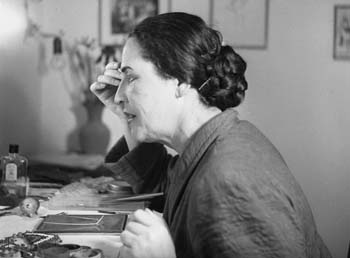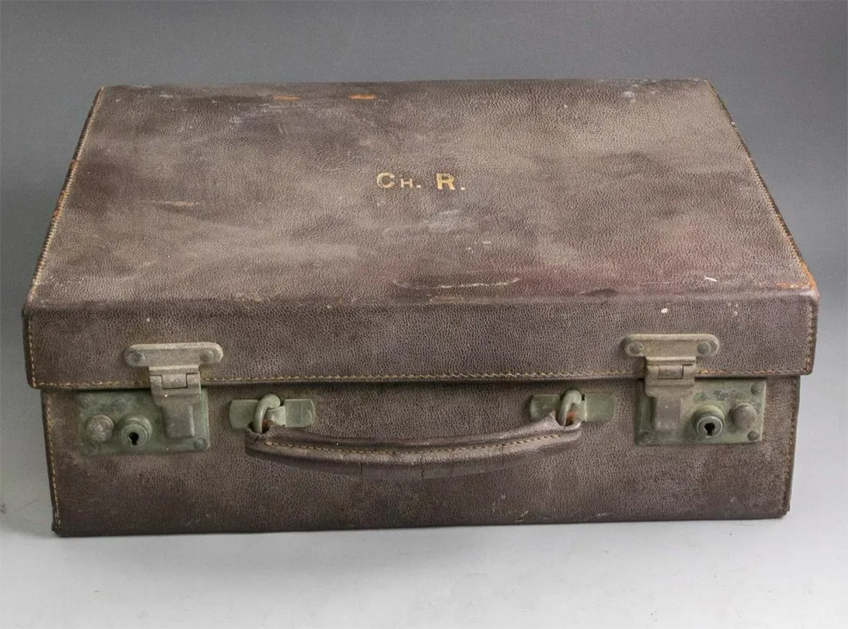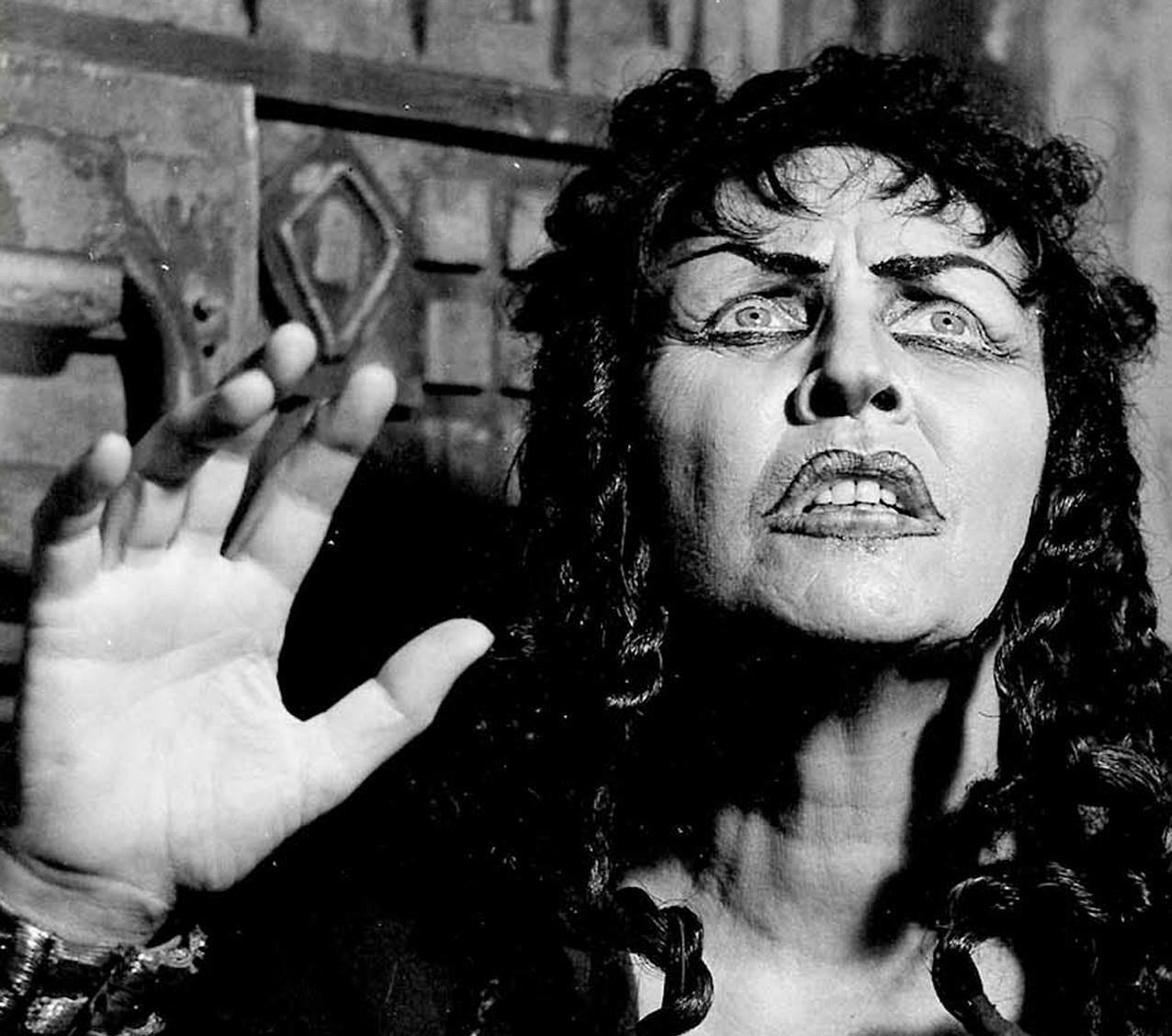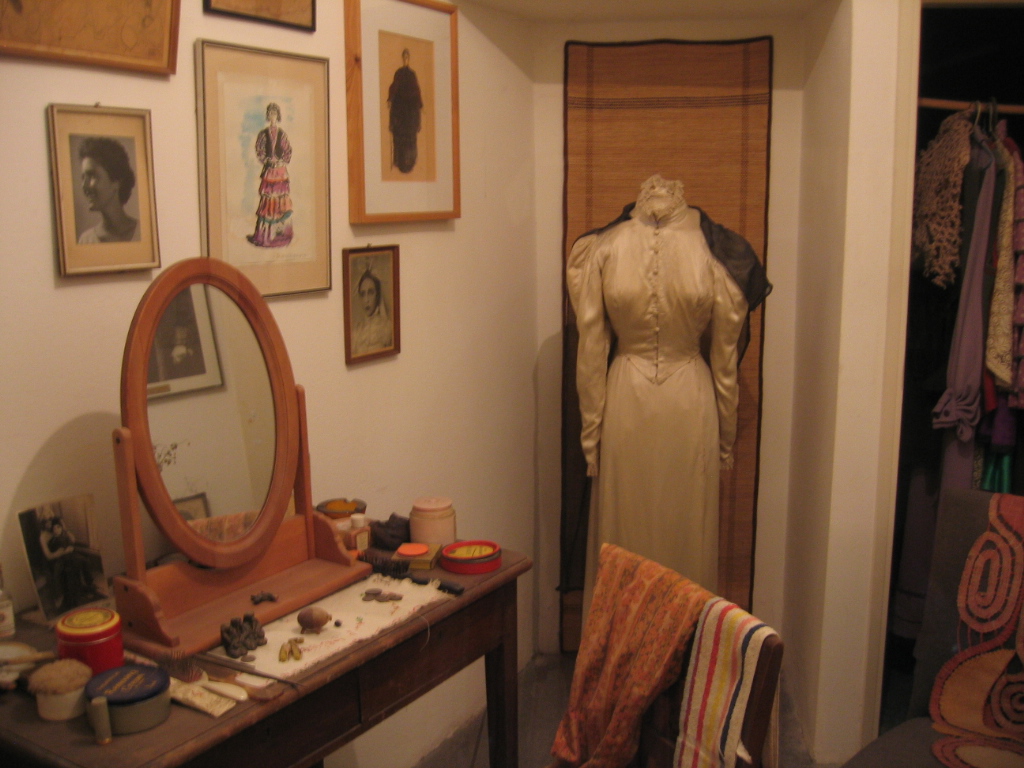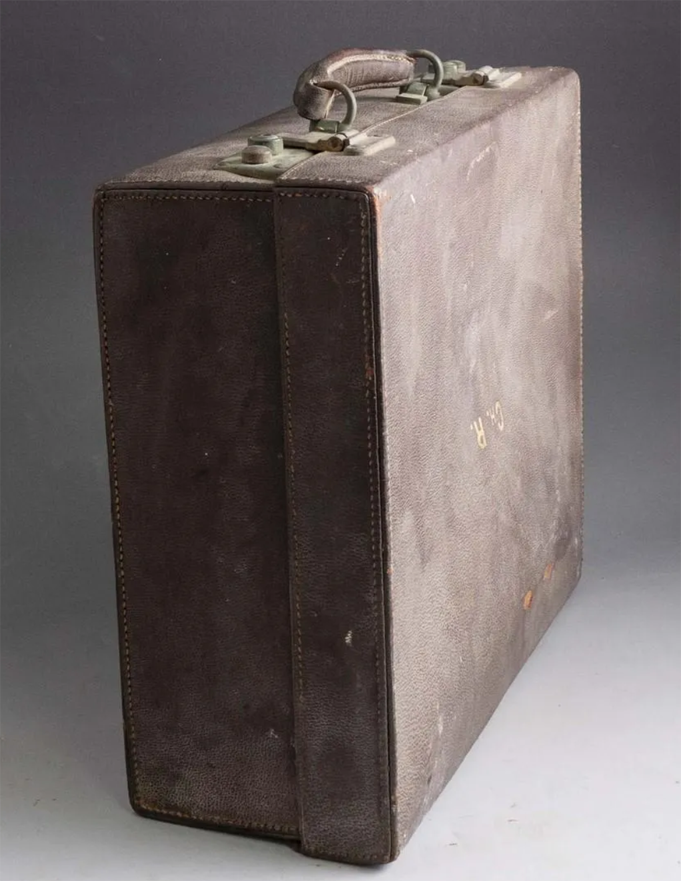This post has been in the making for literally years. I finally conceded that I couldn't find a complete history of either Benefit's Glamourette compact, released in 2002, or the vintage compact it was based on, House of Platé's Trio-ette (ca. 1944-1947). But I did turn up a few nuggets of information, so figured I'd share the little bit that was readily available.
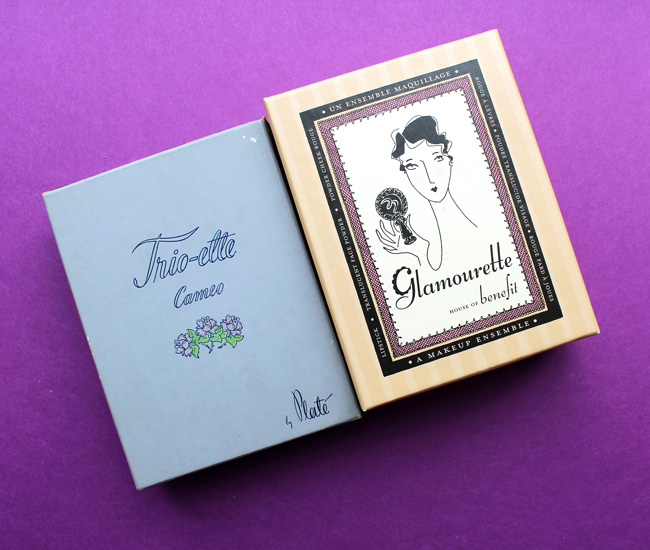
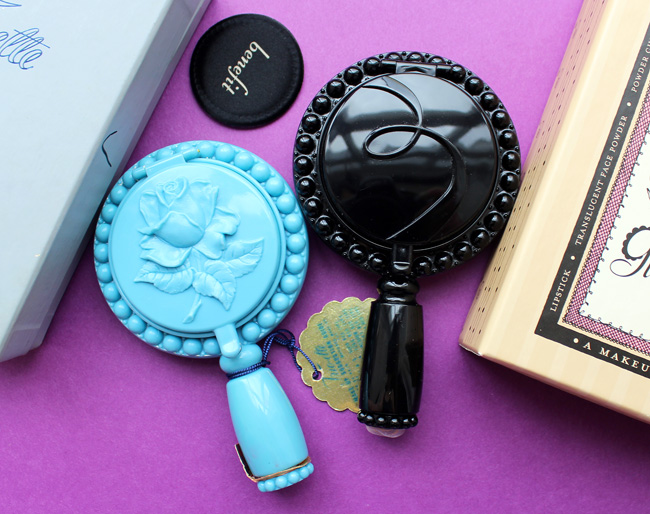
The House of Platé company was established in 1944 by Robert T. Plate in Detroit. From what I was able to piece together from various archives, it seems Plate was born in 1897 in Lima, Ohio and received a Bachelor's degree in mechanical engineering from the University of Michigan in 1923. Specializing in automobile design, his first job was draftsman for the Willys-Overland Company in Toledo. Beginning in 1932 Plate worked for General Motors, and in 1938 he was doing business as the Plate Manufacturing Company. In 1945 he trademarked the Trio-ette compact under Curly Lox Products. The biggest mystery for me is why Plate decided to market cosmetics. I'm assuming it was a side hustle to earn a little extra cash, or maybe he thought he could become the next Max Factor. (As a side note, Plate moved quite frequently throughout his life, bouncing around from Ohio to Michigan to New York to LA…if it's the same Robert T. Plate, I'm not sure whether he was trying to help his business take off across the country or moving for engineering jobs.)
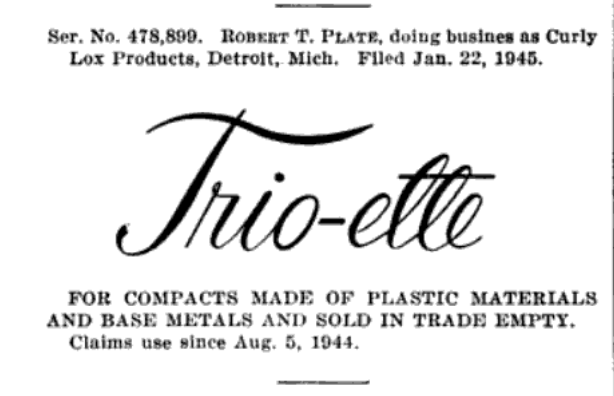
The design of the compact was based on a "quaint Victorian rose cameo hand mirror" according to one ad. This one is reproduced in Roselyn Gerson's book Vintage and Vogue Ladies' Compacts (2nd edition).
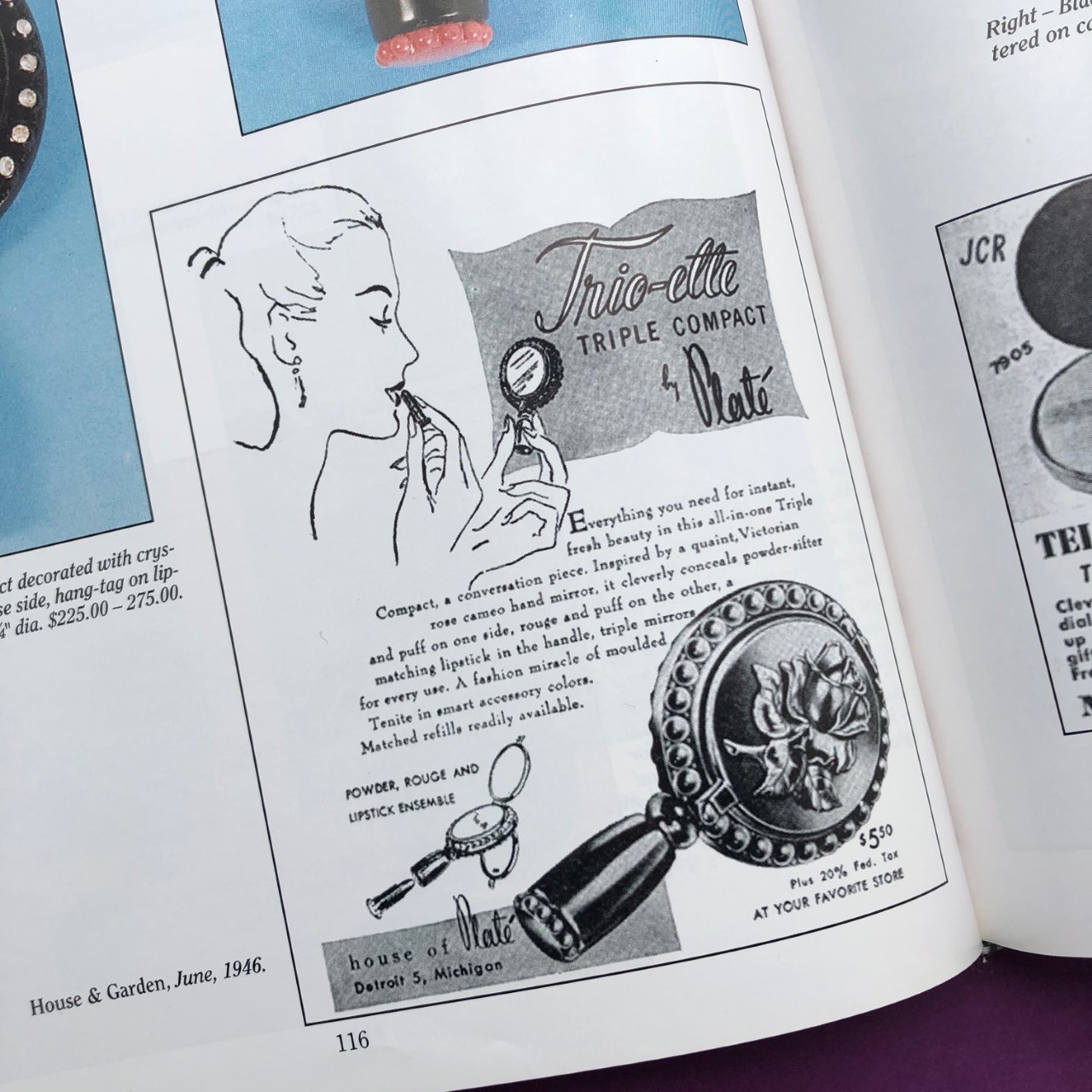
It's really fascinating to see how a mechanical engineer who designed cars approached makeup. Compacts with powder, rouge and lipstick had existed for years, but few had the novelty and charm of the Trio-ette's design. (However, one can definitely tell an engineer also thought of the rather unimaginative House of Platé name. I guess Plate thought adding an accent over the "e" would make it sound vaguely French and therefore instantly appealing.) I'm so disappointed that I wasn't able to find patent drawings despite having the serial number. But maybe the trademark is different than patenting the actual design.
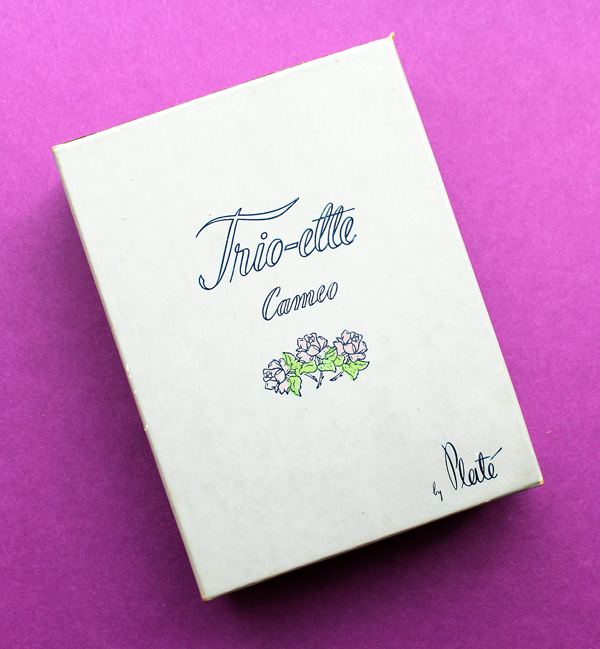
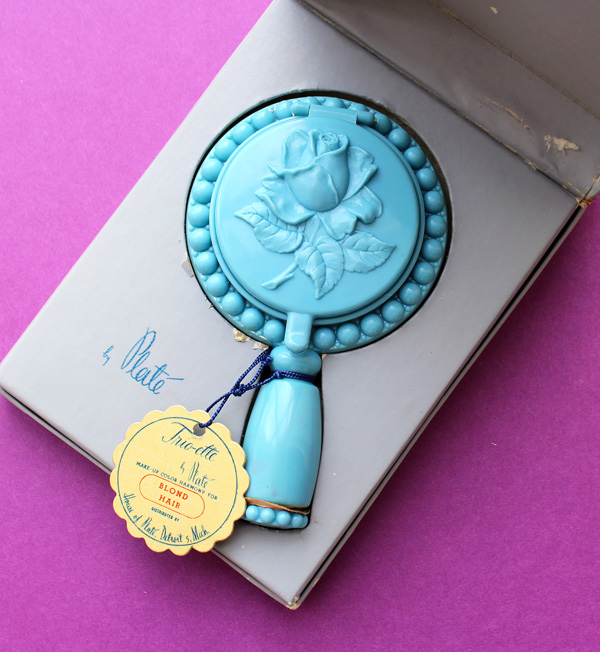
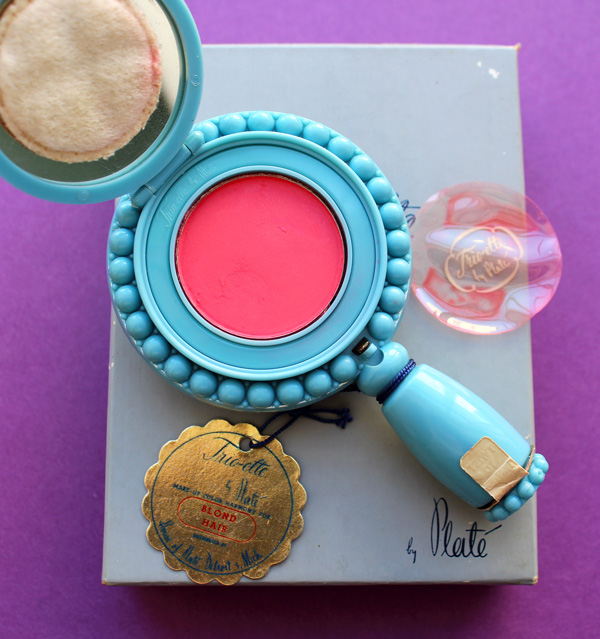
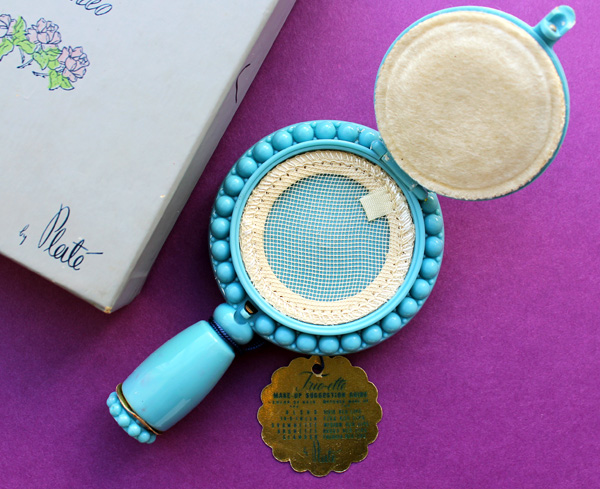
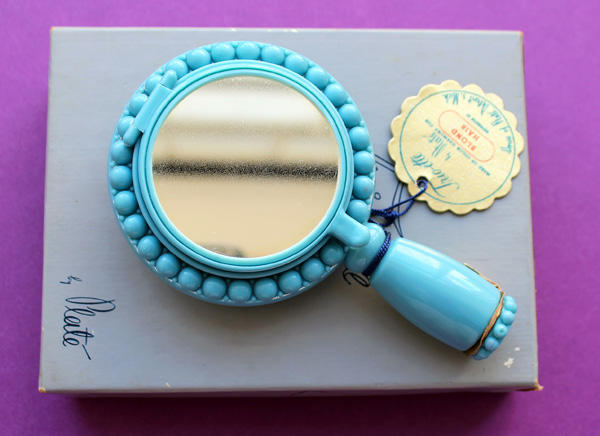
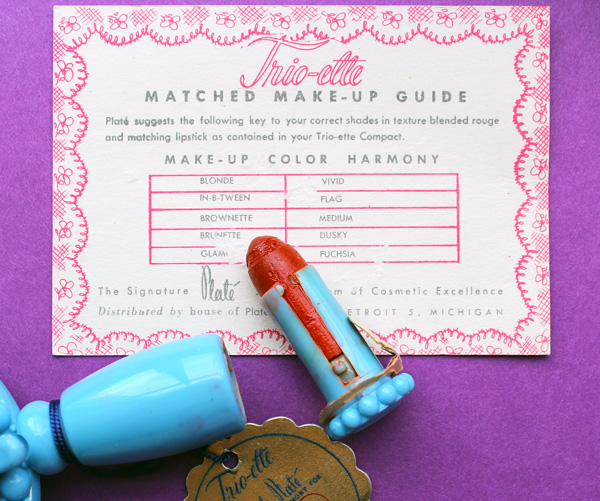
The name on the handle is such a sweet little detail.
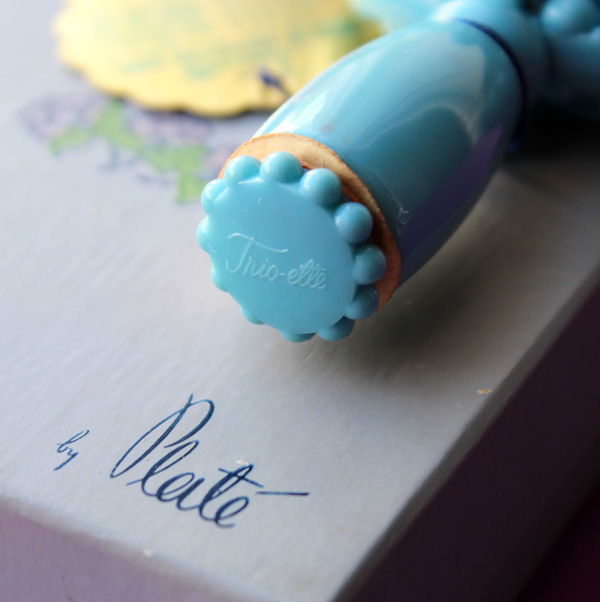
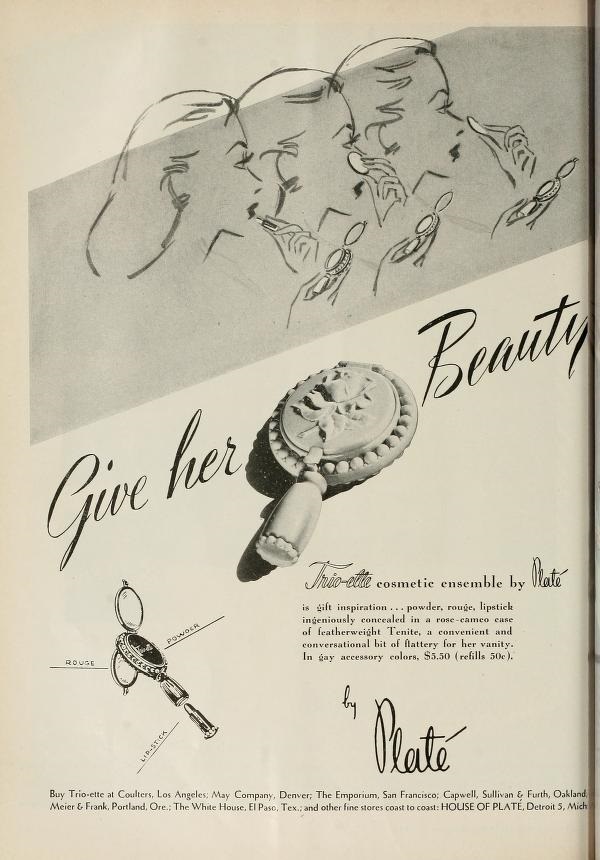
(image from archive.org)
As the Trio-ette was conceived and launched during WWII, it was made of plastic, specifically tenite, instead of metal. Tenite apparently is the trade name for a cellulosic plastic created by Eastman Chemicals in 1929. (I wish I knew the difference between tenite, bakelite, and celluloid. Alas, I have no clue.) The Trio-ette was also refillable. This snippet from Drug and Cosmetic Industry shows the refill kit, but the really interesting thing about this blurb is that the journal was not falling for the Trio-ette's hype, claiming it was nothing more than a "gadget" and citing the more "streamlined" designs from established big-name brands. It's true: companies had been making triple compacts for a good 20 years by that point.
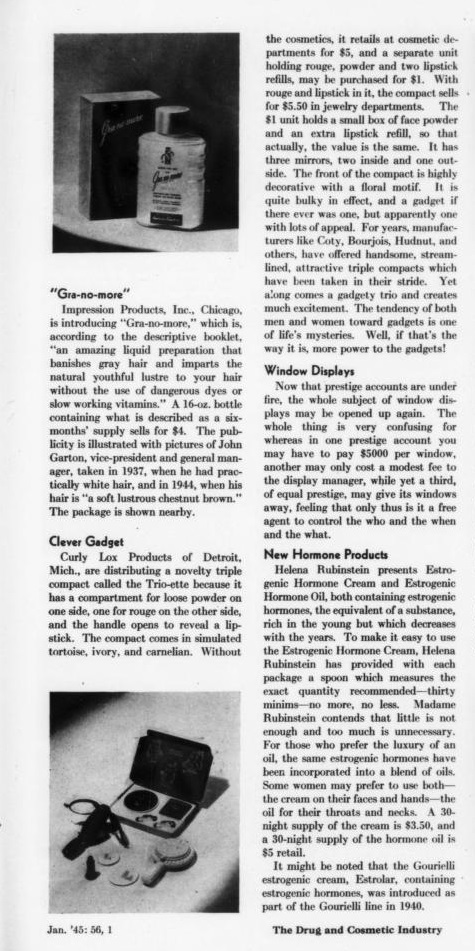
(image from archive.org)
Whether it was a novelty or a truly handy compact to carry, the Trio-ette seemed popular, or at least, it was readily available across the entire country in department stores as well as drugstores. Plate, though not a businessman by trade, understood the importance of advertising. In late 1945 he hired NY-based firm Norman D. Waters and Associates to oversee a national campaign they would launch early the following year. The Trio-ette allegedly reduced "bag fumbling" and "makeup fatigue".
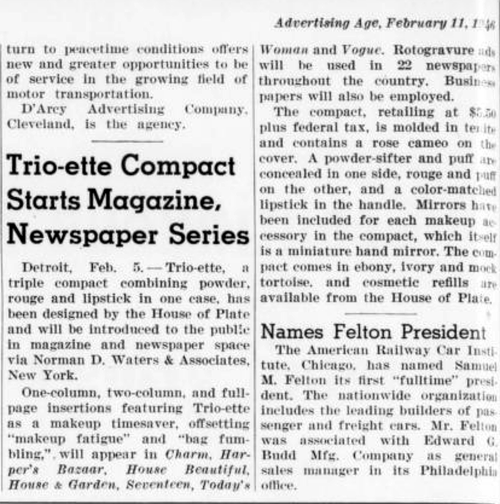
As with lipstick mirrors, it was considered a social faux pas to be digging through one's purse to look for your makeup, mostly because it was a potential inconvenience for men. Ladies, with the Trio-ette he won't mind waiting for you to touch up since it won't take long at all – all your makeup is in one place so you won't waste his time searching for it. *eyeroll* These ads certainly paint a picture of gender norms, don't they?
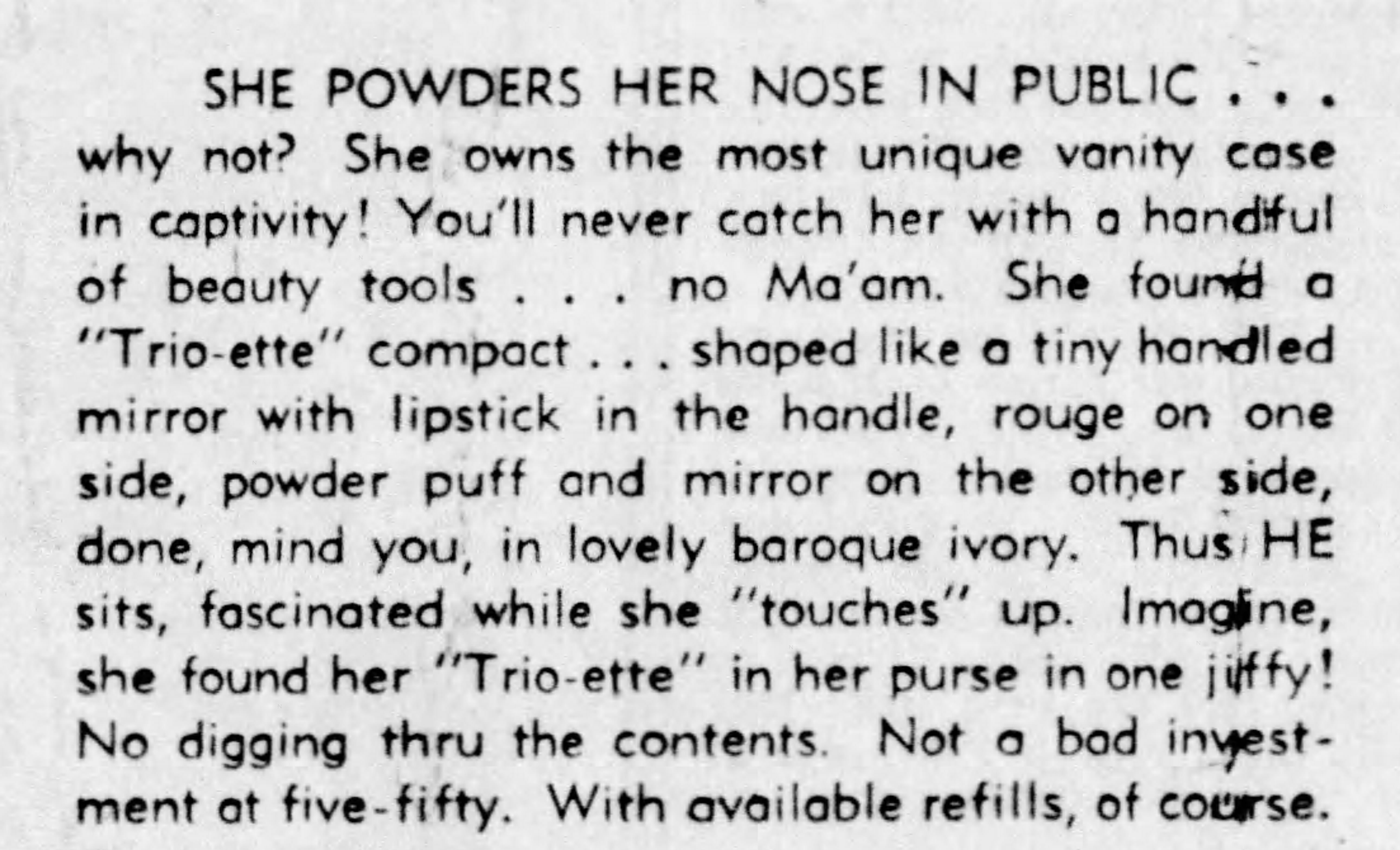
There were other products from House of Platé, including a double-ended lipstick called the Duo-ette and the Vista, a lipstick with a built-in mirror (again, you can see my post on those.)
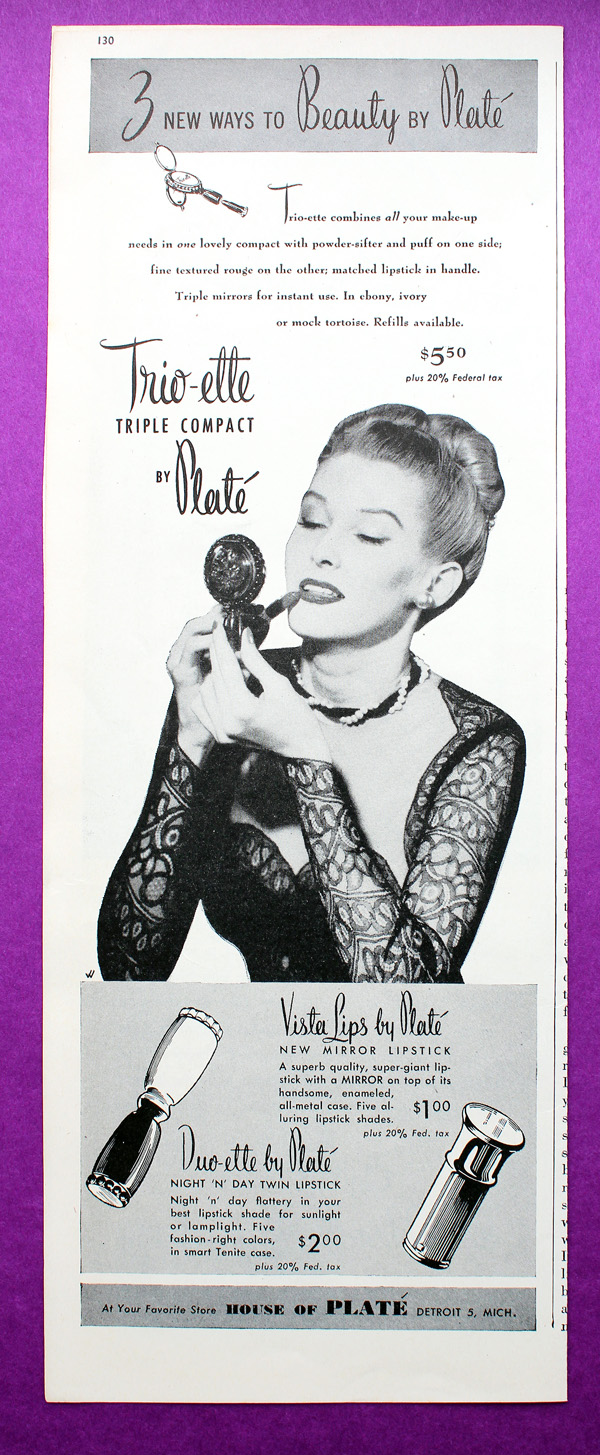
The Trio-ette came in a variety of colors as well as black ones with a pink rose or a rhinestone border. According to collector's guides, the most valuable colors are blue, pink and green. Personally, while I love all the shades, my most-wanted would be the rhinestone version followed by the green and mock tortoiseshell.
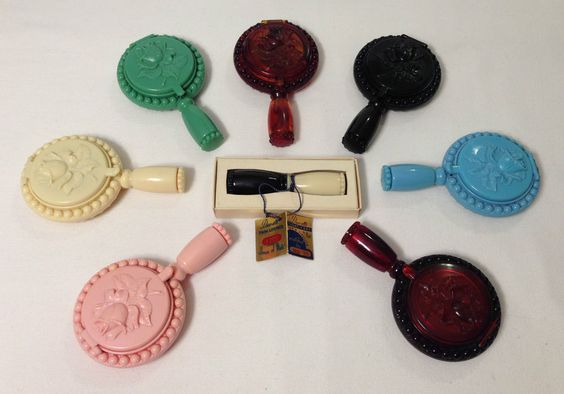
(image from pinterest)
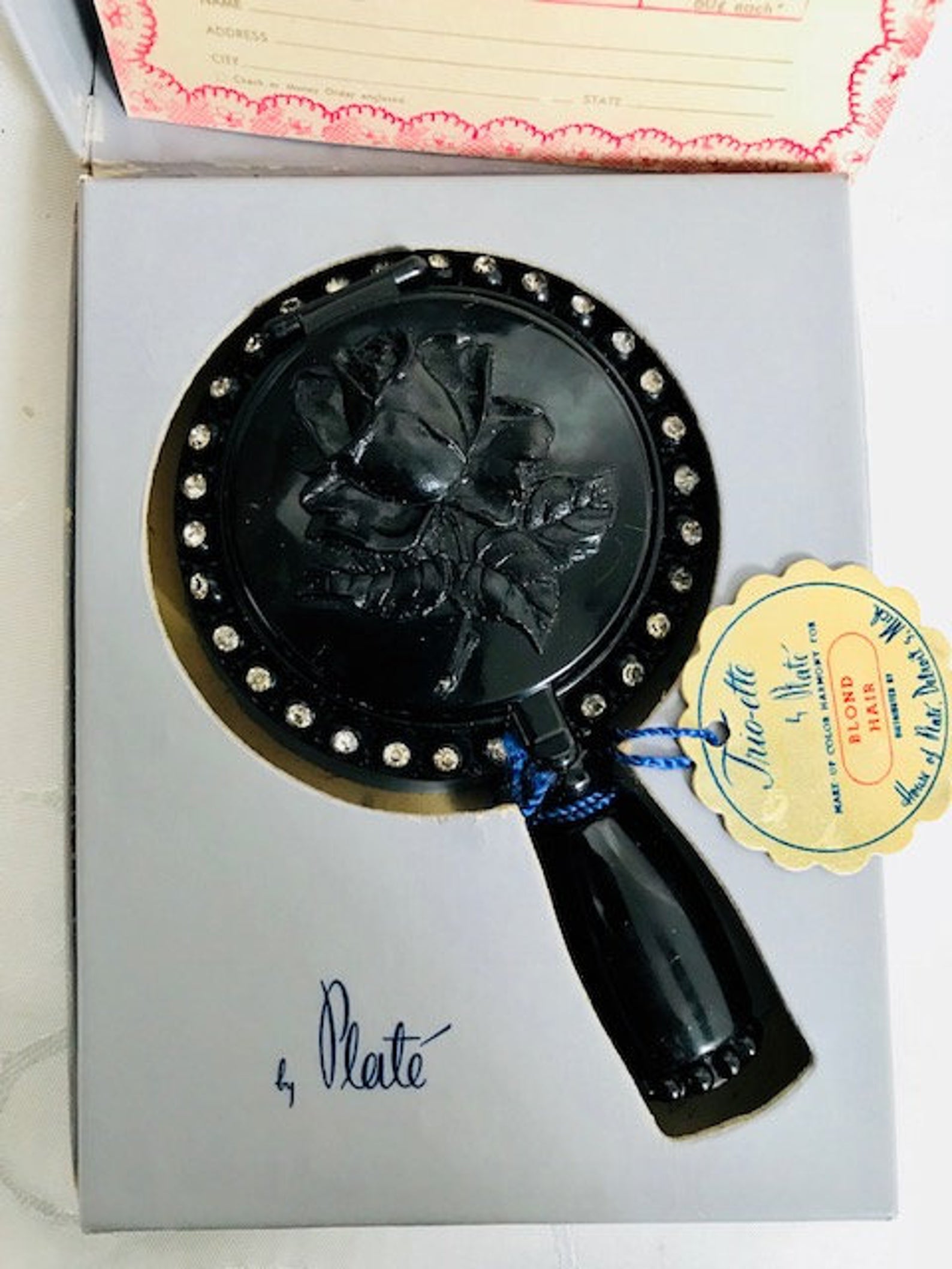
(image from etsy.com)
The Trio-ette was quite short-lived. I'm not sure why exactly; it could be that Plate had run into a trademark issue with Curly Lox, or maybe after the war a return to metal compacts was all the rage and plastic fell out of favor. Or it could also be that a copycat was released around the same time. In the UK, a company named Jason released a nearly identical compact in late 1947. The only difference I can see besides the name is that the front of the compact is plain instead of bearing a sculpted rose.
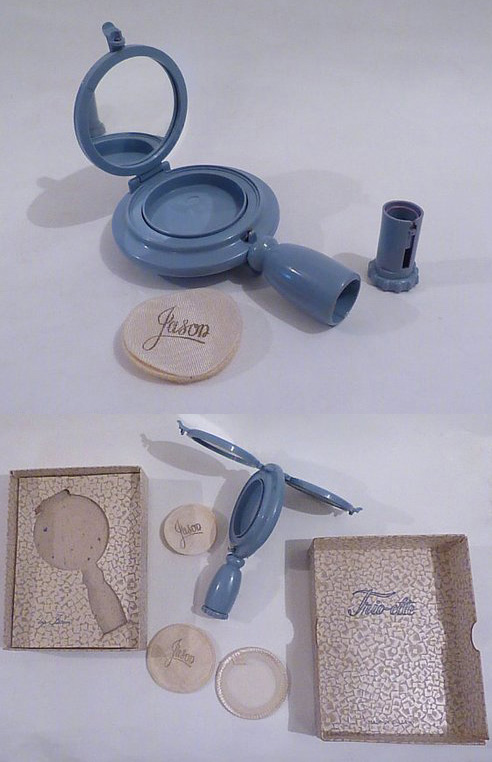
(image from antiquesatlas.com)
According to the British Compact Collectors Society, the Jason Trio-ette was also known as a "three-in-one" and available in blue, green, ivory, black and tortoiseshell and could be ordered by mail from Targett Tools Ltd., London. It's not clear what, or even if, there was a relationship between House of Platé and Jason.
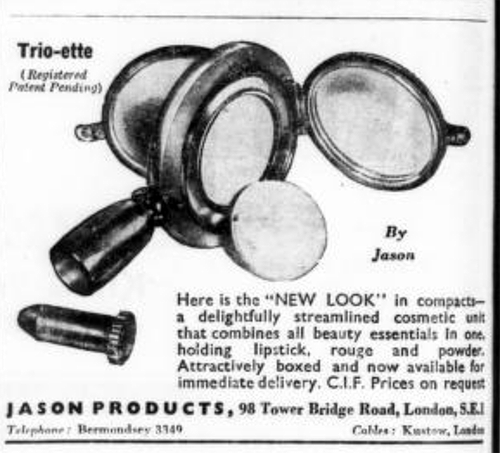
What's undeniable is the impact the Trio-ette had on future compact designs for the bigger brands. Volupté launched a compact with powder, lipstick handle and outer mirror in 1951 within its Demitasse line, and by 1953 it was advertised as the "Lollipop".
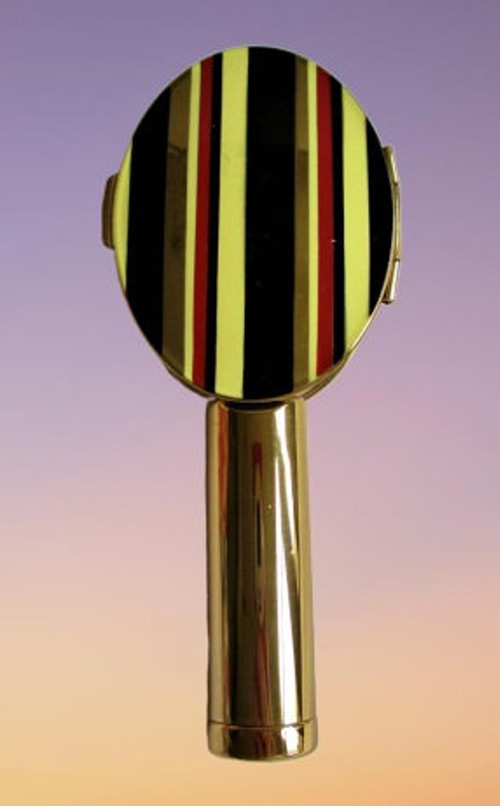
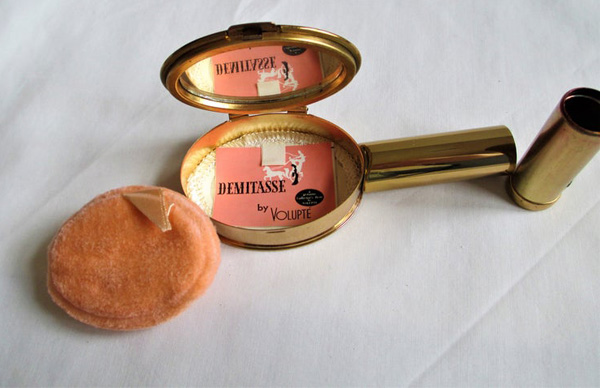
(images from etsyc.com)
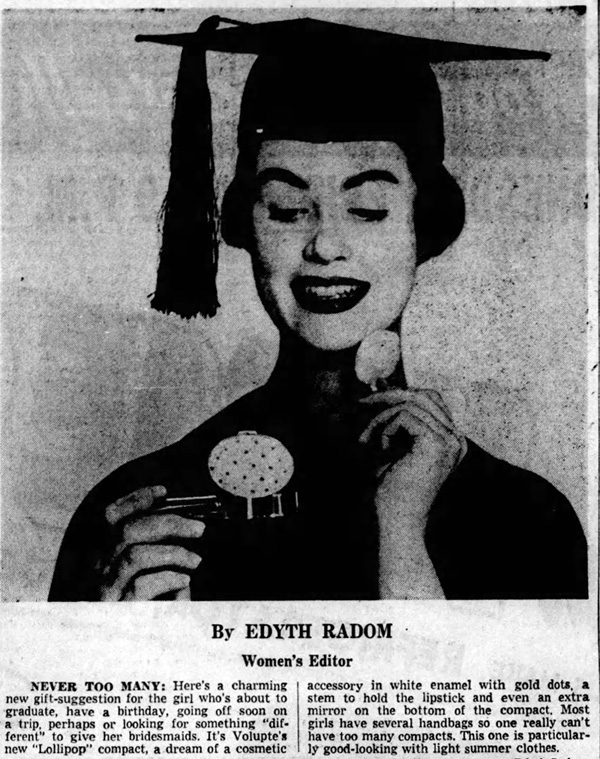
Around 1952 Coty launched its Parisienne vanity, similar to the Volupté Lollipop, but with no mirror on the outside of the compact.
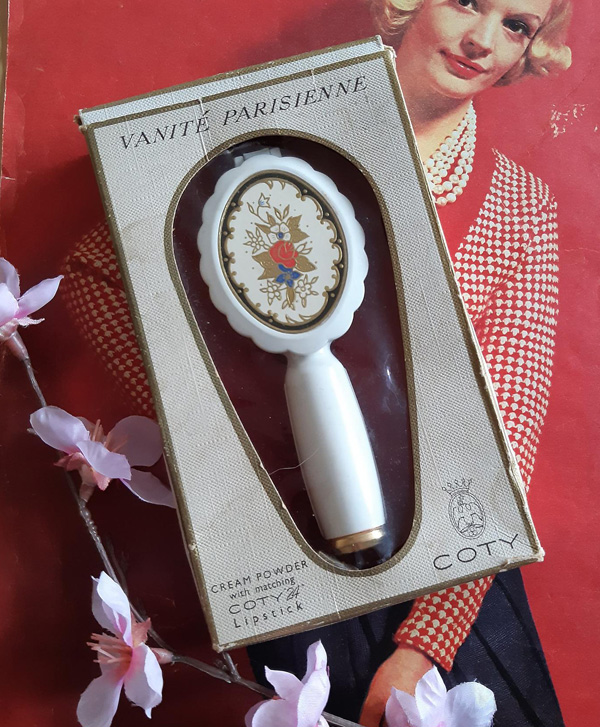
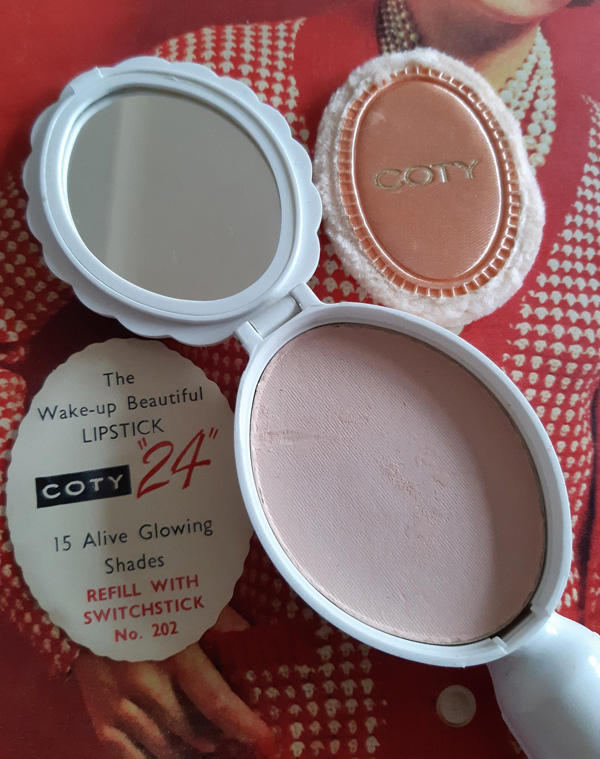
(images from etsy.com)
Perhaps another reason for the Trio-ette's brevity was simply that Plate couldn't compete with the more well-known brands, who in addition to name recognition, also had a far bigger advantage in terms of marketing savvy. Coty's Parisienne, for example, was somewhat misleadingly advertised as a "4-in-1" even though it actually only contained two products – the mirror and puff were considered the 3rd and 4th items. While some ads describe the design as a miniature hand mirror just like the Trio-ette, some others claim the Parisienne to be a "replica of a Cartier-designed original," which sounds way fancier than a Victorian hand mirror. Maybe if Plate had hired an agency with sneakier copy writers to advertise the compact differently, it might have had some longevity. As I noted earlier, he was educated as a mechanical engineer and not a businessman, so navigating the world of ad agencies and cosmetics marketing was a tricky prospect.
Anyway, House of Platé dropped the accent over the "e" and inexplicably shifted to making plastic toys by mid-1948, which continued through 1951.
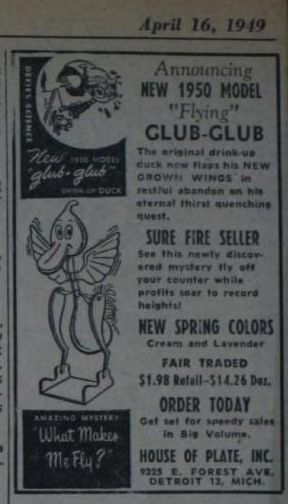
(image from archive.org)
Unfortunately Plate was no longer running a legitimate business at that point. According to a 1951 FTC ruling, essentially the House of Plate was mailing people products they did not order and then demanding payment. It's a common scam that persists today in the form of "free trials" of various products. (A few years ago my own mother was the victim of one of these schemes in the form of a trying out a "free" face cream she was sent.) In 1951 the company was officially dissolved. Plate passed away on December 10, 1966 in Athens, Greece.
Now let's investigate Benefit's Glamourette. First, a little background. Founded as a San Francisco boutique called The Face Place by twin sisters Jane and Jean Ford in 1976, the company was renamed to Benefit in 1990 and launched at Henri Bendel in 1991. The cheeky names and retro vibe quickly made their products best-sellers across the country. In 1997 Benefit made its international debut and was acquired by LMVH in 1999. Using vintage mannequins as their mascots and creating packaging inspired by everything from '20s face powders to '70s lip glosses, Benefit was widely recognized as a fun brand that lightheartedly saluted beauty products of yesteryear.
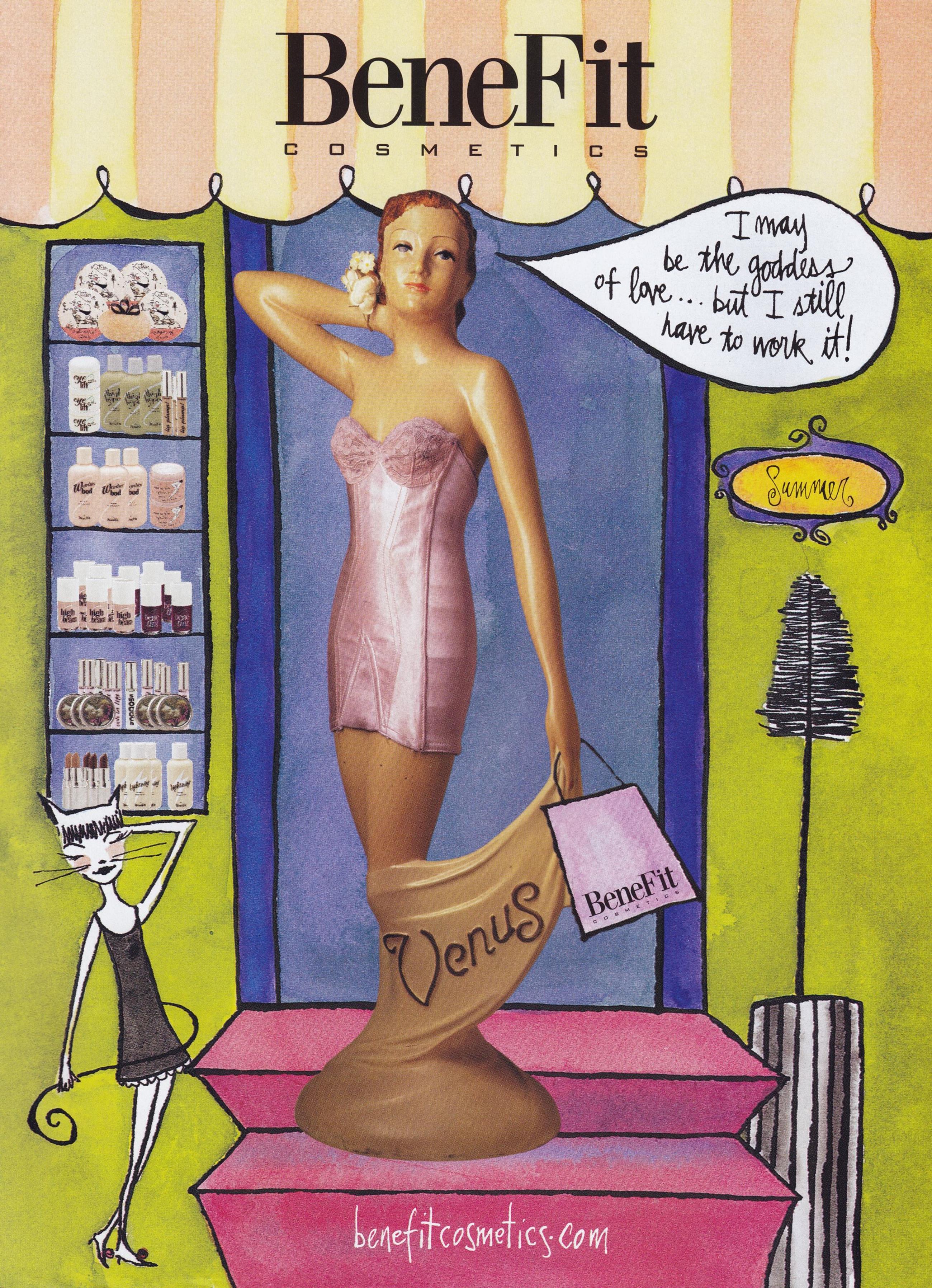
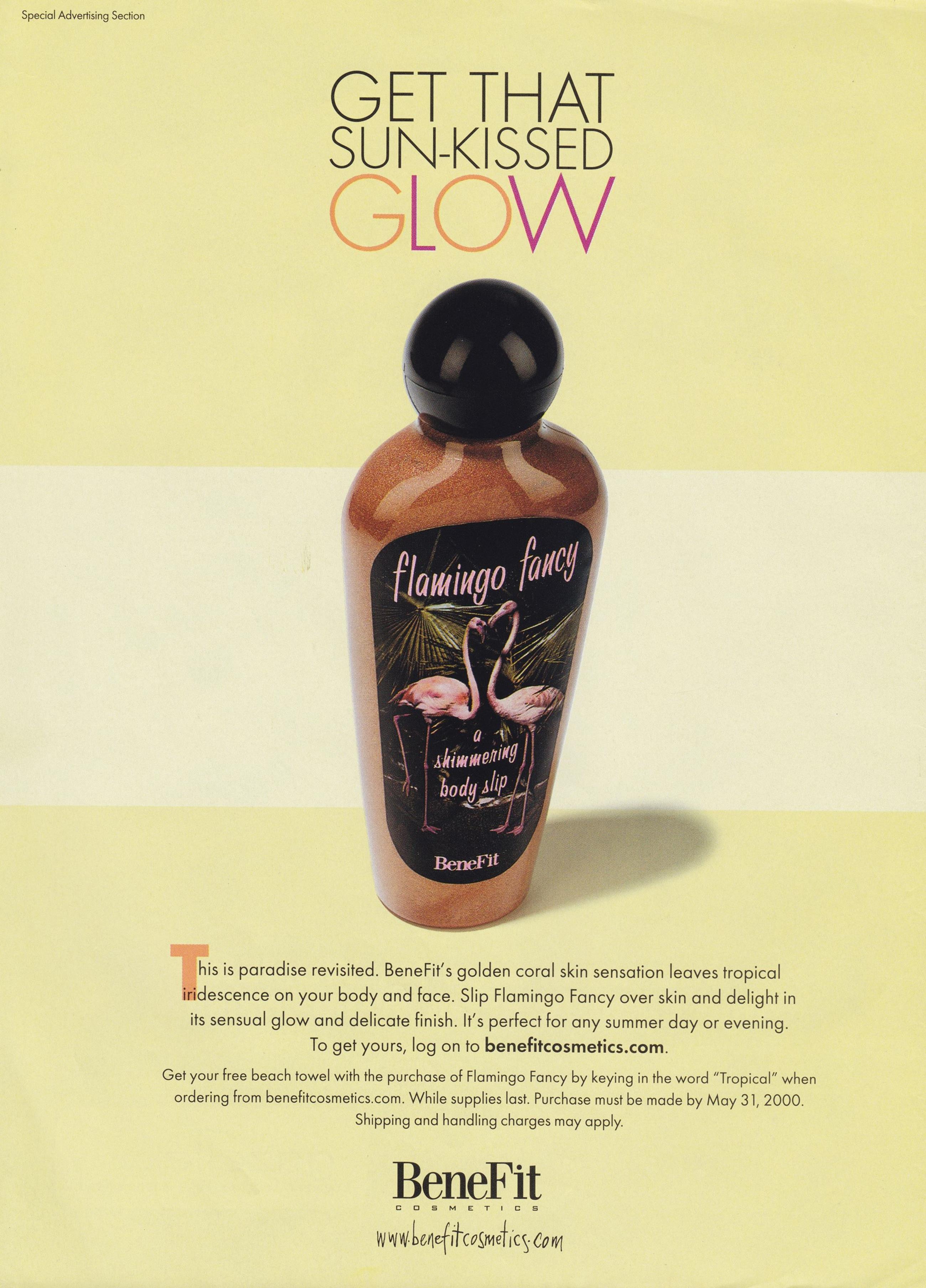 (images from archive.vogue.com)
(images from archive.vogue.com)
The company had firmly established its playful kitschy take on cosmetics by the early 2000s, but why they decided to draw on the Trio-ette specifically is unclear. None of their other products seemed to be literal remakes of a particular piece of makeup from earlier times. As with the Trio-ette, I wish I could hunt down the patent drawings for their version of the compact. I also wish I could find anyone who worked for Benefit during that time and see if they have any inside information as to what inspired the company to update the Trio-ette. We know that the Ford sisters were vintage collectors, so maybe one of them came across a Trio-ette and thought it was the perfect compact to use in their line, but why?

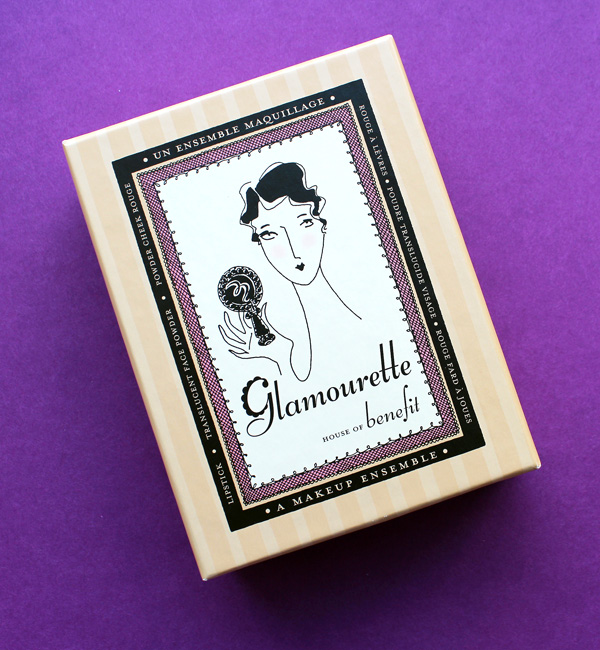
Let's compare the Glamourette with the Trio-ette. I would have done a smackdown because they are nearly identical but pitting a spry 20-year-old against a 70+ relic didn't seem like a fair fight. Obviously the formulas for the makeup itself were updated with newer ingredients.
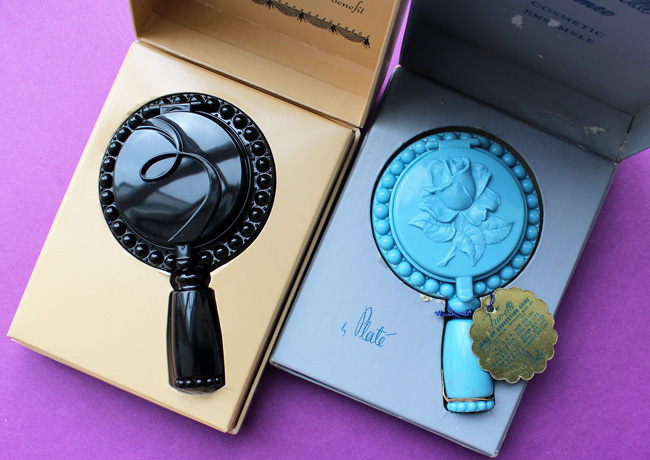
The lace pattern on the inside of the lid is a nice nod to the pink floral pattern that appears on the insert included with the Trio-ette.
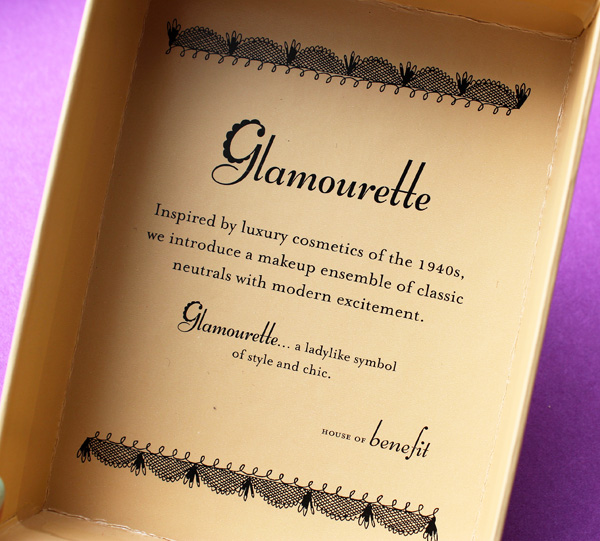
Instead of a rose on the lid Benefit used an abstract squiggle design. Also, I don't think the Glamourette was offered in other colors; to my knowledge, only black plastic was available.
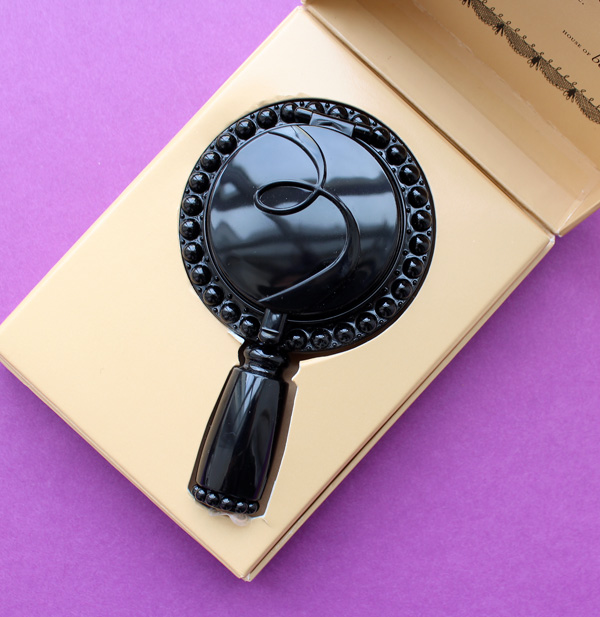
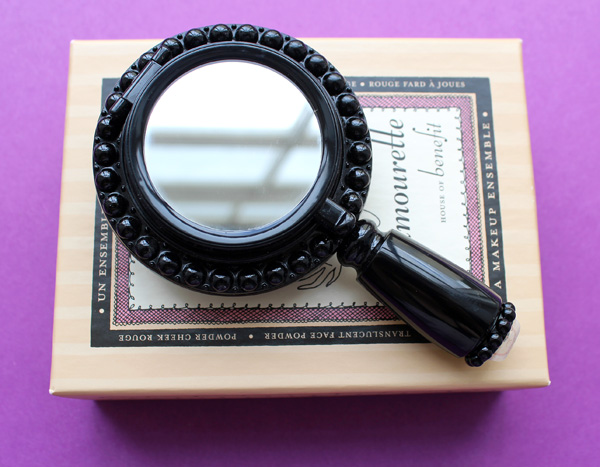
The lipstick mechanism appears to be the same between the two compacts, but Divine's rosy brown hue is unmistakably '90s/early 2000s. Instead of the company's name on the cap there's a sticker saying "lipstick". I would have strongly preferred Benefit's name rather than a totally unnecessary sticker. I know people are dumb but it's pretty obvious it's lipstick…no need for a sticker.
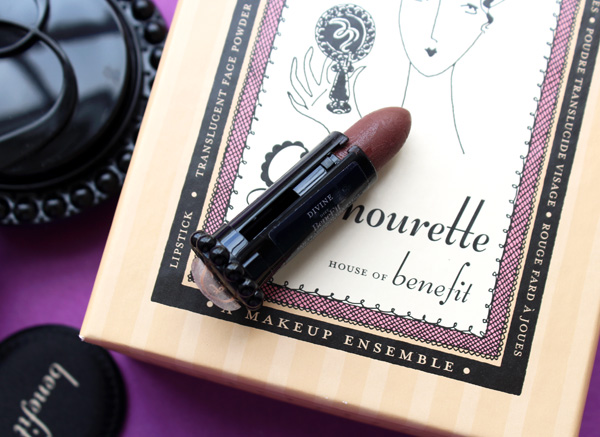
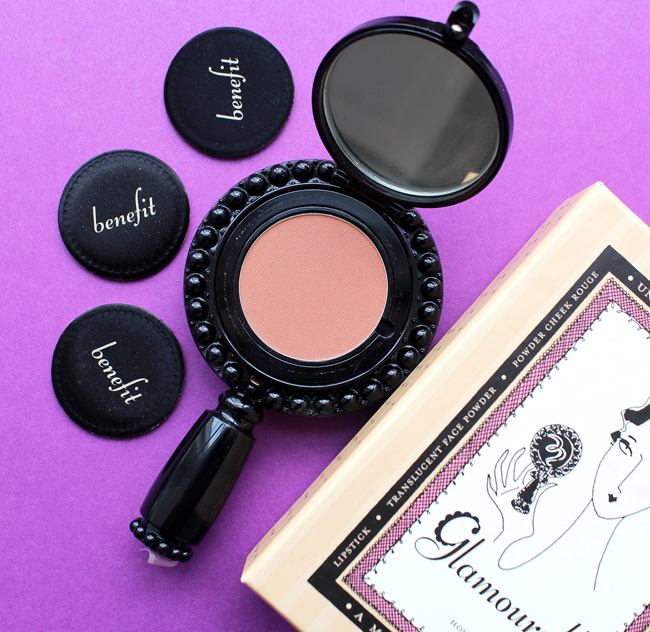
Interestingly, the powder and blush are reversed from the Trio-ette, i.e. the blush is on the inner part of the compact and the powder is on the outer side. You could also swap out the powder for Fancy Lady cream highlighter.

The shade range for the face products had not improved since the 1940s. In fact, I suspect the Glamourette's was even worse. I'm not 100% sure, but it's my understanding from reviews that Fancy Lady didn't come in any other shades besides a pale ivory/champagne. And while I can't make out this tiny photo, it looks like Fascinating Finish powder, appallingly, also only came in one very light shade.* I know it was 2002, but I was pretty into makeup by then and I distinctly remember just about every line having at least 3 options for face powders and tinted moisturizers by then: light, medium and dark. It's absolutely inexcusable that Benefit didn't offer the bare minimum for face powder shades in the Glamourette compact.
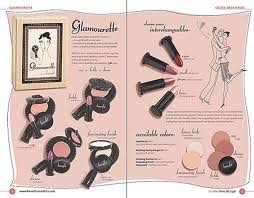
(image from amazon)
Getting back to comparing the two, unlike the Trio-ette, the Glamourette came with a wristlet that could be used as a storage pouch. It's a very sheer piece of organza that I don't think would have been too helpful in terms of preventing wear and tear, but interesting to note.
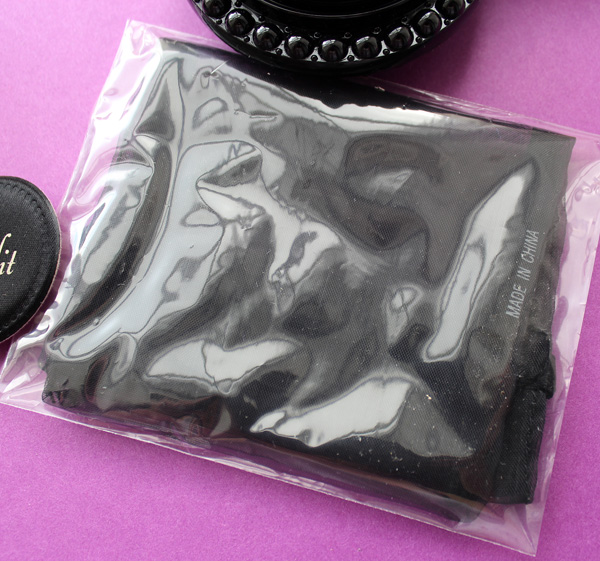
Obviously the advertising for the Glamourette was similar to its 1940s counterpart. Both touted ease of use, refillable products and chic, vintage-inspired packaging. Bag fumbling was still presented as a tedious time waster for the new millennium's busy modern woman. Perhaps as a sort of snooty counterpoint to the golden age of trashy reality TV and super glossy, frosty makeup finishes that appealed more to teens than adults, the Glamourette was also described as "discreet" and something a "real lady" would carry, whatever that means.
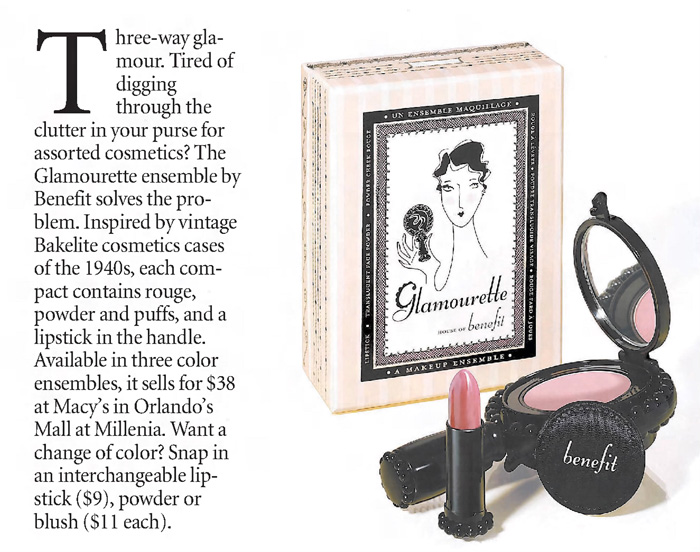
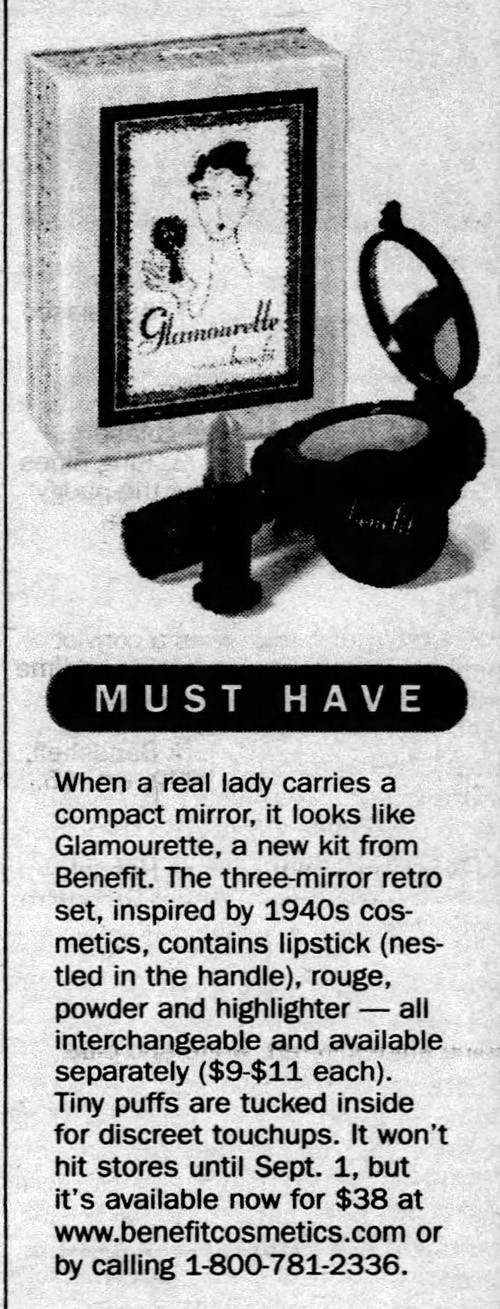
The Glamourette was generally well-received. There are a few reviews on Makeupalley gushing over its cuteness and convenience while acknowledging it was a gimmick. One reviewer mentioned she would pass it on to her 11 year-old daughter in a few years, so Benefit helped rekindle the notion of makeup as a keepsake. While most MUA'ers felt the amount of product was a bit stingy for the price point, overall they loved the style and found the compact practical for a night out. Several reviews also pointed out the similarity to the black plastic packaging of Anna Sui's line.
Speaking of product amounts, I don't have the exact numbers for the Trio-ette, but if they were the same as the Glamourette, the latter was actually a better deal. The Trio-ette retailed for $5.50 in 1946, and according to an inflation calculator it would have cost about $51 in 2002 when the Glamourette was being sold. Glamourette's retail was $38 ($55 CAD and £32.50 in the UK). I also find it amusing that the reviews commented on how streamlined and tiny the compact was when Glamourette is actually a smidge larger than the Trio-ette, which was described as "bulky" in the Drug and Cosmetic Industry article. As we know, makeup packaging gradually got bigger over the years, so the Glamourette demonstrates how both design and consumer expectations changed.
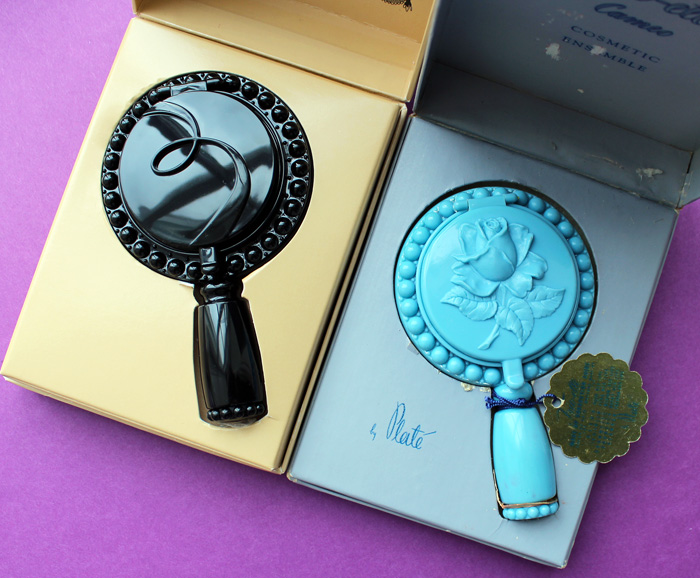
Despite the amount of press and good reviews, the Glamourette was a limited edition item that did not return to the market after its brief two-year stint. Even against the backdrop of '90s/early aughts' nostalgia for mid-century styles (see also Too-Faced's Quickie Chronicles) maybe the Glamourette was too retro for most customers. I know when I laid eyes on it I thought it was cute but overly vintage-looking for my taste. It could also have been the type of products included. While there absolutely was and will always be a demand among those sticking to simple polished looks and makeup classics in neutral tones, in the early 2000s traditional lipstick, face powder and blush weren't the most wanted product categories among the younger crowd. Says one Makeupalley reviewer, "It has powder and blush which I never use to touch-up, so I'd never carry this with me. And it also has lipstick, and I'm not a fan of lipstick. If they replaced it with concealer, bronzer, and lipgloss, I'd sell my soul for it!!" Perhaps a tiny sifter of body glitter may also have been more palatable for a Y2k audience. Finally, the lack of shades for anyone whose skin was deeper than mayonnaise obviously eliminated a good portion of the market.
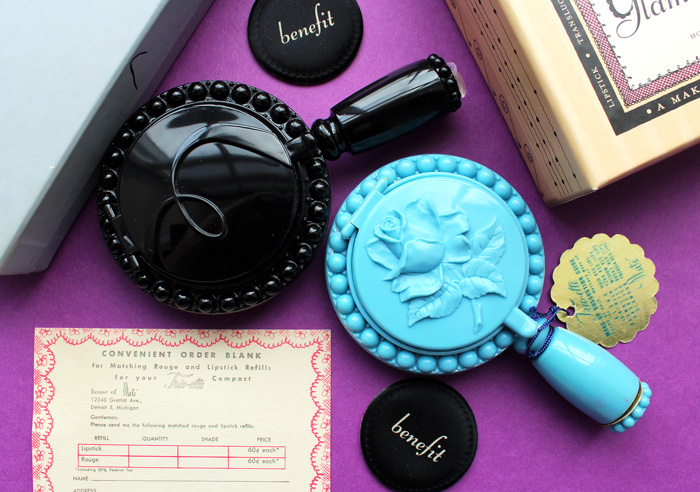
I still can't wrap my head around why Benefit chose this exact compact. I'm just spitballing here, but maybe it's precisely because House of Platé wasn't a well-known brand that's still sold today. Perhaps Benefit didn't want to risk running into copyright issues that may have occurred if they chose to release an updated version of, say, Revlon's Futurama cases. The patents for those designs may have expired, but the companies are still around and significantly larger than Benefit was – although it was owned by LMVH by that point, Benefit's rivals had the potential to take legal action if the company tried to update an iconic product from their archives.
Even though there's a 55 year age gap between the Trio-ette and the Glamourette, their advertising and reception were remarkably similar. So much had changed between 1947 and 2002, yet the design appealed to totally different audiences. As Drug and Cosmetic Industry noted with the Trio-ette, people love a novelty product even if the underlying concept – in this instance, having three makeup products in one attention-getting case – has been done before. It got me thinking about how a third iteration of the compact would be marketed and received today. The small sizes and refills would be attractive to today's makeup consumers, but the compact would have to be made out of sustainable packaging; plastic won't play well. Maybe the products could be even smaller to make space for brushes rather than puffs. There would probably have to be some kind of emphasis on "wellness" and "self-care" or at the very least, "clean" (sigh), vegan and ethically-sourced ingredients. Most importantly, the shades would need to accommodate all skintones. One parting thought: I'd also be curious to see what would happen if a company released it not today but 55 years after the Glamourette. I wonder how makeup customers in 2057 would react.
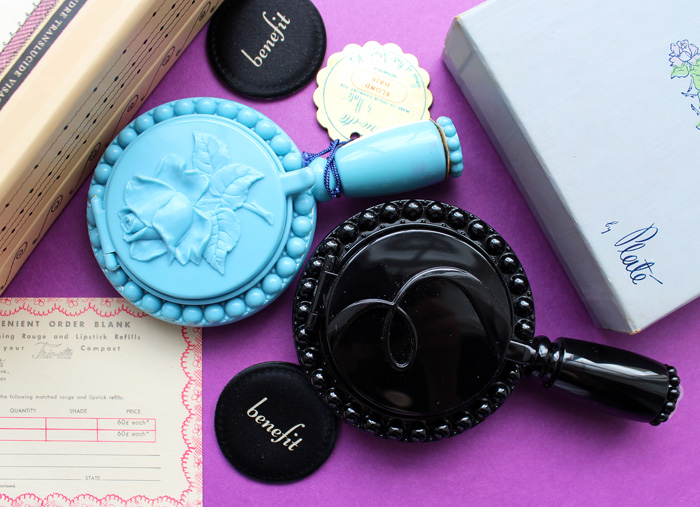
What do you think of the designs of these compacts? Do you have a preference for one or the other? And do you like having your makeup all in one place? I could see using something like this for touch-ups, but it would still fall short. Until a product is developed that combines concealer, powder, blotting sheets and lip color all in one, I'm destined to dig around in my bag.
*There was an article in Global Cosmetic Industry from 2002 that lists the following colors for Glamourette blush and lipstick refills. It doesn't make any mention of multiple shades being available for the highlighter and powder. "Rouges in Divine, Fickle and Coy, Fascinating Finish Translucent Powder and Fancy Lady Highlighting Creme are priced at $11.00 each. The line offers Lip shades priced at $9.00 each in Keen (champagne pearl), Vain (vibrant red), Divine (rich plum), Swell (dusty rose), Prim (pink-cocoa pearl), and Coy (mocha apricot) varieties." I cannot for the life of me locate the article now but I know it existed!
I'm quite far behind on artist collaborations, so I'm doing some more catching up. Today we have British artist Morag Myerscough for Bobbi Brown, whose collection was released in the spring of 2020. It was a small collection consisting of an eyeshadow palette, highlighter and two lipsticks. I purchased one of the lipsticks and the two other items…and of course I can't seem to find the lipstick. (I'm really hoping to take a full week off of work this summer to properly re-organize the Museum's collection, as things keep going missing or take literally hours to locate. Sigh.)

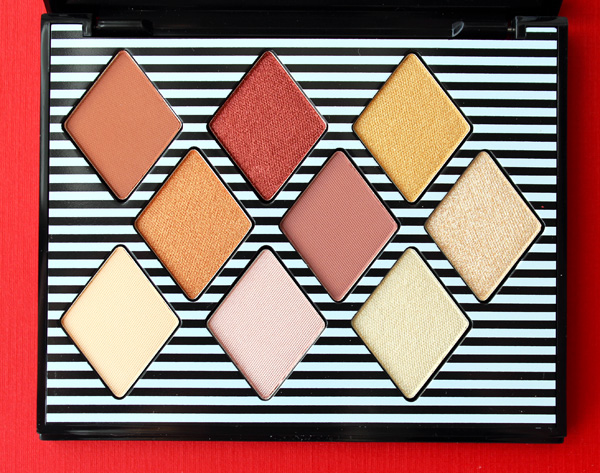
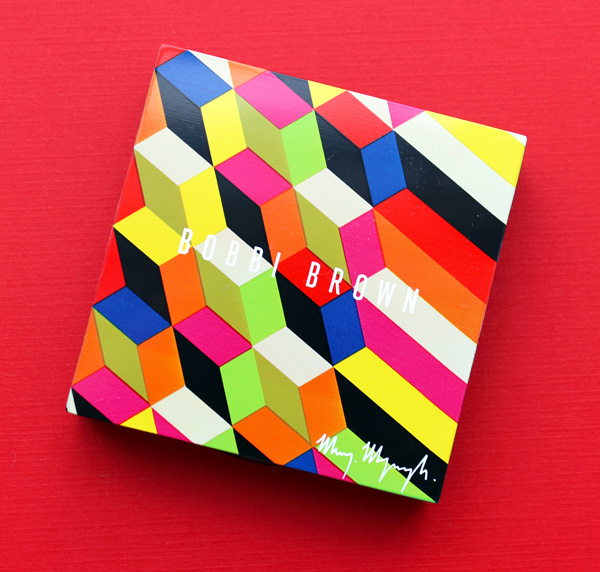
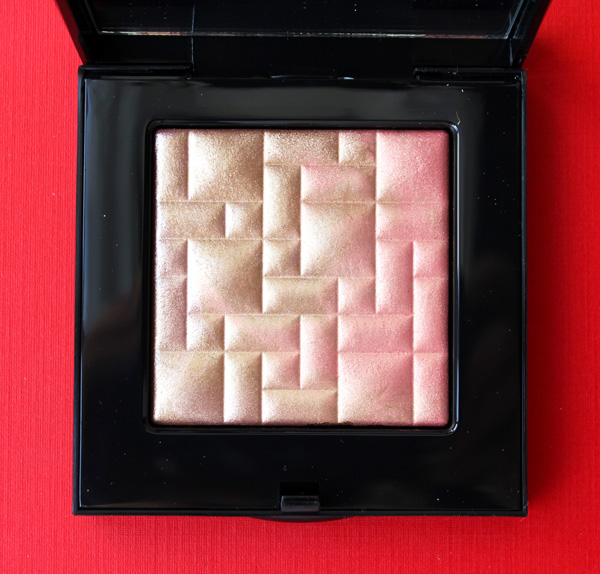
Born and raised in London, Myerscough came from a family of artists. Her father was a highly sought-after session musician in the 1960s and '70s, while her mother was a textile artist. Myerscough was settled on an artistic career even before she was out of elementary school. After graduating from St. Martin's where she studied graphic design, Myerscough attended the Royal College of Art. In 1993 she established Studio Myerscough, and in 2010 Supergrouplondon, a collaborative studio with fellow artist and partner Luke Morgan, was born. You can read more about her professional background at Eye Magazine.
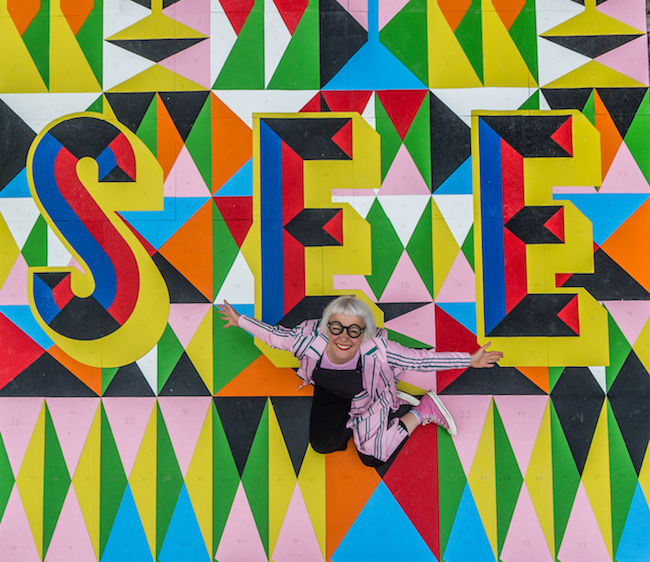 (image from colourstudies.com)
(image from colourstudies.com)
Myerscough's vibrant color combinations are influenced by her mother as well as several artists, including Josef Albers and '80s collective Memphis (remember them from my Hermès post?) She explains, "[My style of] colour could be from my mother, I think my colour sense comes from being very young and understanding the difference between a dye made from a natural source and one from an artificial source. When I make my big pieces of work I much prefer to paint them as I can get pure pigments and as they are used in spaces it is important how colour responds to light. There is nothing better than to see an amazing colour in the right environment, it can change your whole mood. I like to be brave with colour, at college I was introduced to Albers, and I was very interested in his theories on how colours respond to each other." She adds, "I really hate when people say that colour is exclusive to children, what sad people they must be. Adults need colour in their lives as much or maybe more than children. Colour is so abundant in nature and we need it more in our built environment." Hear hear!
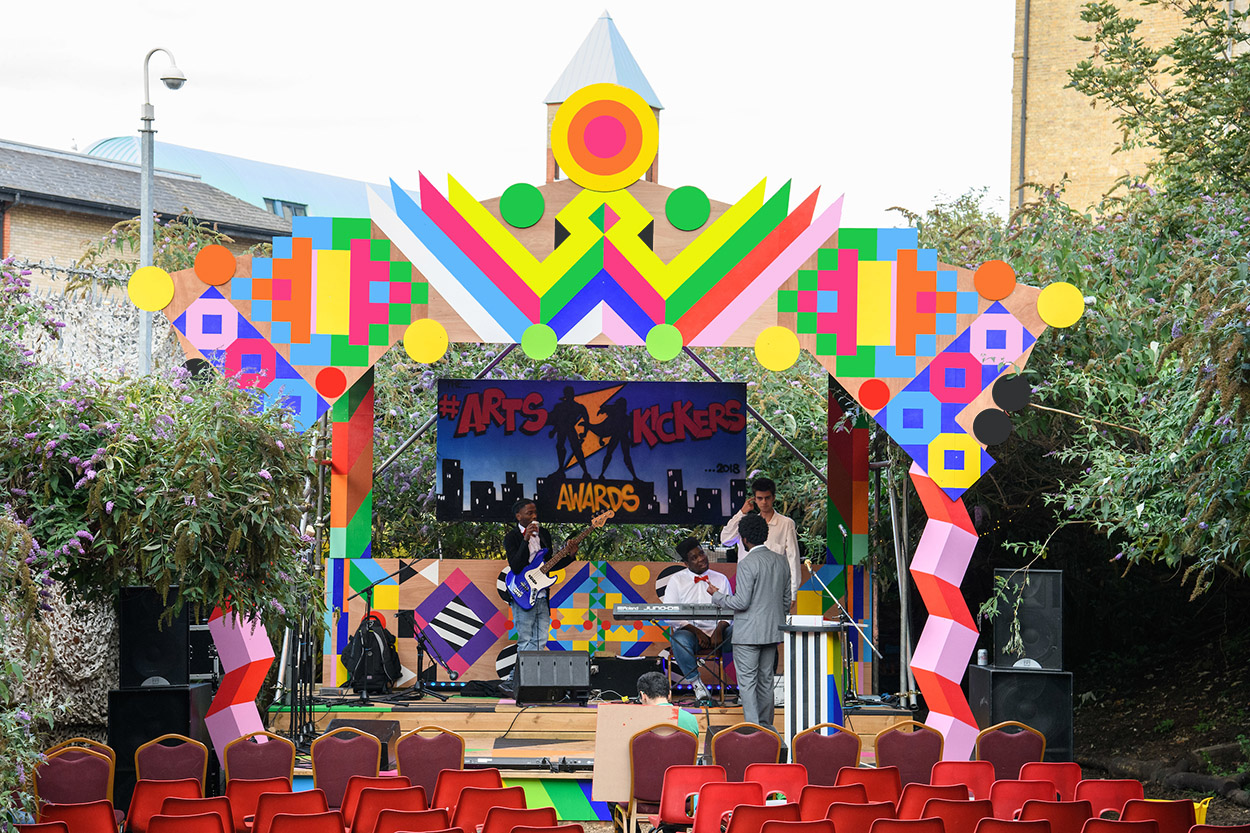
In 2017 Myerscough designed the Artskickers stage for a beloved community hub in Dalton Garden. Over 200 events are held here each year.
Her color choices combined with the tidy, modern geometric patterns reflect both her graphic design background as well as the influence of artists such as Bridget Riley and Dan Flavin. Here are a couple examples so you can see the resemblance.
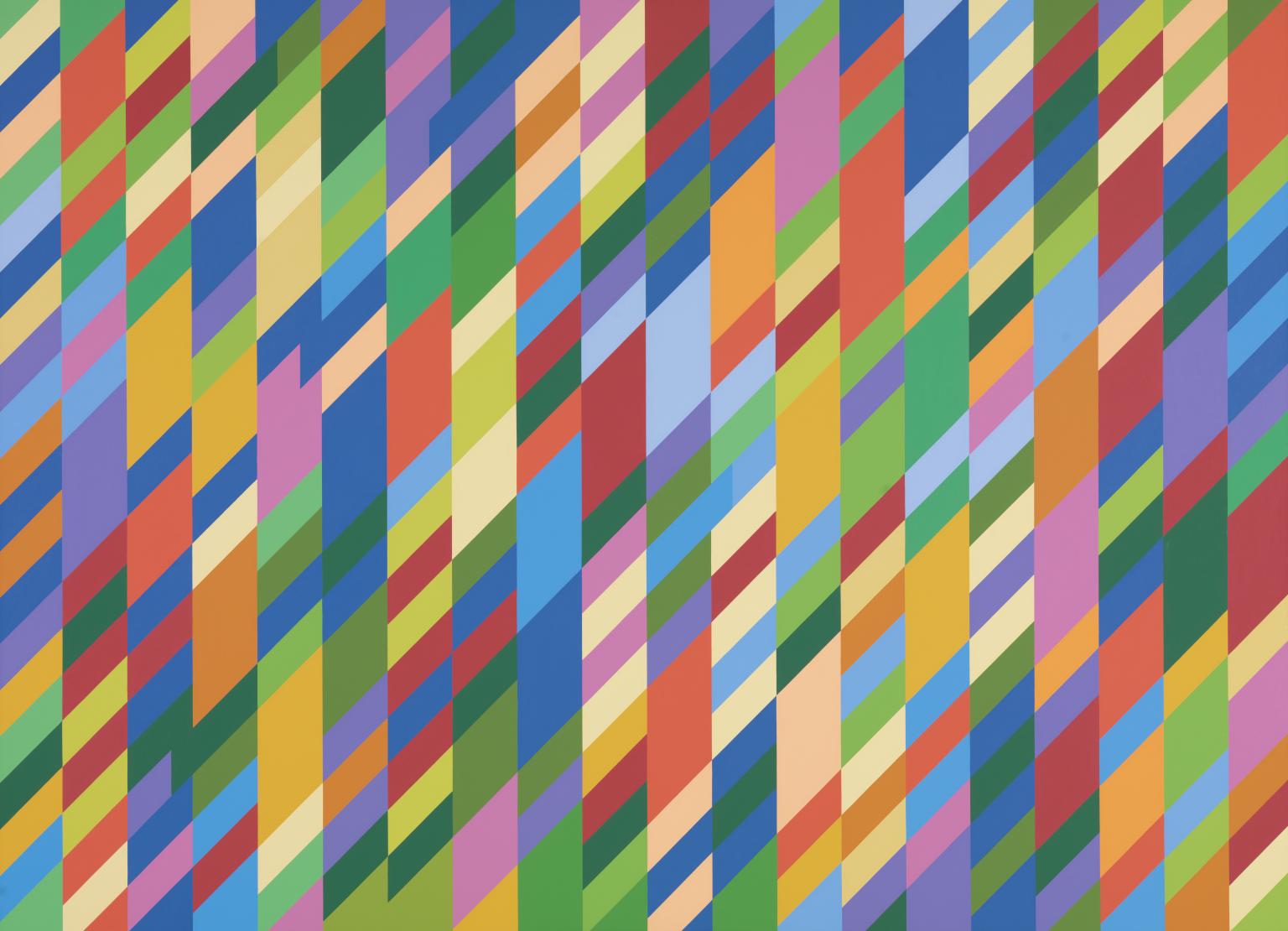
Bridget Riley, Nataraja, 1993
(image from tate.org.uk)
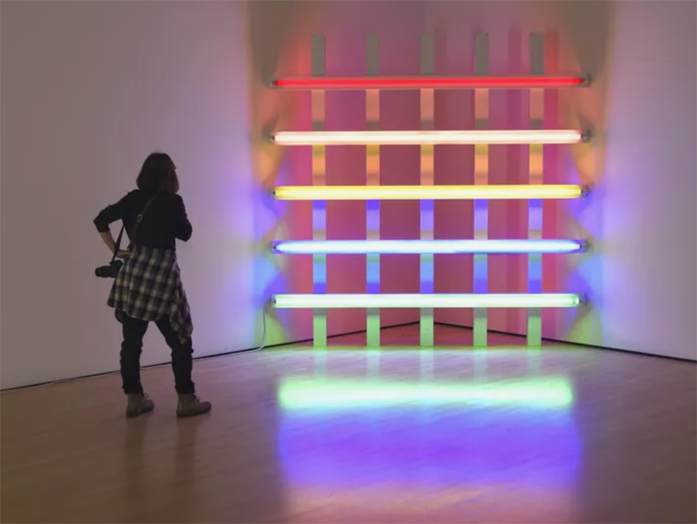
Dan Flavin, "Untitled (In Honor of Leo at the 30th Anniversary of his Gallery)," 1987
(image from thoughtco.com)
You know I adore big bold swathes of color, but it's Myerscough's dedication to community engagement and overall approach to art that speak to me the most. Adopting a Chinese proverb as her mantra, "make happy those who are near and those who are far will come," Myerscough aims to instill a sense of belonging among the people using the space she's been commissioned to reimagine. She believes art is a unifying concept that can bring people together and connect them to certain places. A beautiful example is the Burntwood School, where Myerscough designed many of the interior and exterior wall patterns. "I put a narrative in the building, we make places where people feel they belong. I like working collaboratively with architects…we have made some great steps in how schools are used and how the students connect with their schools. The team needs to want the same result and for the project to be successful this involves everybody. The students' grades have increased hugely, I believe this is because they have a building that works for them, that they can be proud of, with teachers that care about them and when you put all the parts together it produces success," she says. I wonder if my anxiety would have been mitigated if I had attended a school with this sort of art everywhere. Probably not, but it's at least nice to look at.
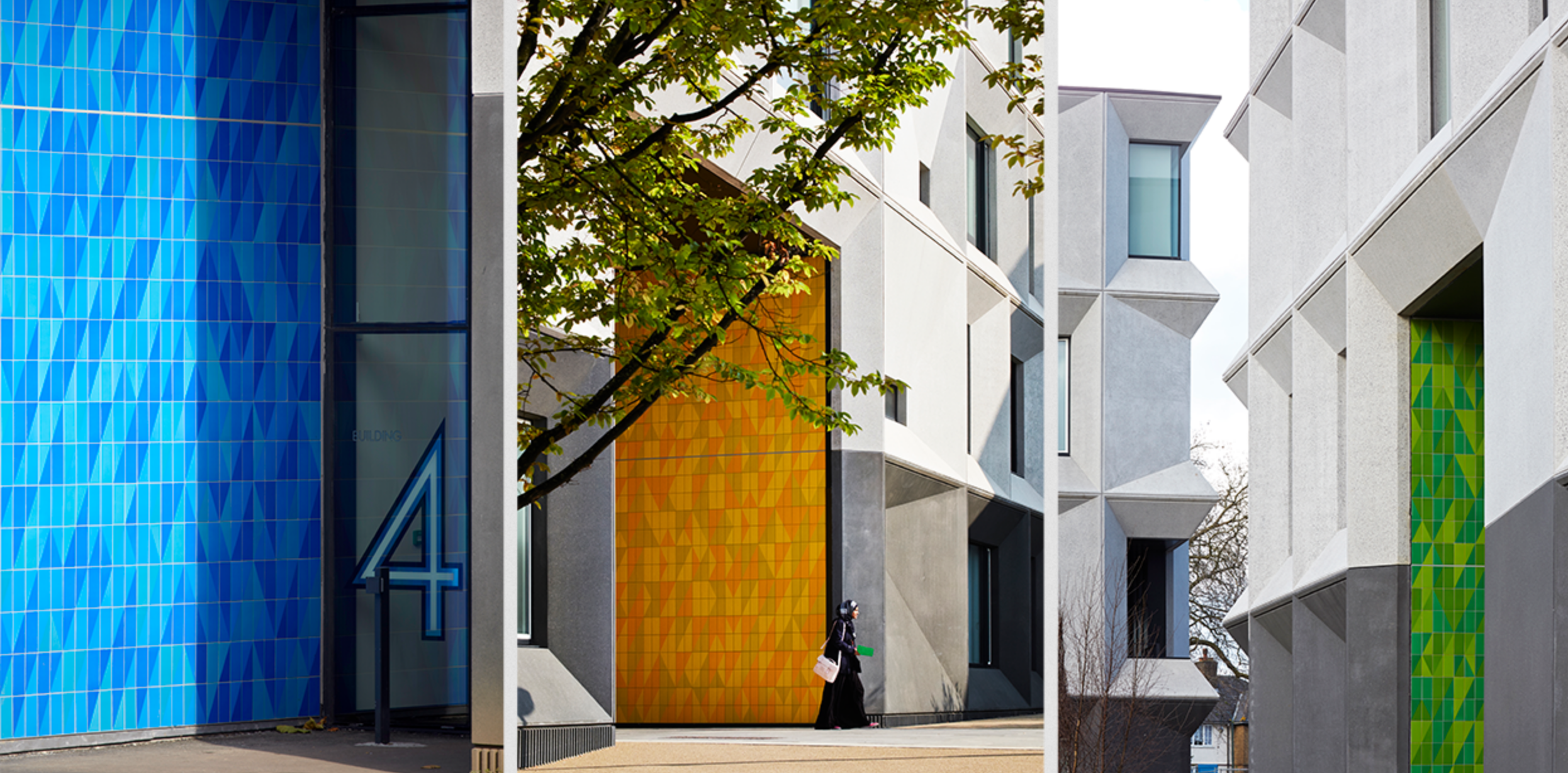
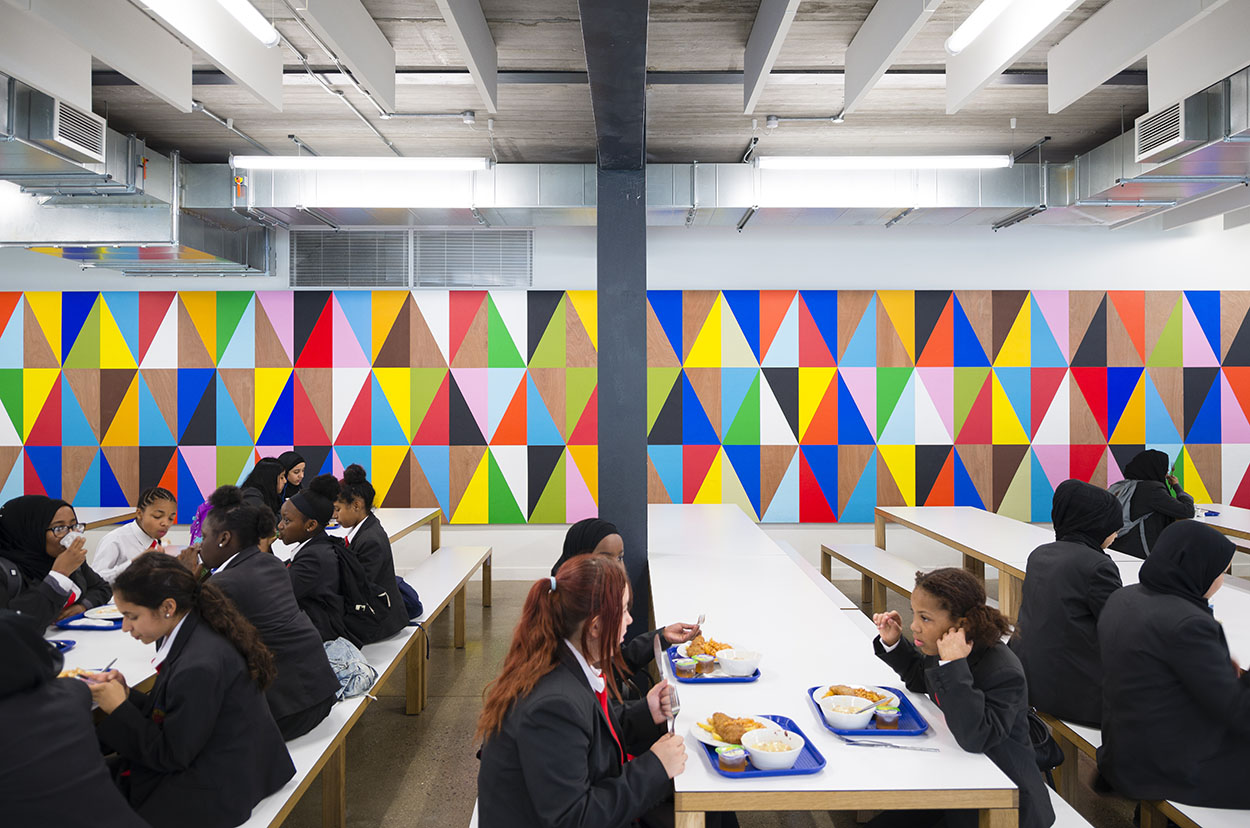
I also love the Vinyl Lounge, a mixed-used space that used to be an office owned by British music company EMI in the '70s. Myerscough carefully researched the history of the buildings to design something that paid homage to their past while accommodating modern needs. The furniture and other decor consisted of vintage eBay buys or made by Luke Morgan with reclaimed materials. The "lounge" itself served as a gathering place. In this way the space incorporates local heritage and engages the community. "I do focus on belonging. I want to find out from people what it means to them. Because it may mean different things to different ages, like for the older ones it might be family, while with young ones it might be friends. I also try to see what part of it makes you feel belonged; is it just your culture or is it about talking with each other? It does not matter that you do not come from the same place but can still belong together."
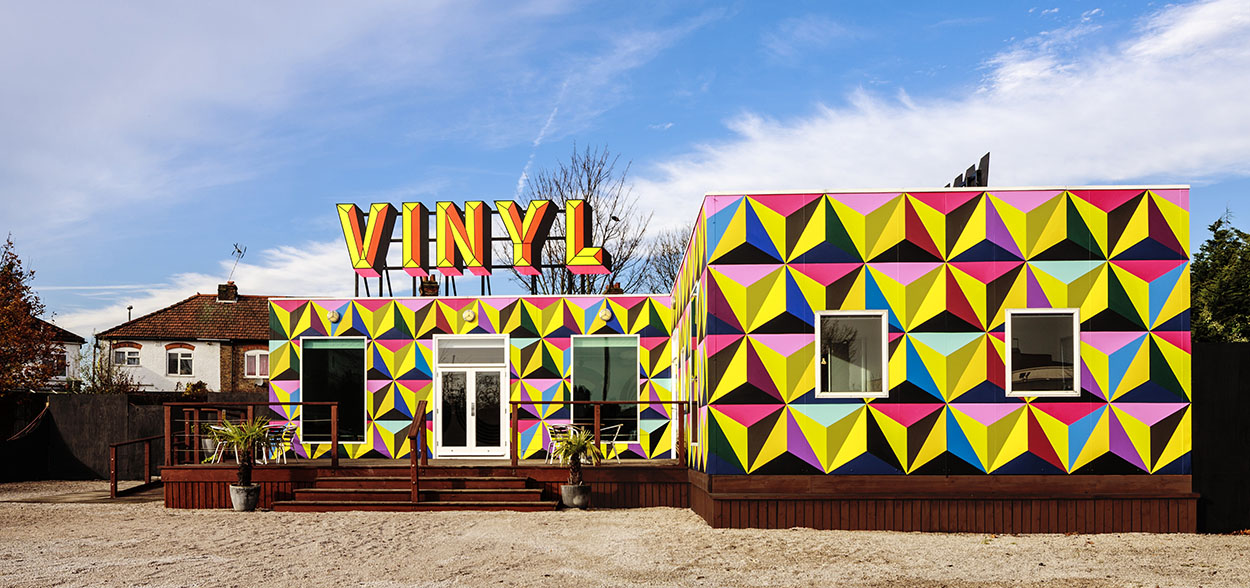
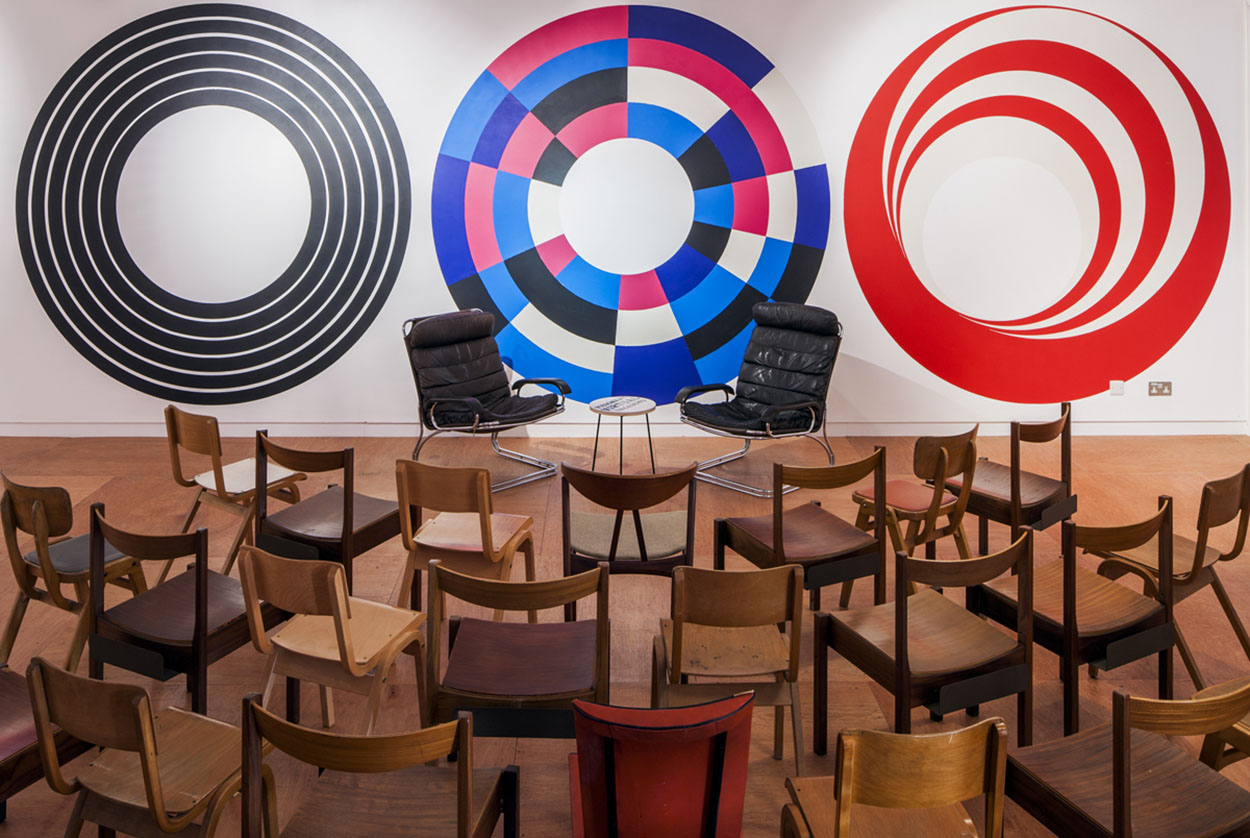
But I do have some mixed feelings towards other projects. While I admire Myerscough's approach and would be honored to be able to visit one of her works in person, at the same time I'd most likely want to punch it. Perhaps I'm too cynical not about public art in general, but Myerscough's optimistic outlook more specifically. It's a bit too cheerful and positive for my grumpy, pessimistic self, or at least, the text is. If I was confronted by Love At First Sight, for example, I'd roll my eyes and walk right on by. Ditto for the billboards painted in honor of the frontline NHS workers during the early part of the pandemic. It's a really nice thought, but calling them "heroes" is problematic, and frankly a mural comes off as much as an empty gesture as clapping did. Overall, I think her installations work better with no words, because there's no direction then and people can take whatever they want from it. Words create additional meaning and context, so without them there's more freedom of interpretation. However, I don't think Myerscough would be offended if she read this because at least I have some sort of reaction. We share the same belief that art should have some kind of impact on the viewer, whether it's bad or good. She says, "The main aim is that people aren’t indifferent to it. I want people to react. I totally understand some people might hate my work and I would rather have that than just dismiss it with indifference. I want people to have conversations; to experience something they didn’t expect. That’s why I love making work in public spaces, where people might stumble across a piece of work and have it change their thoughts for the day – ideally for the better." I agree that part of art's purpose is making one feel something and not nothing.
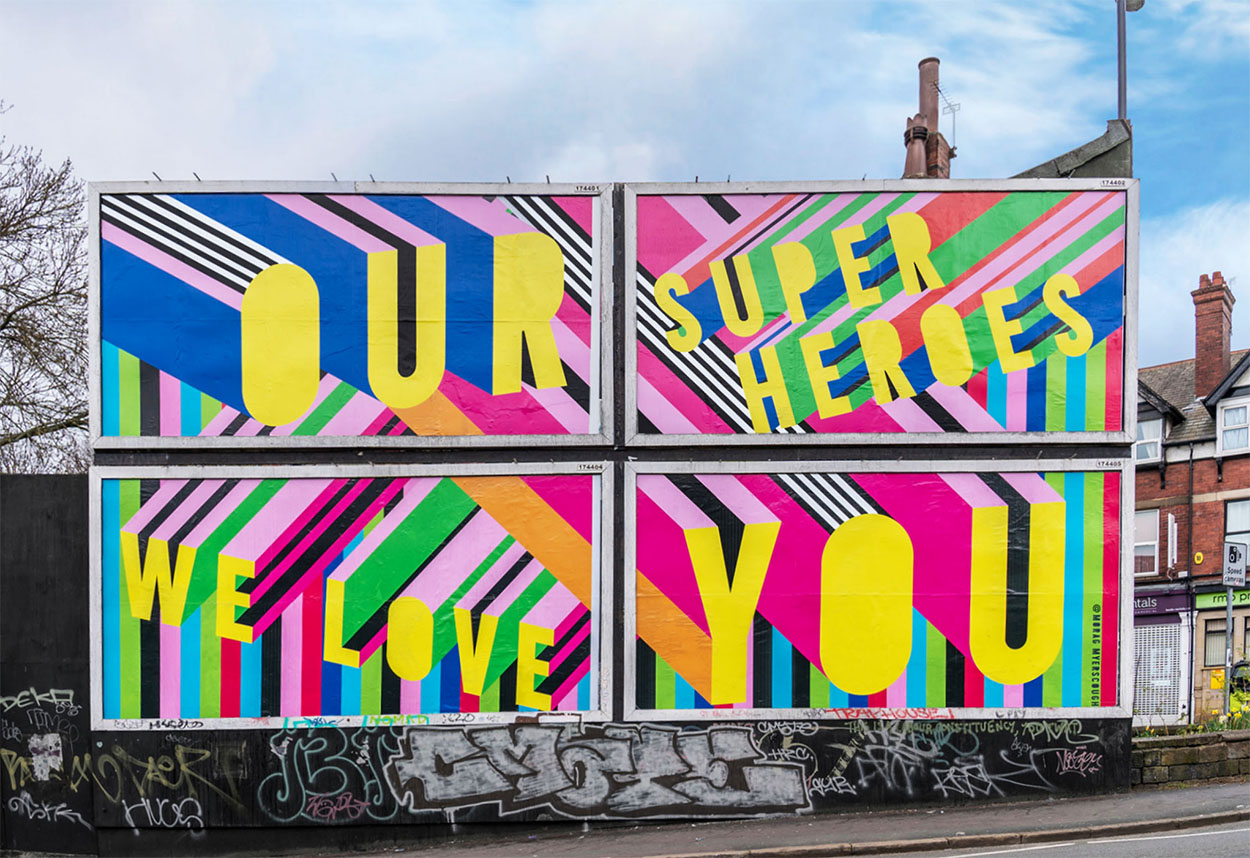
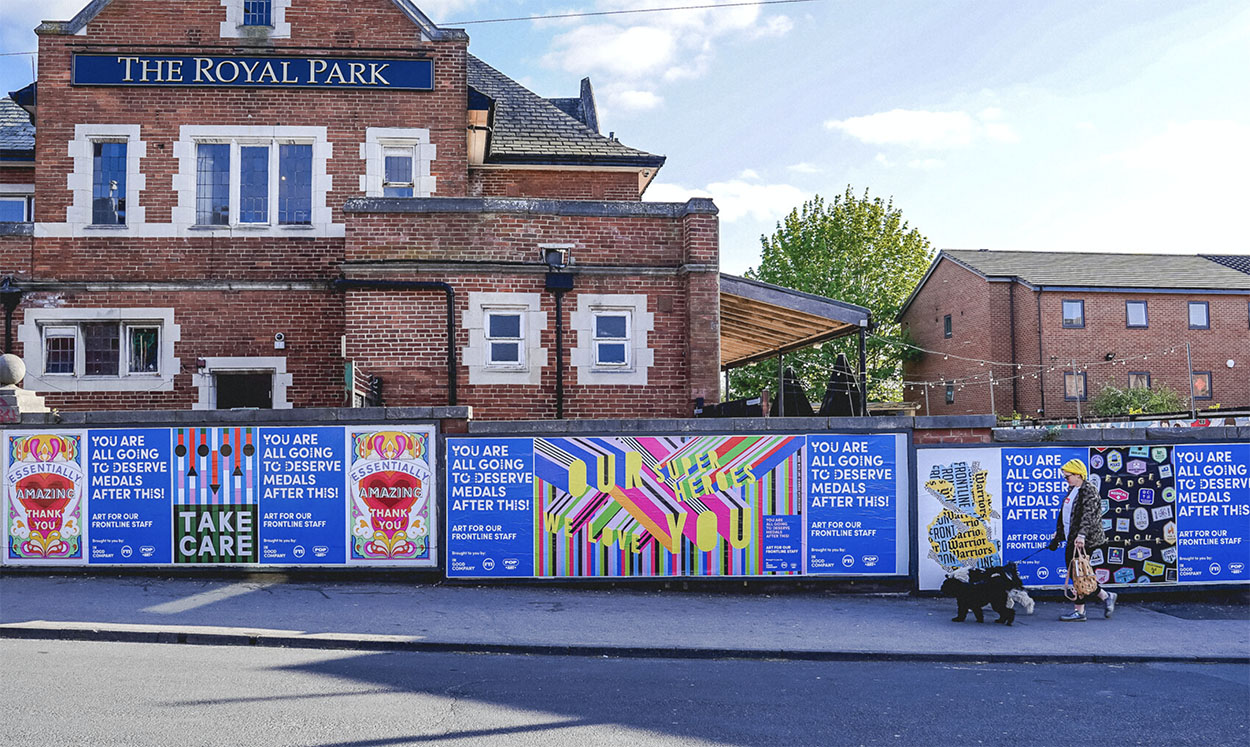
Anyway, I wholeheartedly applaud and respect the incredible work she's done for children's hospitals, but I fundamentally disagree with the notion of art in hospitals. The rooms at the Sheffield's Children's Hospital are very welcoming, and at the Royal London Children's Hospital, she used the children's own drawings part of the decor. "In hospitals I really do want to brighten people’s days, to raise their moods, to make them feel positive and hopeful. I want to make spaces that feel like home, which people enjoy being in. And ultimately to help people feel better…when I was commissioned by Vital Arts to design the five dining rooms at the Royal London Children’s hospital, I proposed to work with [poet Lemn Sissay] on the project. He did poetry workshops with the young patients and I ran visual workshops with the words. We then made murals by combining the words with the visuals, so the dining rooms belonged to the young patients – it was their ideas on the walls. I also displayed all the young patients’ original drawings in frames on the walls, so they and their parents could see it and it was clear the patients were at the centre of the artwork. It’s important that young patients and their families feel comfortable in these environments, because often they stay for long periods of time or return regularly as a child grows."
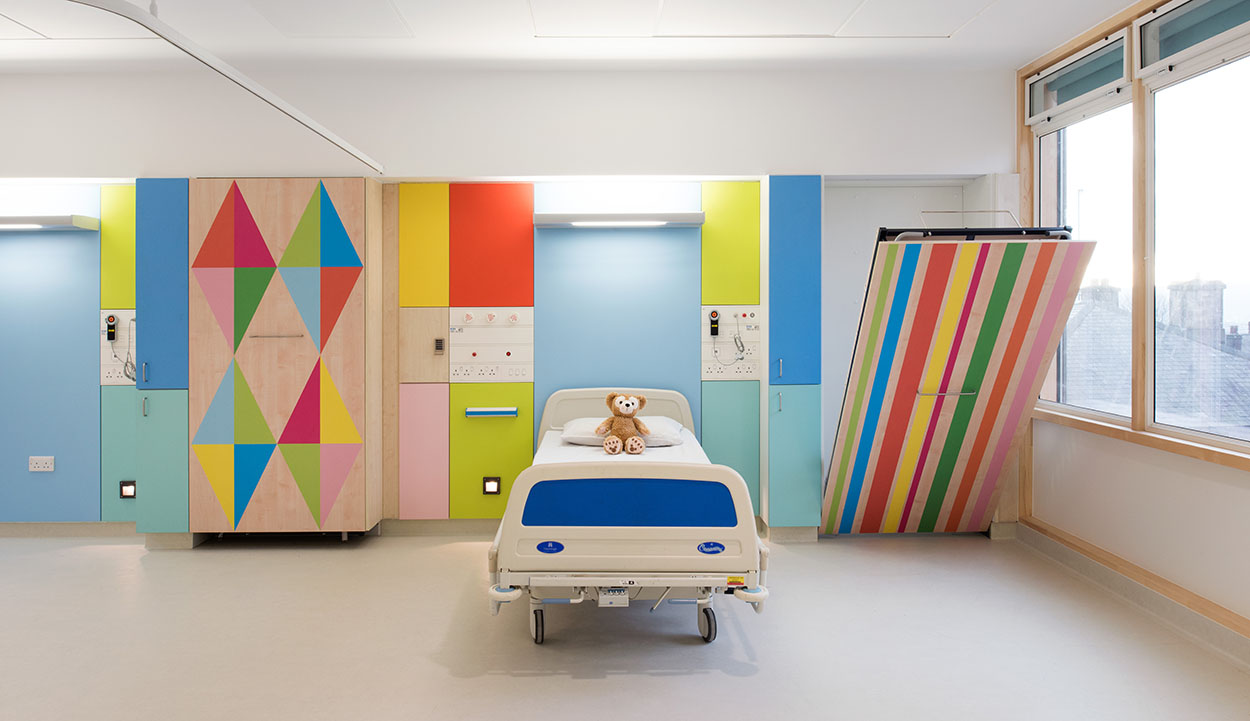 (images from moragmyerscough.com)
(images from moragmyerscough.com)
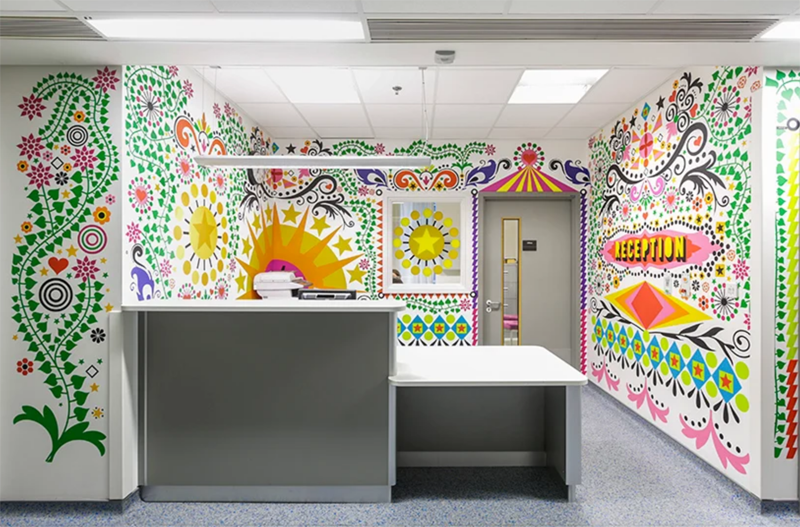
These are wonderful, innovative ideas and Myerscough's style is absolutely perfect for this type of project, but as someone who has spent far too much time in hospitals on account of ailing parents, I can tell you that absolutely zero amount or style of art is going to combat the dread and fear. Hospitals are for the very ill and dying, and despite some spotty evidence of the benefit of art in hospitals, I still think there's no artist in the world whose work can even come close to offsetting that type of negative energy. As both a patient and a visitor I'd honestly prefer it if art wasn't in hospitals and have them remain drab and depressing – it's far more appropriate for the space. Again, this is all just a matter of opinion. (And I certainly support art therapy where the patient creates art themselves.)
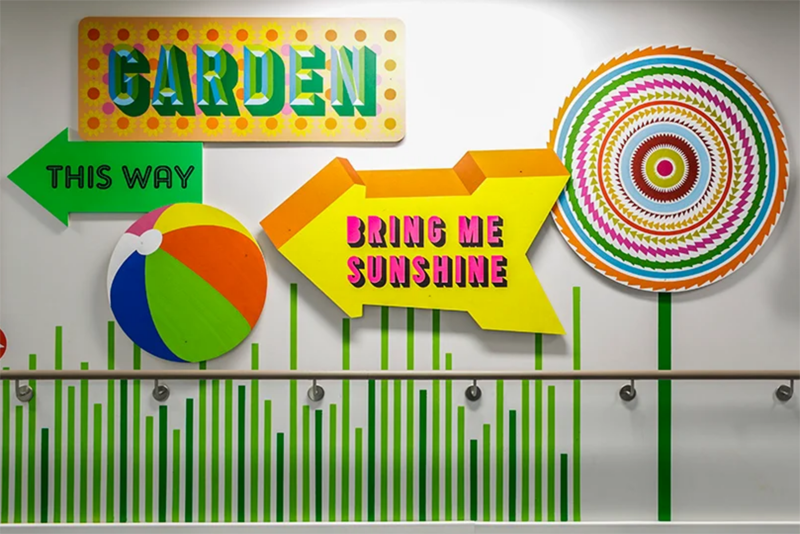 (images from designboom.com)
(images from designboom.com)
Getting back to the Bobbi Brown collab, I'm not sure how or why it came about. Nor do I know why she designed the patterns she did for the collection, or if she had an input on the makeup shades. I did reach out for an interview with the artist but didn't hear back. I will say I think her work translated well to the packaging, which can be tricky for artists who typically work on large-scale designs. But I'd love to hear Myerscough's thoughts on makeup colors, how makeup can help bring people together and why she took on the collaboration. She works primarily on big environmental graphics for community spaces and doesn't have a lot of commercial collabs – the only other thing with her work that you'd find in a store was a collection for Method cleaning products, and even that was part of the larger Sheffield hospital project – so I'm curious to know what attracted her to designing the packaging for a makeup collection. It's a bit inconsistent with Myerscough's usual commissions. Perhaps it's precisely how different it is that piqued her interest. In any case, the Bobbi Brown collection is not even mentioned on her website.
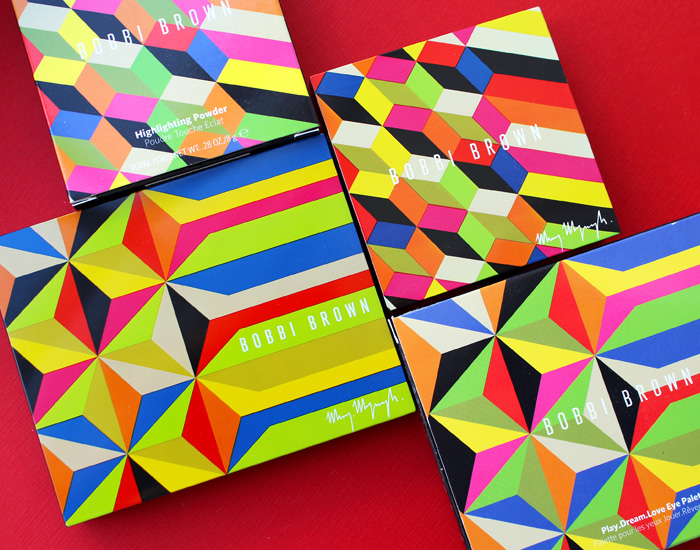
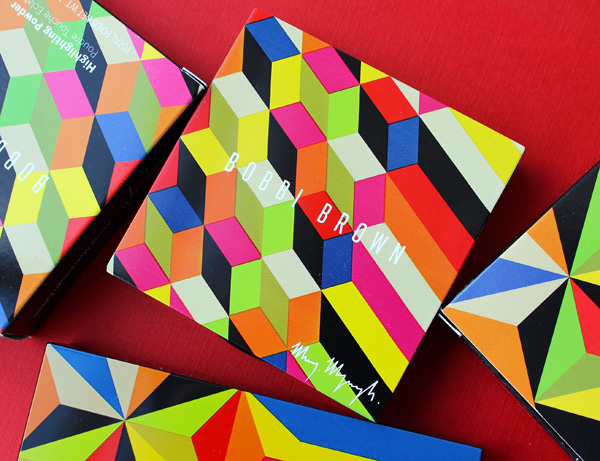
Thoughts on Myerscough's work? What does the makeup community mean to you? Do you feel as though you're part of it?
A few months ago I was perusing an auction site and came across this interesting-looking makeup case. As it turns out, it belonged to Hanna Rovina (1888-1980), a.k.a. the "first lady of Israeli theatre".
Originally a kindergarten teacher, in 1917 Rovina left her teaching job to pursue acting, becoming a founding member of a Hebrew theater group in Moscow that later became Habimah, the national theatre of Israel and the first professional Hebrew theater in the world. She became a leading actress after her breakout role as Leah in An-ski’s The Dybbuk in 1922. Rovina was soon renowned in the international theater community due to impressive performances that ranged from Hebrew productions to Shakespeare and classical plays across Europe and the U.S. Her stage makeup was fittingly dramatic, keeping with the style of the time. Historian Raphael Patai describes the "masklike" look Rovina used for the role of Leah in the 1920s. "Her face was powdered or painted chalk white, her black wig hugged her head and face, her eyes were framed with thin black lines, and the areas between her eyes and her thinly penciled-in black eyebrows, and even more so between the eyes and the ridge of her nose, were painted almost black…the only color livening up this somber black-and-white appearance was her mouth, painted blood-red in the form of a narrow double bow that is familiar to those who still remember the heroines of the early silent Hollywood films."
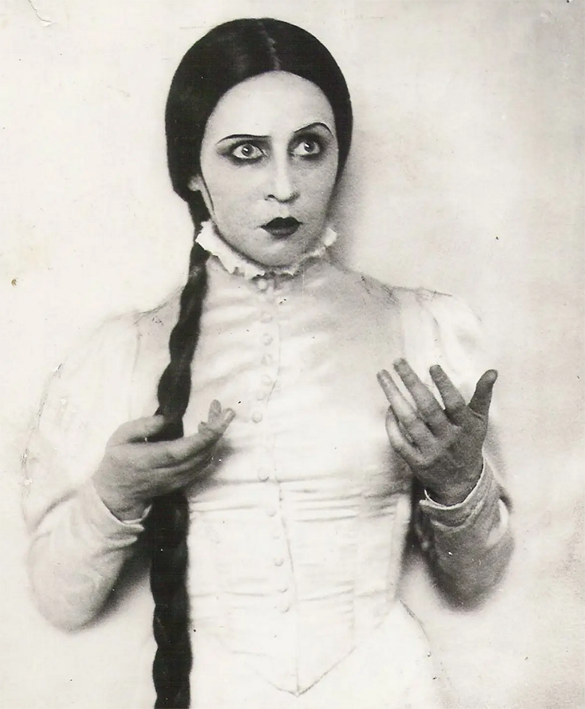
Her theatrical cosmetic style changed slightly from role to role, as seen in this 1955 photo of Rovina portraying Medea.
Love this shot of her dressing table, probably taken in the 1960s. There's a red jar on the far right that looks like it could be Leichner, but that seems unlikely. Beyond that, embarrassingly, I can't make out any of the items.
So why am I posting about Rovina and her makeup case today? Well, on this day in 1956, Rovina was awarded the prestigious Israel Prize for her contributions to Israeli theatre. As for the makeup case, judging from Rovina's dramatic stage looks and her dressing table, I can only imagine what treasures it holds! Too bad the keys to the locks are missing. But despite bidders not being able to see the contents – or even IF there was anything inside – the case sold at auction for $750, far exceeding the original sale estimate of $150-$200. I can only hope whoever the new owner is figures out a way to open it and publicly share what's in there, even if it turns out to be empty.
Had you ever heard of Hannah Rovina? What are your best guesses as to what's inside her makeup case? And if anyone can identify the items on her dressing table I'd love to know!
In an effort to condense a few posts I'm doing some quick reviews of recent additions to the Museum's library. Hopefully they'll be of use…I mean, they can't be any worse than my usual long-form reviews, right?
Up first is historian Cheryl Woodruff-Brooks's biography of Sara Spencer Washington, who established the Apex News and Hair Company in 1919. Over the years the company expanded to include 11 Apex Beauty Colleges in the U.S. (including one right here in Baltimore – more on that later!) and abroad, Apex Laboratories to manufacture hair care, cosmetics and even household goods, and Apex News, which produced publications for her estheticians and sales agents. The Apex empire, as it came to be known, employed roughly 45,000 sales agents at its peak. Madame Washington wasn’t just a savvy entrepreneur; she regularly gave back to the Black community by offering scholarships to Apex schools, establishing a golf course that welcomed people of all races and economic status, and even founded a nursing home, Apex Rest. Golden Beauty Boss: The Story of Madame Sara Spencer-Washington and the Apex Empire is relatively short but incredibly informative. I can only imagine how many hours the author spent digging through various archives.
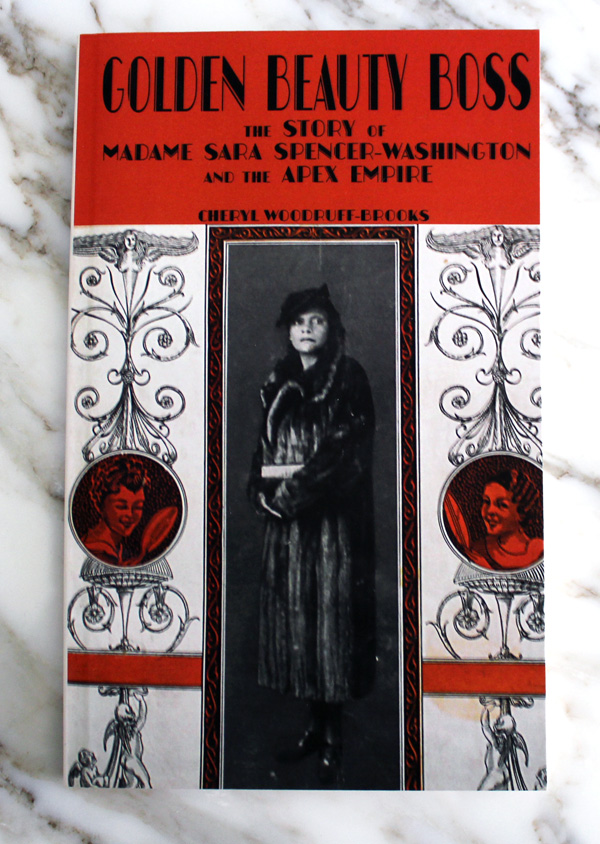
Quality research and an intriguing story about one of the most successful Black entrepreneurs in history is a must-have for well, anyone! You can buy it here.
Next we have Howard Melton's and Michael Mont's American Compacts of the Art Deco Era: The Art of Elgin American, J.M. Fisher, and Others. This isn't a collector's guide; it's more along the lines of Jean-Marie Martin Hattemberg's tomes on powder boxes and lipsticks in that there are many images of beautiful objects to drool over with some wonderful history along the way. It also includes a good amount of ads, which are very helpful in identifying compacts – of course, you can also see some Elgin compact catalogs over at the Elgin History Museum archives.
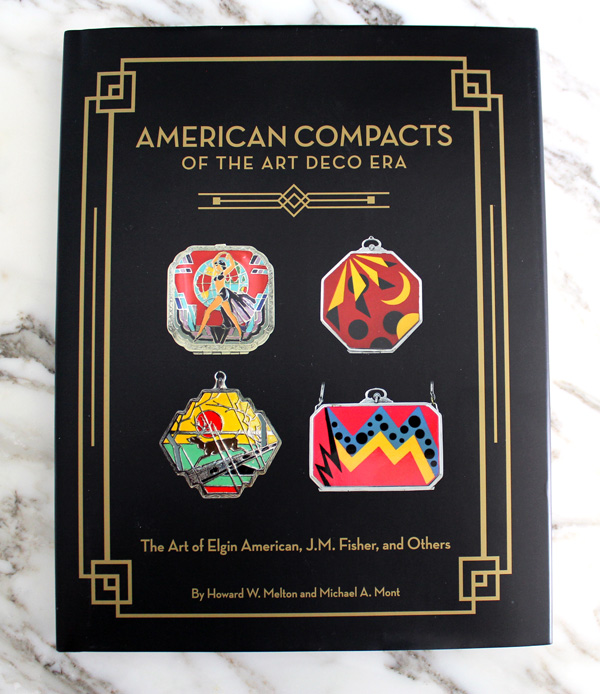
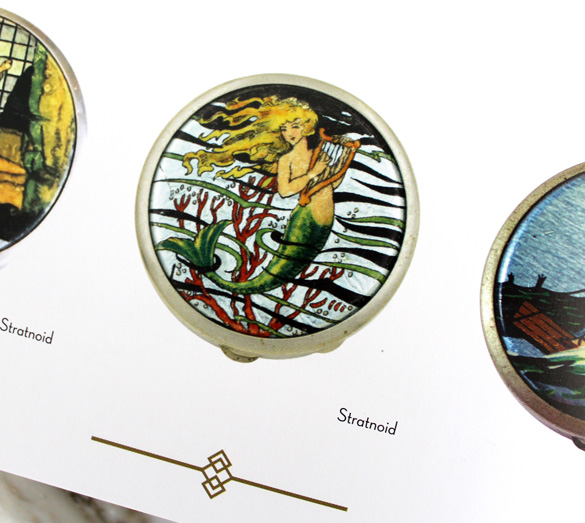
What I love about American Compacts is that it focuses on the compacts of a particular era and country so it's not overwhelming, yet still provides useful information throughout. The story of Elgin's Bird in Hand compact is a particularly great highlight. Overall, American Compacts is a necessity for the vintage makeup collector or anyone with an interest in Art Deco design. As for purchasing, you remember my interview with Andra of Lady-A Antiques, right? Well, she's offering this book at a reduced price at her store, so be sure to buy it there!
Moving along, I read Color Stories: Behind the Scenes of America's Billion Dollar Beauty Industry by journalist Mary Lisa Gavenas. It's a bit dated at this point since it was published in 2002, but still a good read as it provides a very fascinating behind-the-scenes, soup-to-nuts description of how makeup color stories were selected and marketed each season during the 1990s and early 2000s – essentially a full, unbiased story of the process.

It's very useful for anyone looking for cosmetic marketing history as well as '90s makeup history (ahem), but I think it would also be interesting for fashion or business historians more generally. I would dearly love to see an update for the age of social media, Millennials/Gen Z'ers and the increased demand for diversity and inclusion among beauty consumers. So much has changed in 20 years!
Next up is another drool-worthy book I found on ebay. It's in Japanese so I can't actually read any of the text, but the photos are more than worth it. You'll find lots of vintage Shiseido and other Japanese brands along with a sprinkling of Western lines such as L.T. Piver packaged for the Japanese market. While powder boxes, skincare and perfume comprise most of the objects, there's also personal hygiene products like deodorant and tooth powder.
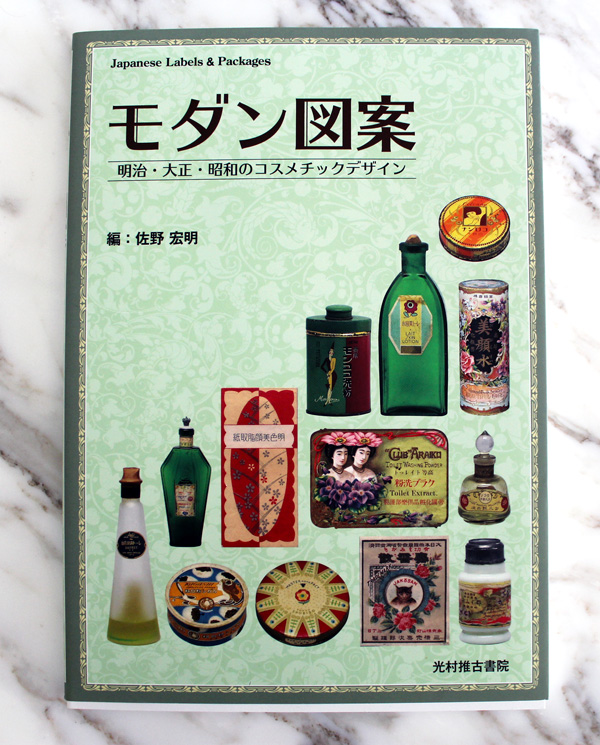
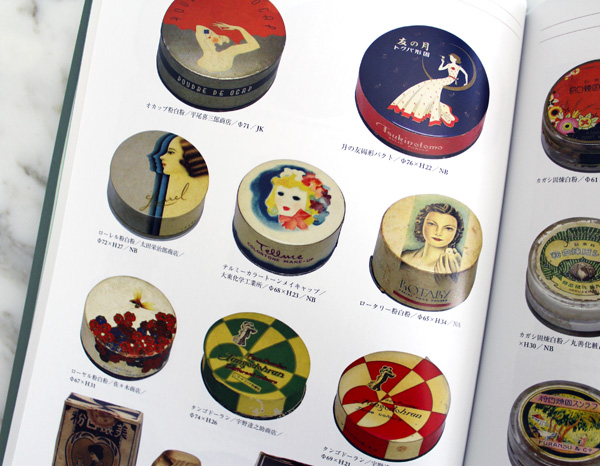
If you love vintage powder boxes, vintage design and typography, or Japanese culture in general, this belongs on your book shelf. I'm keeping my fingers crossed for an English version so I can read the history behind some of the brands that are covered.
Finally, there's Lucky Lips: Stories About Lipstick, written by René Koch (a.k.a. the founder of the Lipstick Museum.) When I purchased the book I mistakenly thought it had English text alongside the German. Oops. Still, it's a nice supplement to Jean-Marie Martin-Hattemberg's Lips of Luxury as it contains different vintage lipsticks, some of which I hadn't seen before.
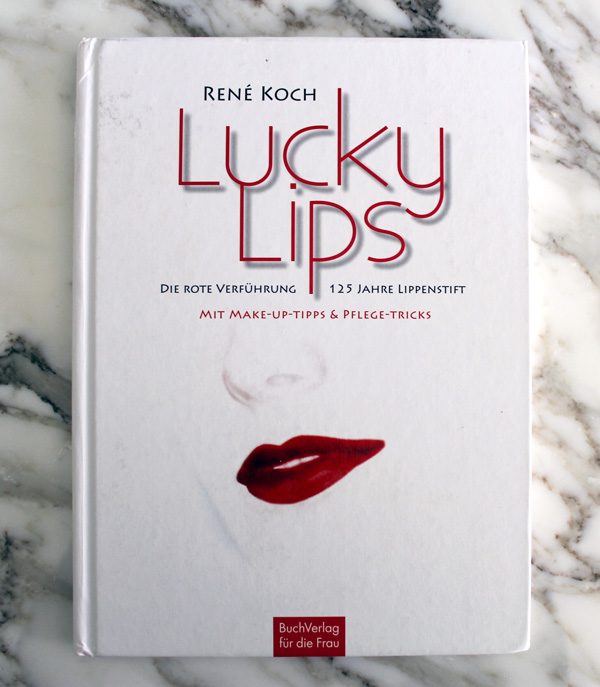
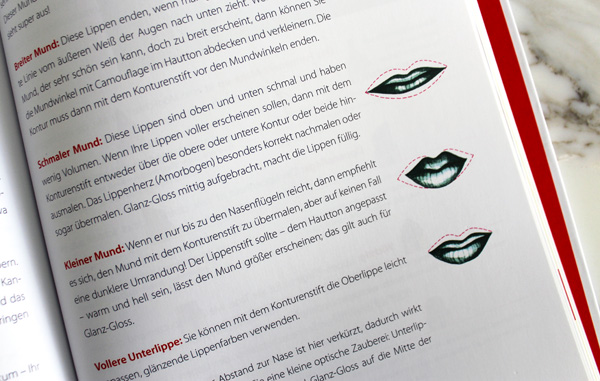
I wish I could compare the information offered in both books, but at the very least I can tell that Lucky Lips has some tips on lipstick application and 20th century lipstick history organized by decade. Overall, it's good to have on hand and a quality addition to the vintage makeup collector's library, especially if you can read German. (I've said this before, but if I could have any superpower it would be fluency in all languages within a matter of minutes.) If you had to choose between this one and Lips of Luxury, however, I'd go with the latter as it's a bit more extensive.
Are you interested in any of these? What books, beauty-related or otherwise, have you finished recently?
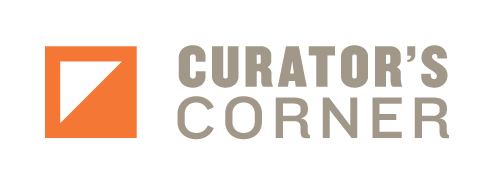 Links for a busy February.
Links for a busy February.
– It was Black History month, so that means major companies (Ulta, Sephora and Nordstrom, among others) are rolling out new diversity and inclusion initiatives. Time will tell whether they're in earnest or just crossing some items off their lists for Black History month.
– Other anti-racism agendas within the industry include speaking out against anti-Asian racism and skin whitening.
– The Washington Post reports on the serious side of a viral TikTok beauty mishap. (Turmeric face mask staining is funny though.) Overall, I still hate TikTok but this was also an interesting read.
– Other things besides TikTok making me feel ancient: Chanel's new lip scanner and Clubhouse.
– I'm still wary of anything claiming to be "green," but refillable luxury packaging is something I can get behind.
– So sad to see Becca go. But Burberry's cool star makeup helped take the edge off, along with this adorable palette ring.
– Another reminder for me to update my post on faux freckles.
– This new book about the history of men's facial hair and grooming is on my wishlist.
– I had lots of new Museum acquisitions for the various celebrations in February, so here are some Instagram highlights.
Lunar New Year picks:
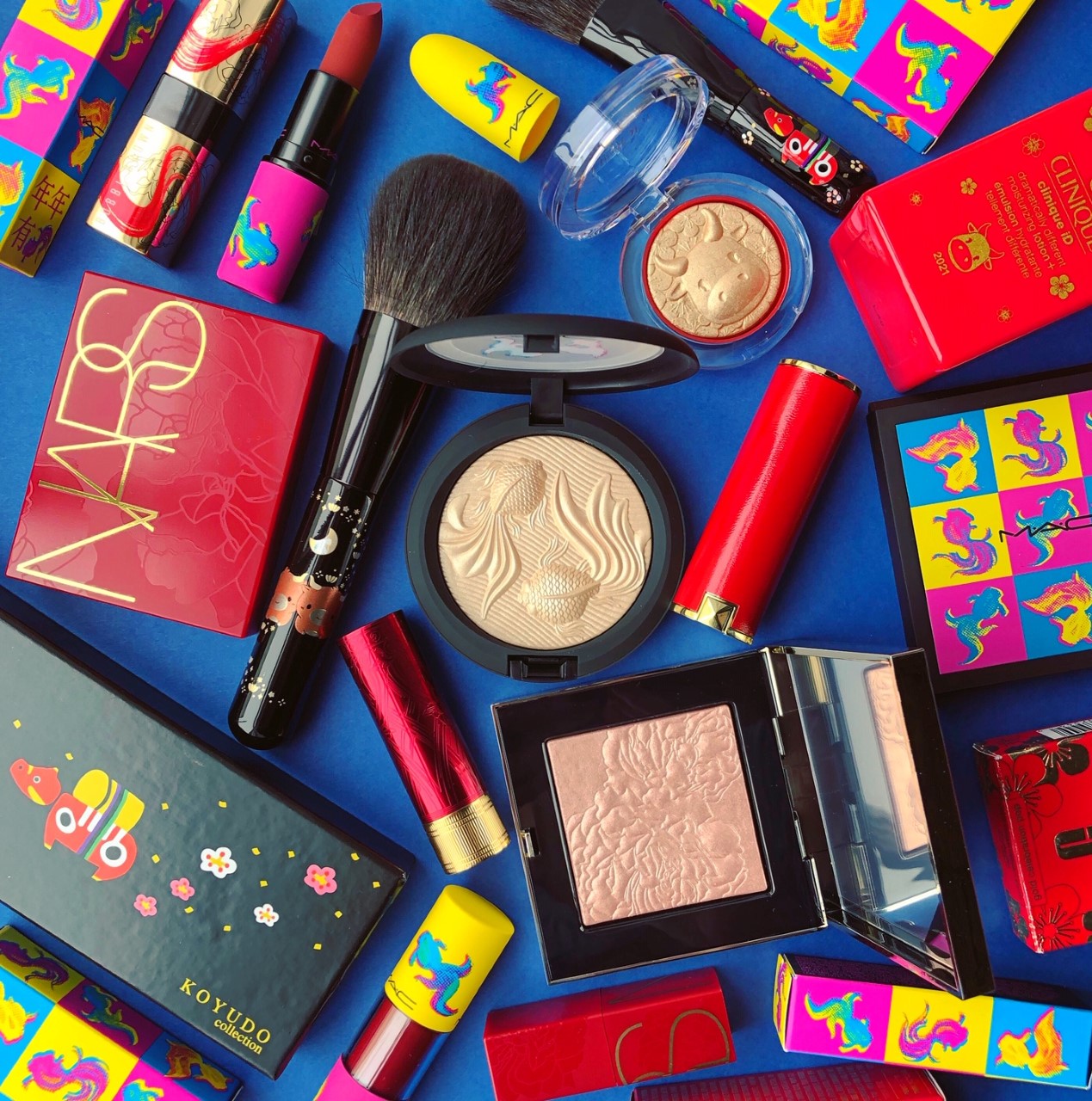
Mary Quant crayons in honor of her birthday:
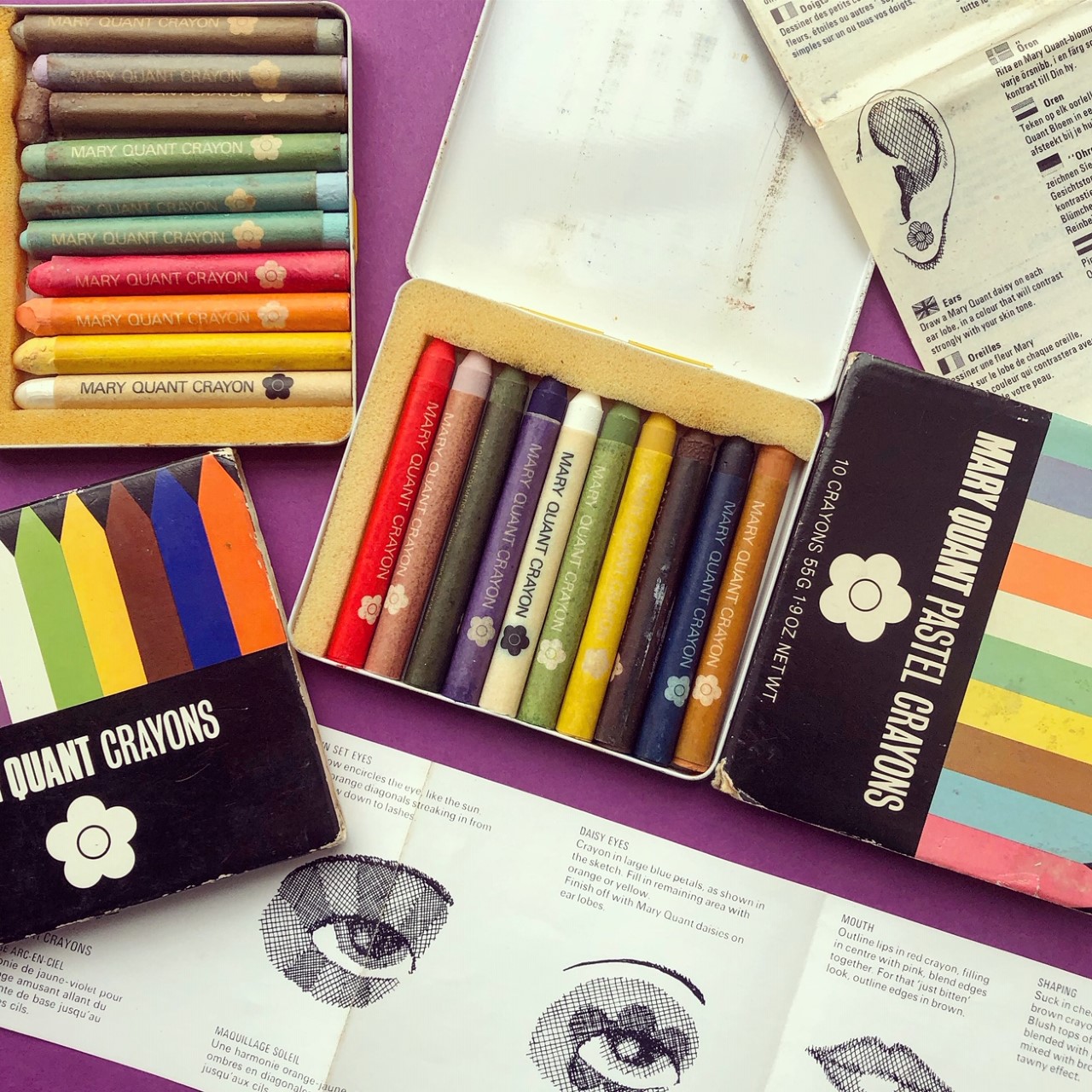
Valentine's Day picks:
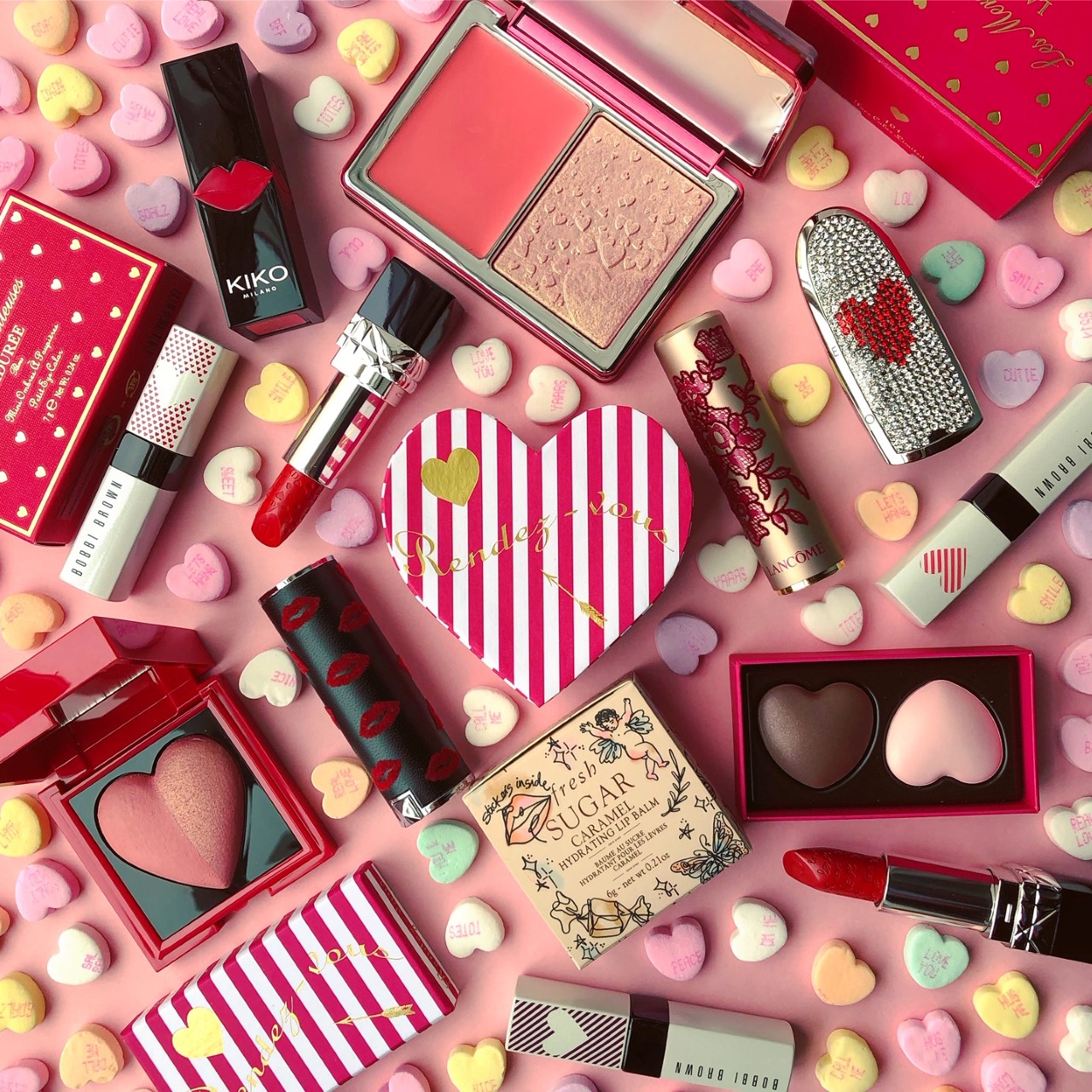
Twiggy lashes for National Lash Day:
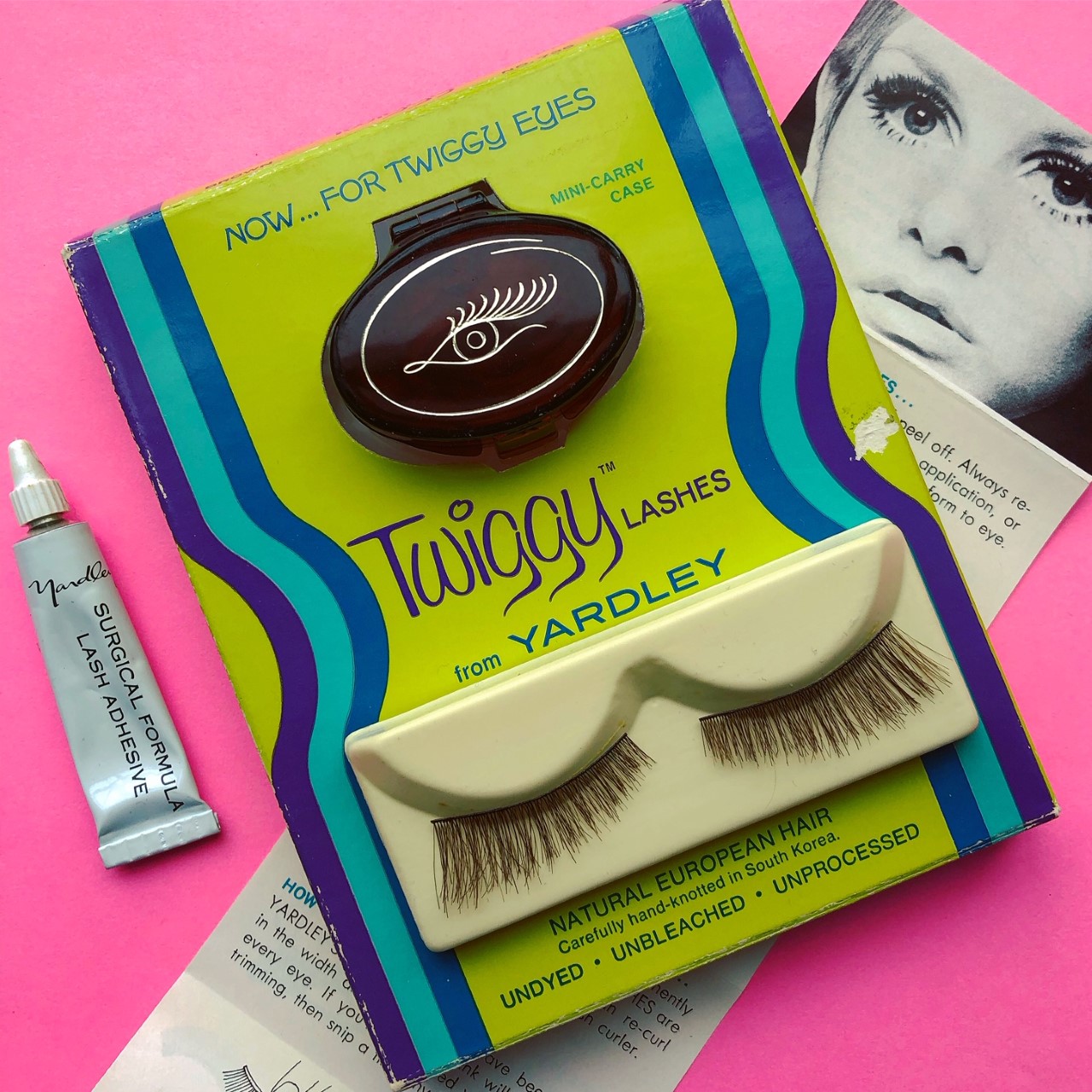
The random:
– It was '90s week at Jezebel so you know I was all over that. My favorite article involved the mystery of the oversized yet flattering suits worn by X-Files' Dana Scully.
– Some reflections on Linda Nochlin's groundbreaking essay "Why Have There Been No Great Women Artists?", which turns 50 this year.
– HBO has an interesting-looking documentary on influencer culture.
– On the local front, I must thank my friend Ally for alerting me to these painted salt boxes in Baltimore. I wish there were some in our neighborhood!
How have you been? Are you looking forward to spring?
While hunting for vintage Christmas makeup a few months ago I stumbled across a brand from the 1960s called Holiday Magic. This won't be a complete history either of the brand or the man who founded it, but it's one of the most compelling (for all the wrong reasons). Buckle up because you're in for a truly wild ride!
In 1964, a California salesman by the name of William Penn Patrick (b. March 31, 1930; d. June 9, 1973) noticed a neighbor having a garage sale of organic fruit-based cosmetics called Zolene. Sensing a new business opportunity, Patrick bought the entire stock for $16,250 (or about $137,000 today). Re-branded as Holiday Magic, Patrick proceeded to start selling them as a multi-level marketing business (MLM). Now, MLMs for cosmetics and other goods had been around for many years prior to Holiday Magic, such as Avon, Mary Kay, Watkins, Fuller Brush, etc. While their ethics are murky – on the one hand it gave people jobs and products that they otherwise wouldn't have access to, on the other they require fairly unsavory tactics – they are not technically against the law. But Holiday Magic wasn't just your average MLM: it was possibly the biggest pyramid scheme prior to Bernie Madoff.
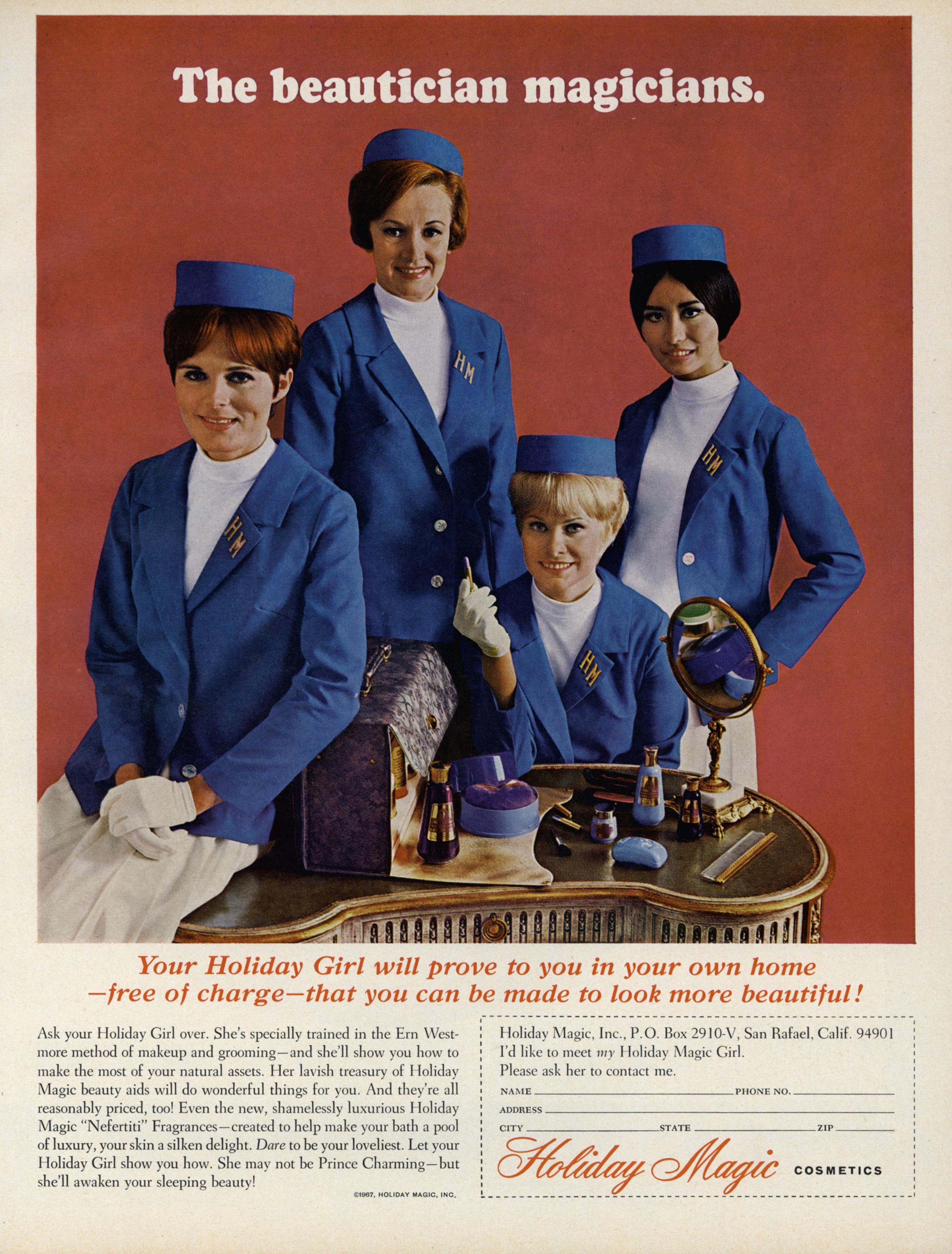
Within a year of its launch, Holiday Magic had made Patrick a millionaire, and by 1967, the company was allegedly earning $6 million per month. The makeup products were quite average – nothing appears to be innovative about them. There was the standard eyeshadow, eyeliner, mascara, brow pencil, lipstick and blush. I would have had my own photos but I have no idea what happened to the objects I purchased from eBay, which sadly has become the norm these days. (It looks like tracking information was prepared but the package never was actually mailed. I've contacted the seller numerous times and have yet to receive a reply, let alone a refund. I guess William Penn Patrick is still working through others to scam customers from beyond the grave.)
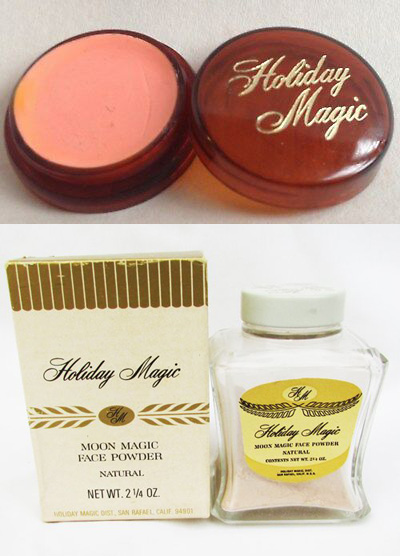
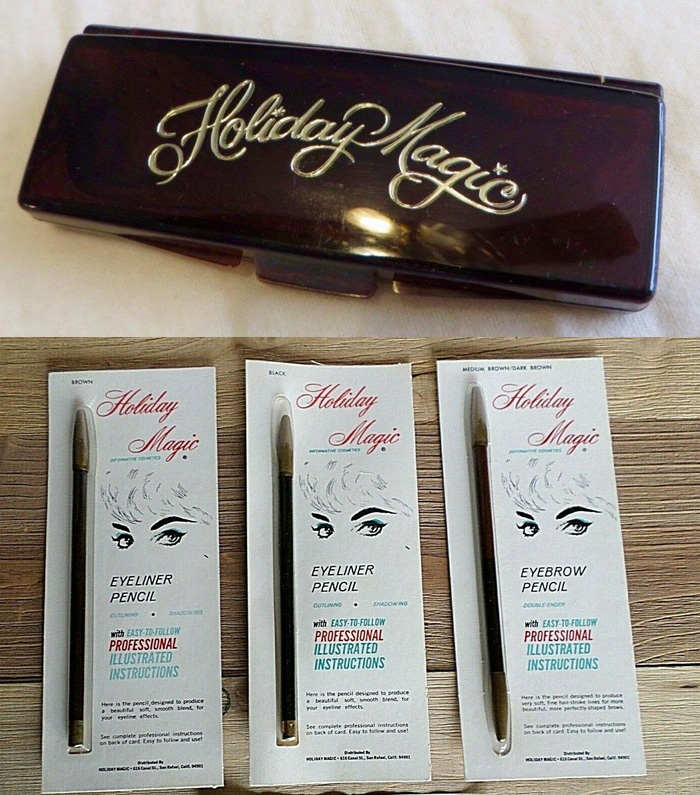
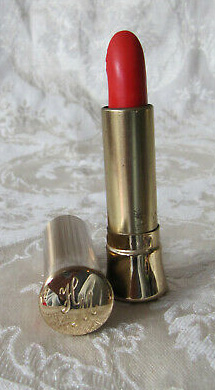
The only thing of interest makeup-wise was the connection to the House of Westmore. The details aren't clear, but it seems Ern Westmore allowed his facial exercises to be used by Holiday Magic, which may have given an air of legitimacy to the brand.
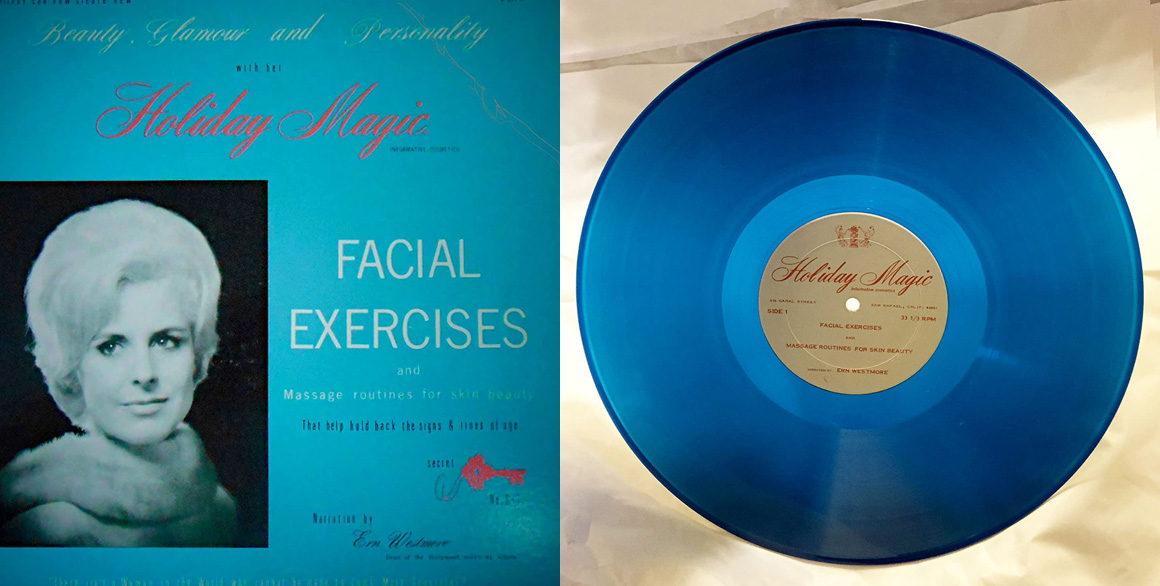
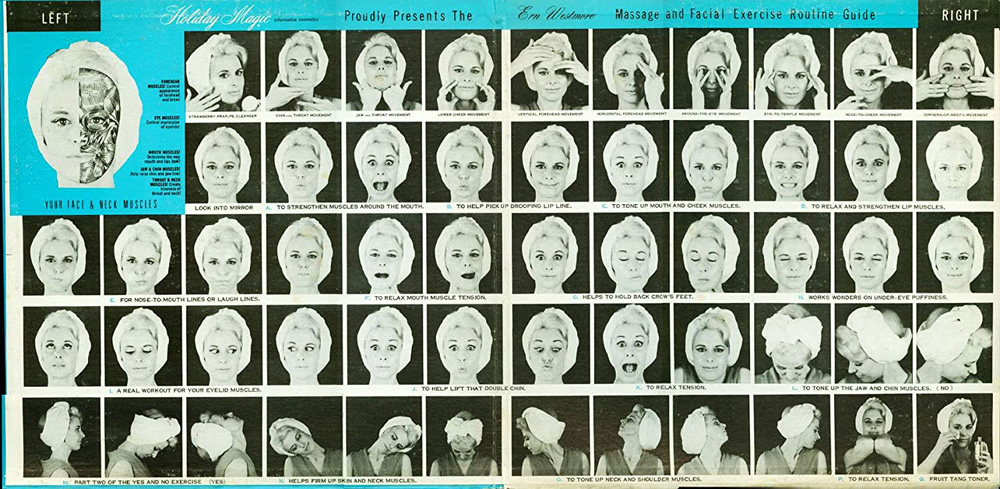
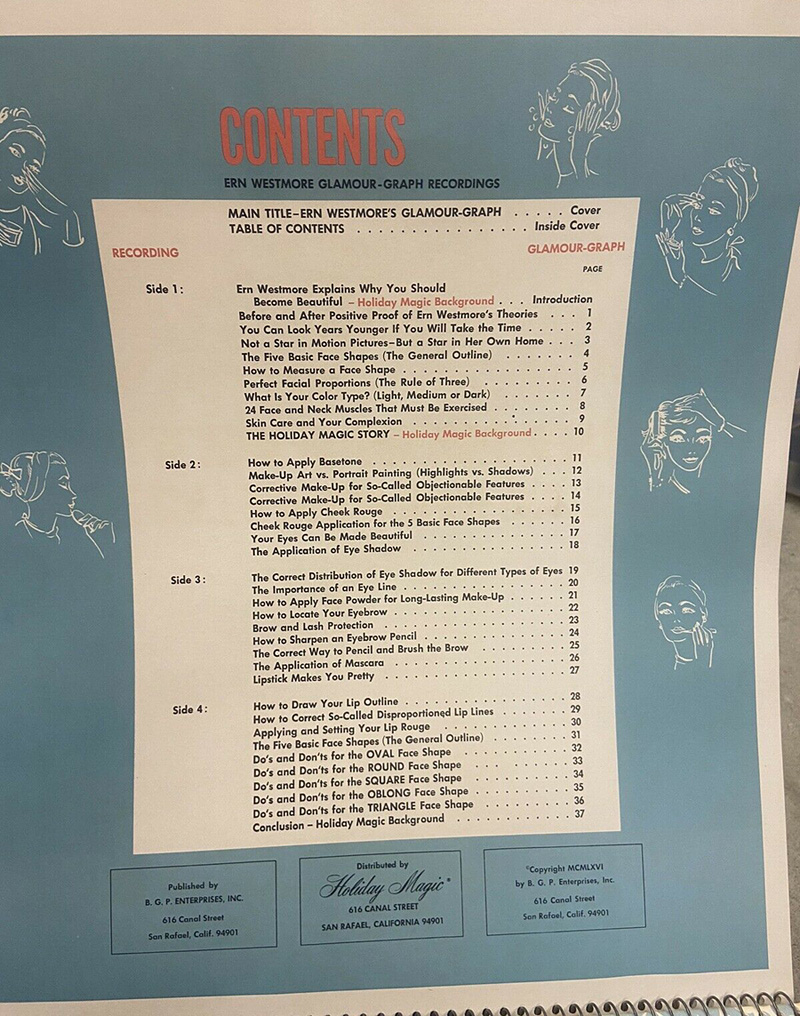 (images from ebay and amazon)
(images from ebay and amazon)
While the makeup itself wasn't all that groundbreaking, the fruit-based skincare was fairly ahead of its time. The two women who founded Zolene, Helene Fly and Zoe Swanagon (hence the company's moniker, a combo of their first names), were committed to using fresh ingredients without preservatives, and did a lot of research on skincare recipes that had been circulating quite literally for centuries. They were even writing a cosmetics history book!
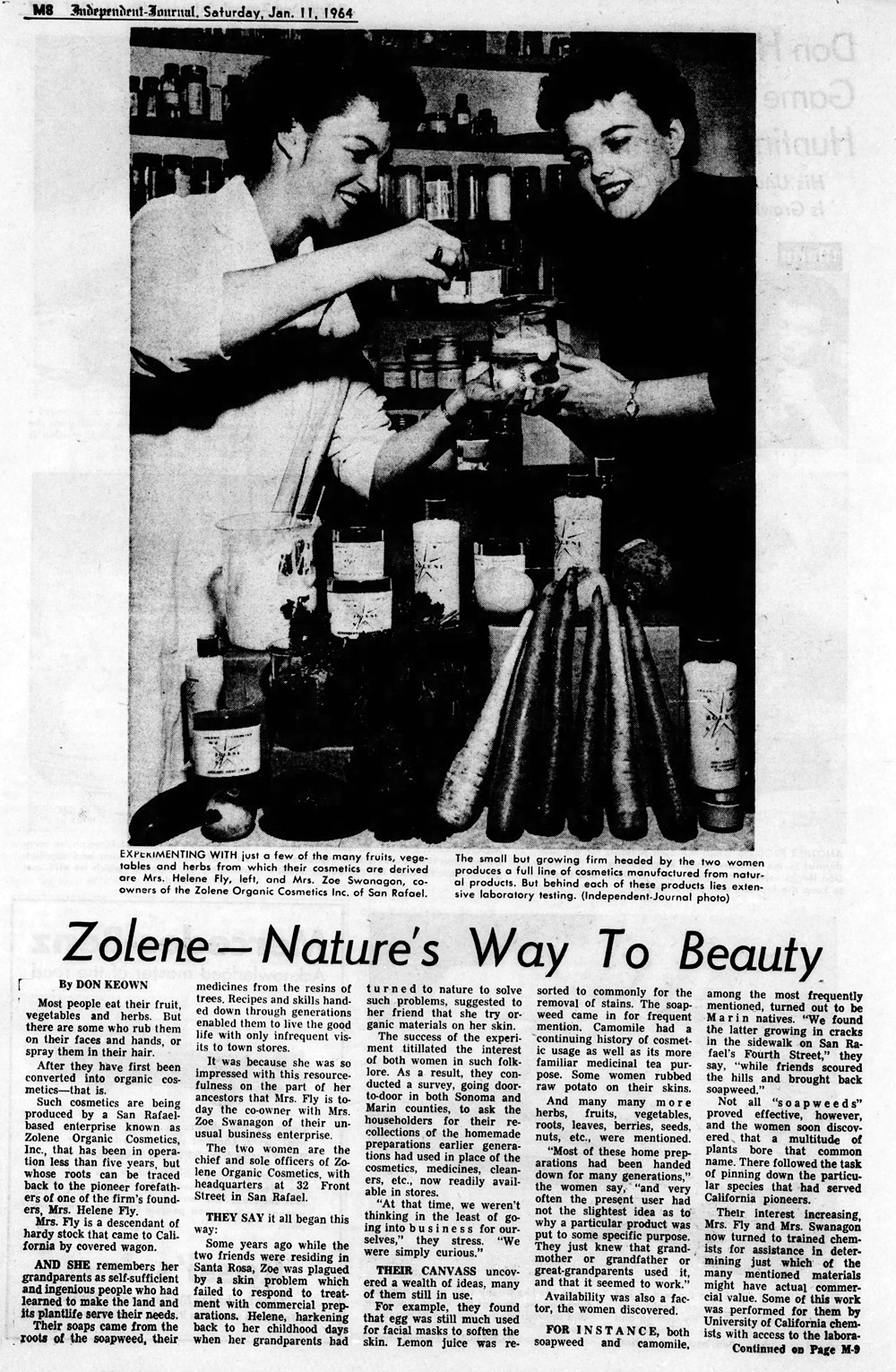
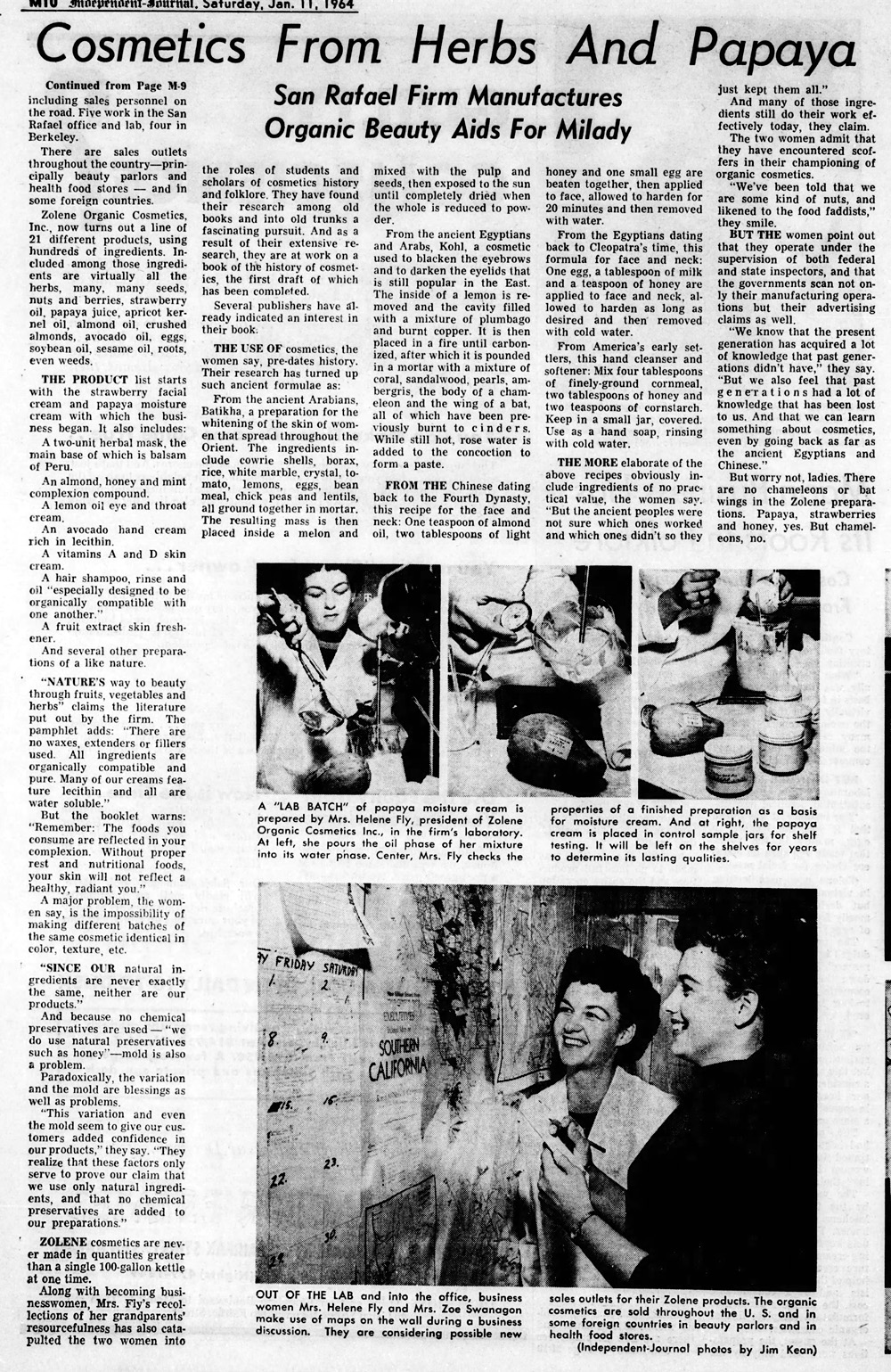
A lot of their products remind me of LUSH or 100% Pure's offerings. And I really wish I could find them, I love the Mid-Century Modern star packaging. Anyway, Zolene continued to supply Holiday Magic with its concoctions until 1967 when the founders became aware of Holiday Magic's business practices. But the company's lack of innovative makeup did not deter it from making a fortune for Patrick. In pyramid schemes, profit is not made by selling products but rather recruiting more salespeople – the products themselves have nothing to do with how the money is made, so it doesn't matter if they're any good. According to The Snapping Point, a website about business scams, the four characteristics that separate pyramid schemes from MLMs are:
- the only way for consultants to make a profit is to recruit other consultants.
- consultants are required to ‘inventory load’, or constantly inventory to profit.
- consultants are operating in a ‘saturated market’, or a market where there are more sellers than buyers.
- consultants are required to sell products for a fixed price (‘price-fixing’).
This book explains it in more detail. Basically, the only way for sales reps to make money was not by selling products but through essentially "buying" more sales people, convincing them to make an "investment" in the company. Unlike regular MLMs, where by the majority of product purchased by sales reps is actually sold to customers, in pyramid schemes most of the product does not reach them. In Holiday Magic's case, in 1967 it was estimated that 55% of their product was not distributed to customers, with sales reps having entire garages full of makeup. In 1973, an FTC attorney stated that he could find no evidence of products being sold directly to customers, only to "master" and "general" distributors, while the former president of Holiday Magic, Benjamin Gay, testified that less than 10% of products sold to distributors ever reached customers. "There could be sawdust in those jars. The cosmetics were there as a front," he said. The way in which Holiday Magic's hierarchy was arranged, Holiday "girls" could invest $18.91, "organizers" $109.71 to $501, "master" distributors $4,500 (plus a $250 training fee that was never mentioned until the investor signed the contract), and "general" distributors $8,750, plus training fees.
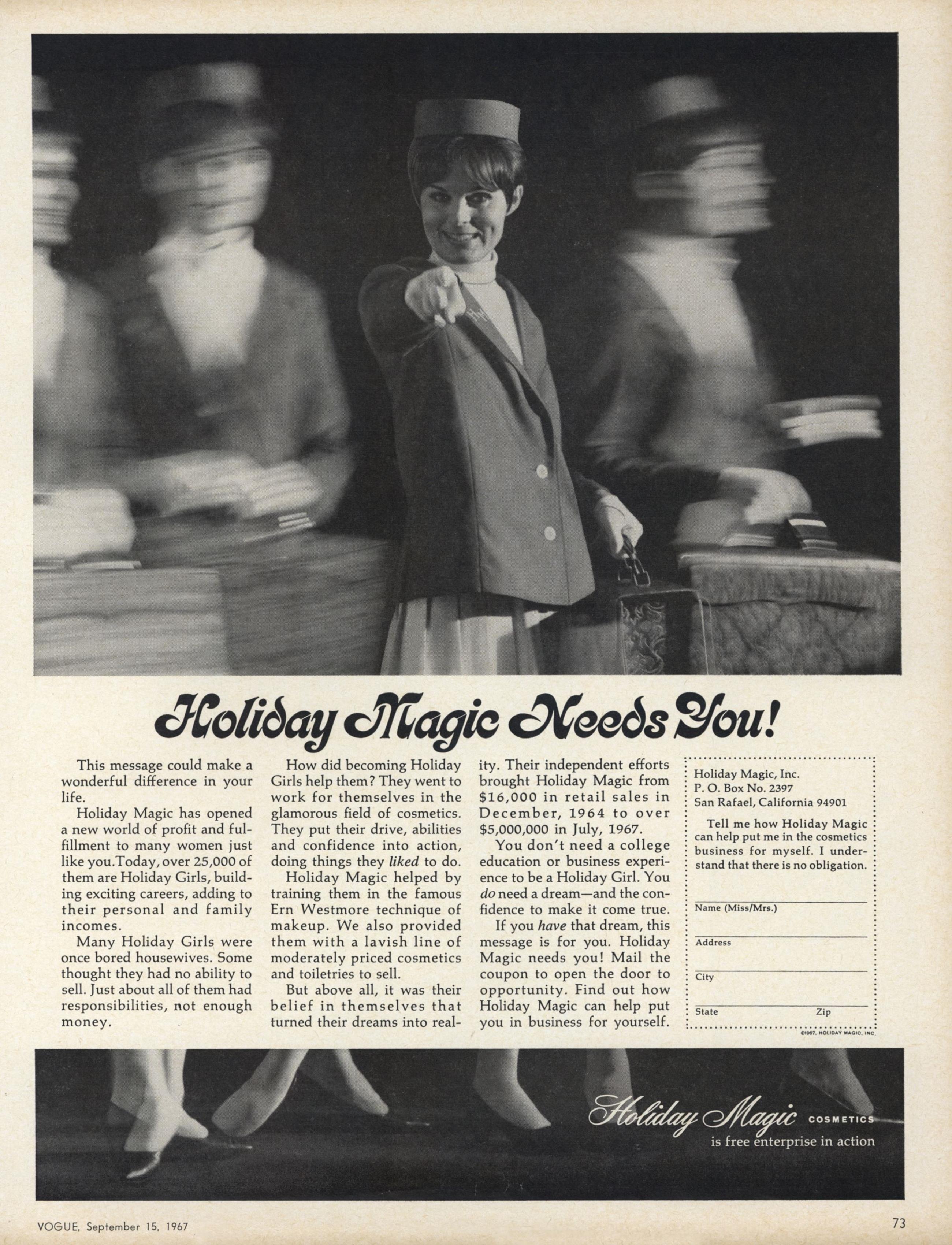
(image from archive.vogue.com)
In addition, Patrick was known for other aggressive, highly immoral practices that went beyond pyramid selling. While Holiday Magic did not officially go bankrupt until 1974, as early as 1967 the company was charged by the California State Attorney General's office for "false and misleading advertising" in which the ads claimed distributors could make roughly $2200 a month (or $18,600 nowadays) working full-time. In retaliation, he took out full page newspaper ads attacking the state attorney general. Basically, any time the company faced a legitimate lawsuit, Patrick would double down and countersue, claiming that his constitutional rights were being violated. But the coup de grace was Leadership Dynamics, a "training institute" for Holiday Magic representatives established by Patrick and then-company president Gay in 1967. Sales agents were not required but "encouraged" to take a training course for a mere $1,000, while those higher up on the pyramid were required to take courses there. However, Leadership Dynamics was not so much training as it was torture; according to a 1972 exposé entitled The Pit, among the many cult-like techniques used to humiliate and brainwash sales reps were severe beatings, being locked naked in cages or tied to a cross, forced to sleep in coffins and, of course, racial slurs hurled at the Black attendees. I'm not sure how much of the book is true, but several newspaper articles as well as an article in Newsweek detail the abuse and numerous lawsuits brought about by attendees who supposedly sustained serious injuries.
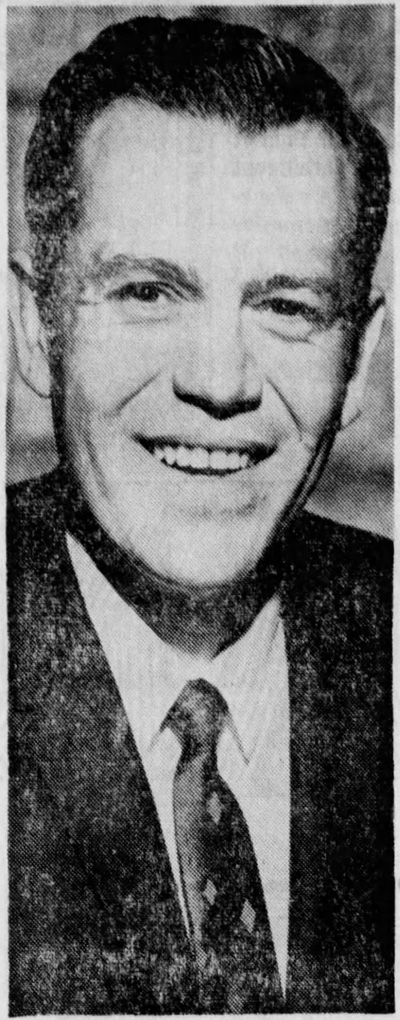
The exceedingly punchable face of William Penn Patrick.
Patrick also dabbled in politics, running against Ronald Reagan in California's 1966 gubernatorial race as an "ultra-conservative Republican" with the slogan "Stop the Commies at Cal". Gee, color me shocked that a money-hungry narcissist was the complete opposite of liberal. His political views are not surprising; many rich white mediocre men truly believe the conservative myth that success is due to hard work (bootstraps!) and brilliance, rather than their own privilege, dumb luck or directly screwing over other people. Indeed, as one former Holiday Magic employee reminisced in 2016, "The whole organization (or lack of) was absolutely bizzare [sic], run by a bunch of frat boys with not a business degree among them. But they had a Phd in pyramid schemes." A couple of other tidbits:
- In 1967, as president of the "Victory in Vietnam Committee" he attempted to run a recall campaign against an Idaho Democratic Senator, because you know when Democrats win an election it's because they stole the race (insert eyeroll here). When the AFL-CIO organized a boycott of Holiday Magic, Patrick promptly sued them.
- His wife, Marie, was going to be a doctor but abandoned her plans shortly after marrying him to work as a teacher, largely to support them both after Patrick's string of failed businesses. Once Holiday Magic achieved success, she began attending meetings with Patrick because "otherwise, I'd never see him".
- On September 24, 1972, one of Patrick's vintage planes, an F86 Sabre piloted by the general manager of Spectrum Air (another company owned by Patrick) crashed into an ice cream parlor shortly after takeoff. The pilot escaped with a few broken bones and scratches, while 22 on the ground died, including 10 children. Patrick wasn't directly responsible, but the fact that he allowed it to be flown speaks volumes about his complete disregard for others.
- On June 9, 1973, Patrick died in a crash while performing stunts on another one of his vintage jets, a WWII plane called a P51 Mustang that, again, any regular citizen should not have had a license to own, let alone fly. He also managed to kill a colleague who was in the plane with him, a 30 year-old director of Holiday Magic in Finland named Christian George Hagert. SMDH.
A few months after his death and a spate of lawsuits in multiple states, as well as a $5 million suit from Avon, Holiday Magic's new president, along with Patrick's widow, announced that the line would be sold "along conventional marketing lines" and get rid of the pyramid aspect of their sales. They also promised a "fair" method of reimbursing roughly 3,000 of the Holiday Magic distributors in California who had been swindled. The SEC's ruling earlier that year claimed that 80,000 individuals had been bilked out of $250 million, so it's not clear what happened to the other 77,000 people who were ripped off. In May 1974 there was a class action settlement of over 31,000 members that established a trust fund of approximately $2.6 million, but that's pennies compared to the actual amount investors lost. Even in 1980 people were still writing to their local paper about the various lawsuits that had been filed and whether they'd get their money back.
But the big issue I wanted to highlight in this sordid tale is the fact that Holiday Magic seemed to have actively sought out Black communities in the U.S. to recruit distributors. While some other MLMs such as Avon, Fuller and Watkins targeted Black sales reps and customers, in their cases it seemed to be more a matter of expanding their market reach and at least supplying steady jobs rather than overtly preying on marginalized people. (Stay tuned for more about Black people's roles in various MLM cosmetic companies.)
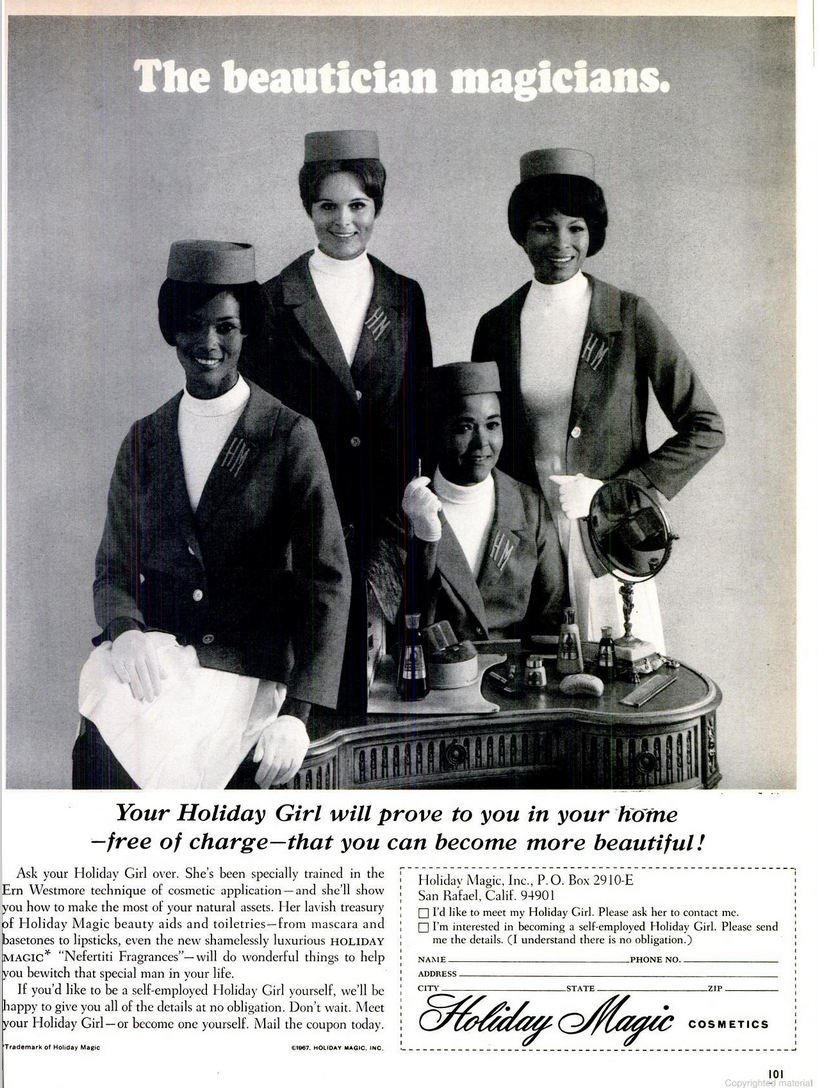 (image from books.google.com)
(image from books.google.com)
I really wish I could find some numbers to further support my theory, but it appears the scheme disproportionately affected Black and other POC investors. "The real tragedy is that Holiday Magic appeals to minority people who want to get rich," remarked SEC staff lawyer Louis F. Burke. Patrick bragged in 1968 that 2 of his top 6 distributors in the U.S. were Black, but even if that were true, it's not necessarily a good thing. As a former distributor noted, Holiday Magic's setup was "like being thrown into a dark pit. The only way you can get out is to drag another person into the pit and step on his shoulders." For the most part, Black customers would only be further disenfranchised if they bought into Holiday Magic. As if that's not bad enough, the company didn't even attempt to formulate any products for deep skin tones. As one wise Black would-be Holiday Magic salesman pointed out in 1975, the line was intended for white people: "Holiday Magic packaged cosmetics for fair-skinned people. Now why in the world would I want to sell light lipstick to Black women?" At least Avon tried to come up with products that would be suitable for Black customers.
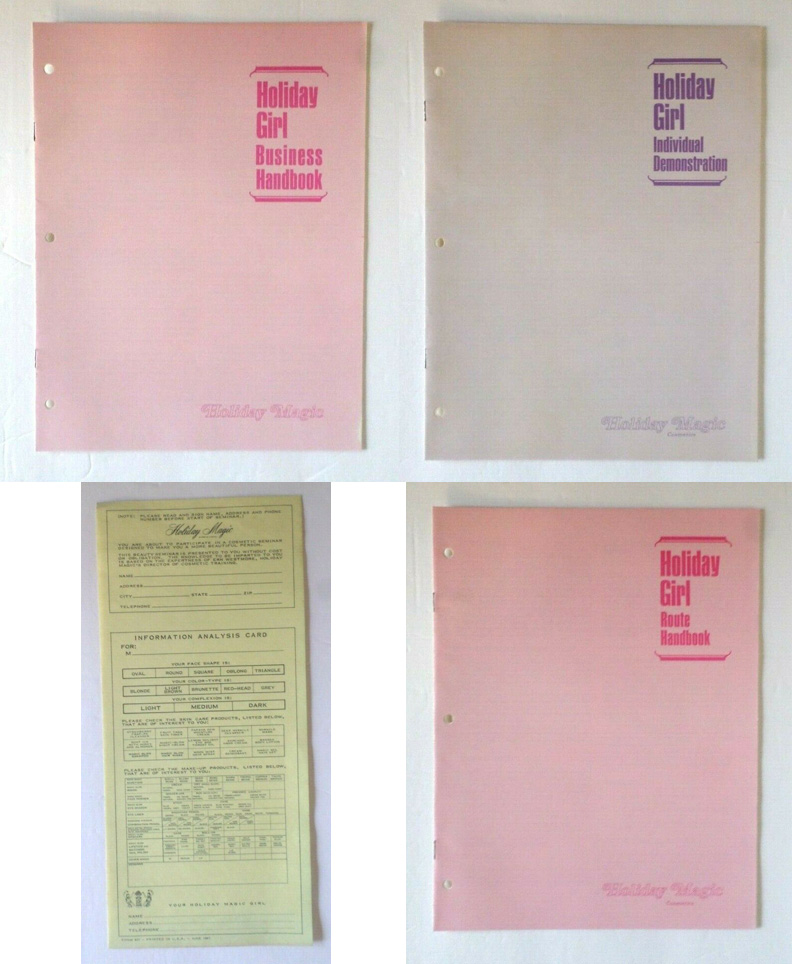
(images from ebay)
In the UK, it's estimated that the West Indian community lost £33 million in the early 1970s, and 26 people committed suicide after losing everything. These figures are somewhat corroborated by a British publication called Grassroots, which in 1974 reported that Holiday Magic targeted "almost exclusively West Indian and Asian communities" in the Midlands region. It's incredibly heartbreaking considering that people were taking out second mortgages on their homes to sink £1,000 into becoming a Holiday Magic distributor, only to end up paying at least double that in the long run and ending up far worse off financially than they were before. Note: I know nothing about this Grassroots publication and have no idea how reliable it is, but I don't think their claims are completely baseless.
It was obvious early on that Patrick was going beyond an MLM and into pyramid scheme territory along with the other illegal sales tactics, yet Holiday Magic was being advertised nationally in well-known publications as late as 1969, and still being sold in pyramid form through 1973. (A new Holiday Magic line with a less deceptive sales model was sold through the mid-'80s.) Perhaps it was a combination of systemic racism and his unbridled wealth that Patrick's sham wasn't stopped before it did so much damage. Maybe if he targeted only wealthy white people he would have been shut down sooner? Then again, Madoff did just that for about the same amount of time.
Anyway, despite what the show's creators say, I think the short-lived TV series On Becoming a God in Central Florida was based mostly on Holiday Magic – even more so than Amway. Everything, from the cult-like behavior and "motivational" mantras spewed by Patrick to the garages full of product and targeting of BIPOC communities has an uncanny resemblance to Holiday Magic.
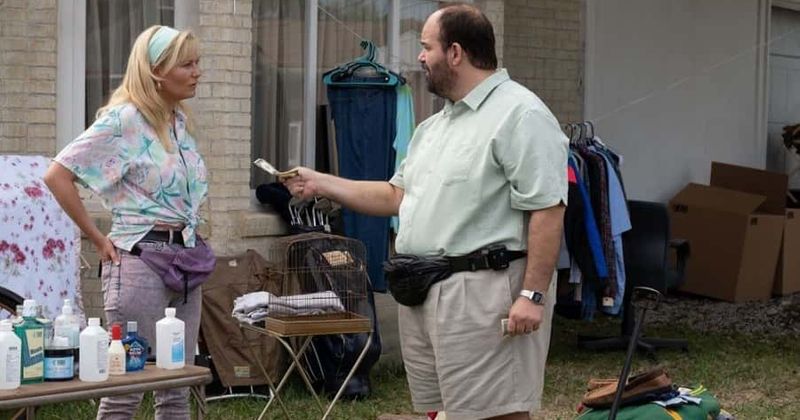
(image from meoww.com)
Thoughts? Had you ever heard of this brand? I promise I have a much more positive story on the way. 😉
Sources: In addition to the links throughout this post, here are some newspaper articles used.
"Holiday Magic Inc. Offers Tasty Cosmetic Products," Asbury Park Press, September 17, 1967.
"The Real William Penn Patrick," Daily Independent Journal (San Rafael, CA), December 28, 1968.
"Cosmetics Firm Files Suit Against Competitors," Harford Courant, May 18, 1972.
"'Torture Training' Basis for Suit by Students," Associated Press, August 16, 1972.
"22 Die as Ex-Fighter Jet Hits Ice Cream Parlor," Chicago Tribune, September 25, 1972.
"Patrick Hit With $5.2 Million Suit," Daily Independent Journal, October 19, 1972.
"Holiday Magic Hit With Two Big Suits," Daily Independent Journal, February 22, 1973.
"4.2 Million Suit Names Patrick," San Francisco Examiner, March 19, 1973.
"The Magic Pyramid," Daniel Grotta, The Philadelphia Inquirer, April 8, 1973.
"William Penn Patrick, Cosmetics Millionaire, Dies in Plane Crash," The Fresno Bee, June 10, 1973.
"Quiet Helpmate at Patrick Empire Helm," Daily Independent Journal, August 1, 1973.
"20.3 Million Suit Against Patrick Firm," Daily Independent Journal, September 29, 1973.
Makeup Museum (MM) Musings is a series that examines a broad range of museum topics as they relate to the preservation, research and exhibition of cosmetics, along with my vision for a physical Makeup Museum. These posts help me think through how I'd run things if the Museum occupied a physical public space, as well as examine the ways it's currently functioning. I also hope that these posts make everyone see that just because the Makeup Museum does not have a physical space or official nonprofit designation, it is as valid as other museums, and more legitimate than many other profit-driven entities calling themselves "museums".
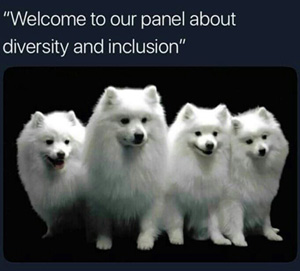 Let me just say up front that the timing of this post has nothing to do with the Capitol insurrection that took place a few weeks ago, or the fact that Black History Month starts in two days. This is something that's been in the works for over a year, as it's extremely important to the Museum's mission and to me personally. After giving myself a crash course in diversity and inclusion, I feel as though I'm finally ready to write something a little more in-depth than the thoughts I jotted down back in June 2020. One of the Museum's primary goals is to present makeup and its history differently than what currently exists, and a big part of that is sharing previously undiscovered or underrepresented stories. So many of them concern BIPOC and LGBTQ+ histories, and it's important to tell them not just for diversity's sake but for history more generally.
Let me just say up front that the timing of this post has nothing to do with the Capitol insurrection that took place a few weeks ago, or the fact that Black History Month starts in two days. This is something that's been in the works for over a year, as it's extremely important to the Museum's mission and to me personally. After giving myself a crash course in diversity and inclusion, I feel as though I'm finally ready to write something a little more in-depth than the thoughts I jotted down back in June 2020. One of the Museum's primary goals is to present makeup and its history differently than what currently exists, and a big part of that is sharing previously undiscovered or underrepresented stories. So many of them concern BIPOC and LGBTQ+ histories, and it's important to tell them not just for diversity's sake but for history more generally.
This post will not go into detail regarding the obvious facts that 1. Despite good intentions, all museums are rooted in colonialism; 2. U.S. museums have a critical diversity problem; and 3. Diverse and inclusive museums are better in every way than non-inclusive spaces. Instead, it seeks to answer the following question: How can the Makeup Museum, in its current state, be as diverse and inclusive as possible? I don't have all the answers, but MM Musings are an exercise to think through the heavier issues and ponder how the Museum can be better – more of a journey than an endpoint. To help guide this installment of MM Musings I relied on these two books, along with the anti-racism books I purchased last year. I also looked at all the articles and other resources I could access for free online.
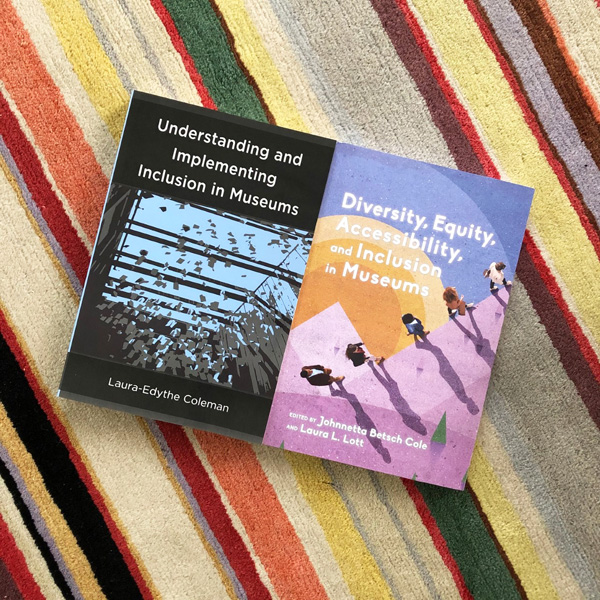
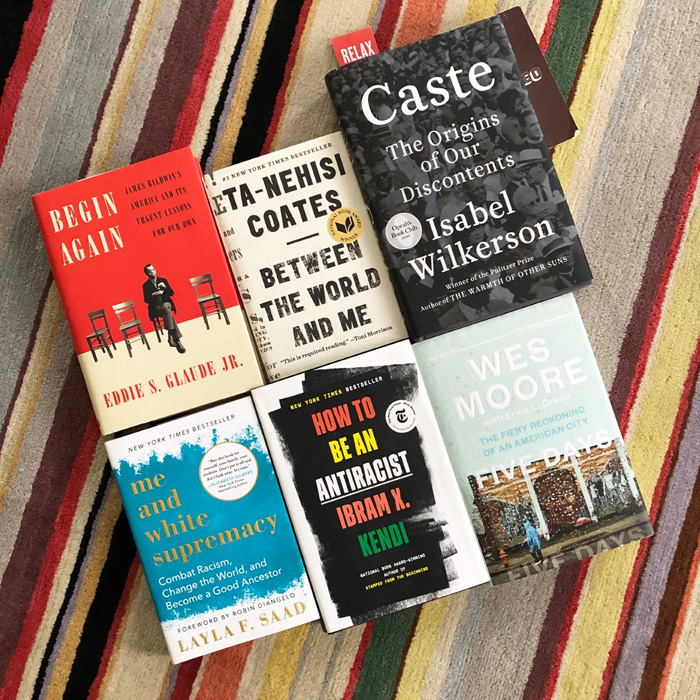
As I noted previously, there are unique challenges for a cosmetics museum to become a diverse and inclusive space. But that doesn't mean there's not room for improvement. If the Museum occupied a physical space and had paid employees (well-paid and with full benefits, of course, and while I hope they would not have a need for a union, they would absolutely be encouraged to form one if they want), it would no doubt have a diverse board and staff at all levels that would be treated as integral to the organization and not tokens, along with the other essentials such as diversity training for docents and consultants to continually evaluate the Museum's efforts and provide recommendations. In its current form, however, the primary focus in terms of diversity and inclusion is on the Museum's content and collection. Since there are no blueprints as to how to run an online cosmetics museum/blog whose existence and finances depend entirely on one person who is also not technically a museum professional, it's tricky to come up with a concrete plan of action for diversity and inclusion. But here's a start.
Diversify the collection.
Collecting Chinese, Japanese and Korean brands are not an issue, nor are ones founded or owned by LGBTQ+ people – there are plenty of those as well as artist/fashion collaborations – but Latinx and Indigenous brands and collabs remain somewhat elusive. I can write about my beloved Pai Pai but they no longer ship to the U.S., and I know of only a handful of other Latinx or Indigenous-owned brands. Contemporary Black-owned brands are easier to find than ever now so I will continue purchasing more from them, but it's still difficult to find many vintage pieces simply because there were so few compared to the big mainstream brands, none of which catered to BIPOC's needs until the 1960s or so (and even then their efforts continued to miss the mark.) I will continue to keep my eyes peeled and buy from BIPOC and LGBTQ+ brands as much as possible.
Diversify blog, IG and exhibition content.
- The Museum's collection may not be diverse enough right now, but that doesn't mean I can't write about objects or other pieces of makeup history related to BIPOC and LGBTQ+ communities, along with topics centered on ageism within the industry and people with disabilities. There are so many that are either have not been fully explored or not mentioned at all. One stumbling block remains: namely, I'm still not sure they're stories appropriate for a white, able-bodied, cis-het woman to tell. This is particularly important when discussing makeup used by Indigenous people, as in some cases it has a spiritual or religious purpose rather than beautification or self-expression. I'm afraid I don't have a solution other than to forge ahead and write about topics that may not be 100% appropriate but that are important. I think as long as I'm treating them in a sensitive manner and open to feedback and constructive criticism, it's better to share these histories even if they're from a non-BIPOC/LGBTQ+ person. One thing I eventually learned last summer was that being totally silent and not even attempting to diversify content is worse than trying and getting it wrong. I only hope I don't inflict any harm, but if I do, then I can always remove the post and do better the next time.
- Search for more BIPOC and LGBTQ+ artists and brands to feature on Instagram and in Color Connections.
- Exhibitions: How are BIPOC and LGBTQ+ represented in exhibitions? If they're not adequately represented, why? The solutions to this would normally be to have an exhibition that thoroughly incorporates diverse objects and voices, or have one focused on BIPOC and LGBTQ+ themes and ensure appropriate curation and oversight, e.g. not hiring someone who doesn't belong to those groups or has little to no knowledge about the topic at hand. This is a hurdle for the Makeup Museum as the founder and sole curator is not from an underrepresented group. The only thing I can do at the moment is choose exhibition topics in which marginalized people have adequate representation and make sure they see themselves in the exhibitions. It must be obvious that they're not niche visitors and that they are essential to the story the exhibition is telling. Theoretically I could explore whether anyone would be interested in co-curating or guest curating an exhibition focused on BIPOC or LGBTQ+, but as the Museum is entirely a labor of love and I'm unable to provide compensation, I'm sure as hell not asking someone from a marginalized group to curate or write for free. That brings me to my next point.
Identify fees for guest writers, curators and consultants and see if they are feasible without drastically cutting the budget for new acquisitions.
Like most of the initiatives I would love to pursue such as overhauling the website ($10-20k), purchasing archival storage containers ($1-2k), establishing a nonprofit (about $2-4k), getting a degree in museum or curatorial studies ($50k minimum) and purchasing and maintaining proper collections management software ($2k per year), I fear I would never be able to afford to hire professionals to work on the Museum with me even if I never bought another object, but it can't hurt to at least ask what their fees are. And who knows, perhaps I could even work out a plan whereby payments are due in installments rather than the full sum up front.
Further develop a community-focused, collaborative mindset.
Since its inception the Museum has operated in a mostly isolated environment. I'm not only a hardcore introvert and lifelong loner, but I always wanted to have my own space, something that I had full control over and without the involvement of anyone else. And that impulse is still quite strong. But I've also always wanted to educate, and though I'm not comfortable with it, being a resource means inviting people to help create it: by the public, for the public. Community for the Museum largely means either makeup aficionados/professionals or the local geographic area. I've always asked blog visitors to respond to my posts, and starting with the Stila girls exhibition in 2019, I began asking visitors to submit memories, photos or anything else they'd like to share to be incorporated into the exhibition. Lately I started investigating how the Museum might be able to collaborate with local museums, schools and historical centers – obviously I've considered pitching a pop-up exhibition at their spaces for over a decade now, but I realized I have to be more mindful of the approach. There's no way an organization is going to agree to host or be involved with an outside museum offering a pop-up exhibition if it has nothing to do with their mission or at least their collections. The goal, it seems, is to match interests. For example, the Maryland Center for History and Culture would be more interested in an exhibition on a history of Baltimore beauty parlors than, say, a display of rose-themed makeup, because their mission and collection have nothing to do with botany or natural history but is focused on the state of MD. I think there are ways in which the Museum can engage with both the makeup and local communities, and become more diverse and inclusive in doing so.
Establish metrics for the Museum's collection and content and share them publicly.
To keep any organization accountable in their diversity and inclusion efforts, it's necessary to track measurable outcomes of said efforts. Museums and Race's report card gave me the idea to develop one for the Museum based on the steps listed above. It would be updated annually each January and indicate the progress or maintenance of goals, which are as follows:
- Increase the number of posts that focus on or incorporate BIPOC and LGBTQ+ makeup and related topics (for example, the "multicultural" makeup of the '90s). Originally I wanted to follow U.S. demographics and keep a strict 60/40 split in which 40% of posts would be BIPOC-focused, with 18% Latinx topics/artists/brands, 15% Black, 6% Asian and 1% Indigenous. Alas, after crunching some numbers I realized that it would be impossible unless I both greatly scaled back the number of Asian-focused posts and hired or collaborated with BIPOC/LGBTQ+, and there's no telling if I will be able to achieve the latter. So for now, I'm going to take stock of what was written in 2020 and plan on more diverse posts in 2021. In terms of Instagram, taking a cue from the 15% pledge, my goal is to ensure at least 15% of IG posts feature Black makeup history, artists, models or Black-owned brands. I've been doing 11% since June (or 1 out of every 9 posts) and it has proved challenging. It's difficult because I don't want to repeat the same brands, models or artists ad nauseam and also want to provide meaningful and unique content, i.e. I don't want to toss up some ad that people have seen a thousand times before, especially without offering any new insight, just because I need to fill a quota that I set. Representation is critical, but can easily veer into tokenism. Having said that, I'd still like for 1 post out of every 6 (or 17%) to have Black-focused content and I'm working on how I can do that without blindly regurgitating things that are readily available and well-known. I'm also going to count other topics towards this goal even if they don't show a Black model or brand. For example, I have a bottle of Revlon's Touch and Glow foundation from the early 1950s in the deepest shade they made up until about 1957. As you may have guessed, it's medium toned at best. This is an example of how mainstream brands simply did not care about the needs of BIPOC customers, especially Black ones. I'm still not sure how to handle other demographics, however; as noted above, Latinx and Indigenous brands, artists and topics are somehow more difficult to find than Black ones. Nevertheless, Instagram makes it easy to track so I will take stock of 2020's posts and work on at least increasing the number of posts involving these groups.
- Increase the number of Museum objects from BIPOC-owned brands. I will keep track of what was acquired each year and work out the proportion of objects that came from BIPOC-owned brands. Then monitor those numbers each year to ensure they increase. For example, I purchased 22 makeup ads in 2020 and 6 of them were from Black-owned brands or featured Black models. So this year, let's say I purchase 22 ads again, 7 or more of them should be from BIPOC-owned brands or feature BIPOC models. The acquisition of objects from white-owned brands will still soundly outpace BIPOC-owned ones, especially for vintage pieces, but the goal is to increase that number and work towards a bigger percentage of BIPOC-owned objects in the collection.
- Track the number of BIPOC and LGBTQ+ people or organizations I reached out or donated to, along with community organizations. While nothing may come of these attempts on my part to collaborate with them, I feel it's important to at least get in touch. And there are plenty of BIPOC and LGBTQ individuals and organizations that can use donations.
- Ensure all exhibitions meaningfully represent BIPOC and LGBTQ+ individuals and brands, and if not, discuss why.
I think this sort of report card is more valuable than some bland diversity statement. Most of the statements I found lacked substance – they were just a bunch of jargon with no actionable steps outlined.
The Museum's diversity efforts are ongoing, of course. And I plan on tackling the related topics of social change and accessibility as future installments of MM Musings. But this is a beginning of a shift towards meaningful action. Thoughts? I'm off to create a report card for 2020 so I will have something to compare 2021 to.
It's the time of year where I babble on about things I want to tackle but most likely won't be able to. I reviewed last year's blog post ideas and out of the 30 topics I only managed to accomplish, let's see, 10. One-third of what I was aiming for. Sigh. As for exhibitions, I only did one and it wasn't all that cerebral. Anyway, no point in ruminating over what I should have done so here's a bit of an update.
In an effort to sort of narrow down the massive amount of exhibition ideas I have, I came up with a priority list of topics that might be doable in the 1-5 years (if the Museum is still in existence) and a secondary list for, well, I have no idea – eventually. I tweaked some of the descriptions as needed. Also, please keep in mind these are working titles. Hopefully I can think of better ones! Once again the husband came up with handy graphics.
Priority:
- "Black and Blue: A History of Punk Makeup"
- "Catch the Light: Glitter in Cosmetics from Ancient Times Through Today" – Aiming to have this up for holiday 2021, but it's a big one and I will need lots of help that I'm not sure I can get.
- "The Life Aquatic: Mermaid Makeup" – I need to think of a better title soon because I want this to go up in June this year.
- "Color History Through Cosmetics: Blue" – I decided to scrap the gold-themed exhibition in exchange for blue. I discovered so many fascinating things about blue makeup while pulling together some trivia on Instagram, there's definitely enough there for an exhibition.
- "Ancient Allure: Egypt-Inspired Makeup and Beauty" - I did some polling on Twitter and Instagram and this one won as the next exhibition, so the tentative date is March 2021.
- "Just Desserts: Sweet Tooth Revisited" – It might be good to revisit this on its 10-year anniversary in 2023.
- "Aliengelic: Pat McGrath Retrospective" – Still a priority, but again, I will need lots of assistance and would strongly prefer having a makeup artist co-curate with me. Alternate title instead of Aliengelic: "The Mother of Modern Makeup".
- "From Male Polish to Guyliner: A History of Men's Makeup" – I know that a new book on men's makeup will be released in June this year and it would be great to have the author as a co-curator.
- "She's All That: Beauty in the '90s" – Oh, poor little neglected '90s makeup book and exhibition. You know I've been wanting to do a comprehensive exhibition and book since at least 2014, but just never seem to have the time. I do have the chapter outline but I think I need to make deadlines for each chapter and publish the drafts as blog posts, otherwise it's not getting done.
- "Pandemic: Makeup in the Age of COVID-19" – Depressing but historically significant. I'll need to wait until the pandemic is safely behind us, but I am gathering bits of what will surely become history now.
- "Ugly Makeup: A Revolution in Aesthetics" – I am so incredibly inspired by Makeup Brutalism and her other effort Ugly Makeup Revolution, I absolutely need to explore looks that completely shatter our notions of makeup's purpose. The exhibition would be a deep dive into how makeup is going beyond basic artistry and self-expression.
- "Nothing to Hide: Makeup as Mask" – This was the other choice I included in the Twitter and Instagram polls. While respondents chose Egyptian-themed makeup over this one, the mask theme in makeup goes back centuries and would certainly make a rich topic, plus I could do a subsection on mask-wearing's effects on makeup in the pandemic.
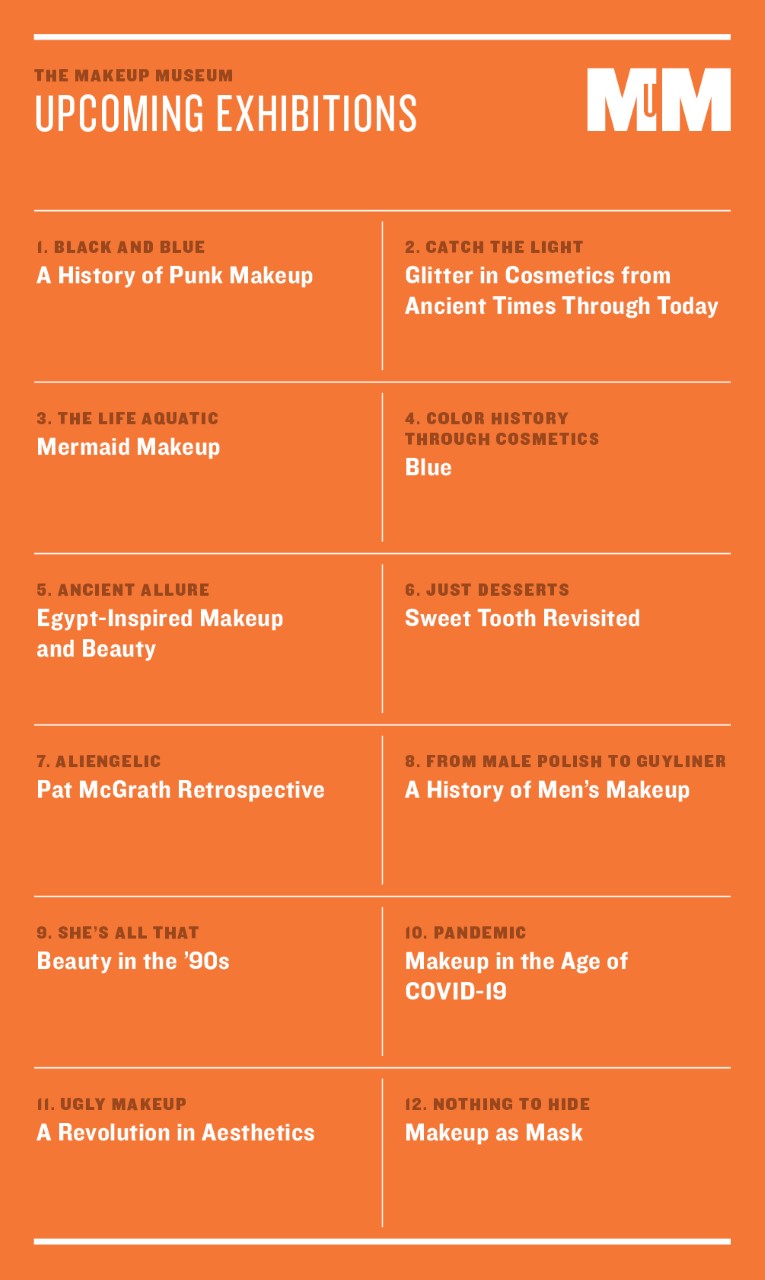
Secondary list/things I'm not sure about:
-
- "Queens: A History of Drag Makeup" – Amazing topic but overwhelming. Need much help!
- "From Mods and Hippies to Supervixens and Grrrls: '60s and '90s Makeup in Dialogue" – In my opinion, cultural developments in both the late '60s and mid-1990s radically changed the beauty industry and gave birth to new ideas about how people view and wear makeup; there are many parallels between the two eras. I feel, however, that I'd need to do the '90s exhibition and book first so this would have to wait.
- "Gilded Splendor: A History of Gold Makeup" – This is nice but the more I thought about it the more I didn't think it would be a priority.
- "Design is a Good Idea: Innovations in Cosmetics Design and Packaging" - Another that I still like but not so much as to make it immediate.
- "The Medium is the Message: Makeup as Art" – This will trace how makeup is marketed and conceived of as traditional art mediums, i.e painting and sculpture, and also how art history is incorporated into makeup advertising and collections. Consider it a comprehensive discussion of this post while working in canonical artists whose work has appeared on makeup packaging. My issue with it is that it's overwhelmingly white. The artists used in vintage ads such Lancome's are white and even collections today don't collaborate with many BIPOC artists, especially Black ones.
- "Wanderlust: Travel-Inspired Beauty" - A rich topic and would be timely in light of the pandemic limiting travel for most, but honestly, I'm not that excited about it.
- "By Any Other Name: The Rose in Makeup and Beauty" – I pitched this idea to the FIT Museum as a small add-on to their "Ravishing" exhibition. They weren't interested and now that the exhibition has passed I'm tabling it for now.
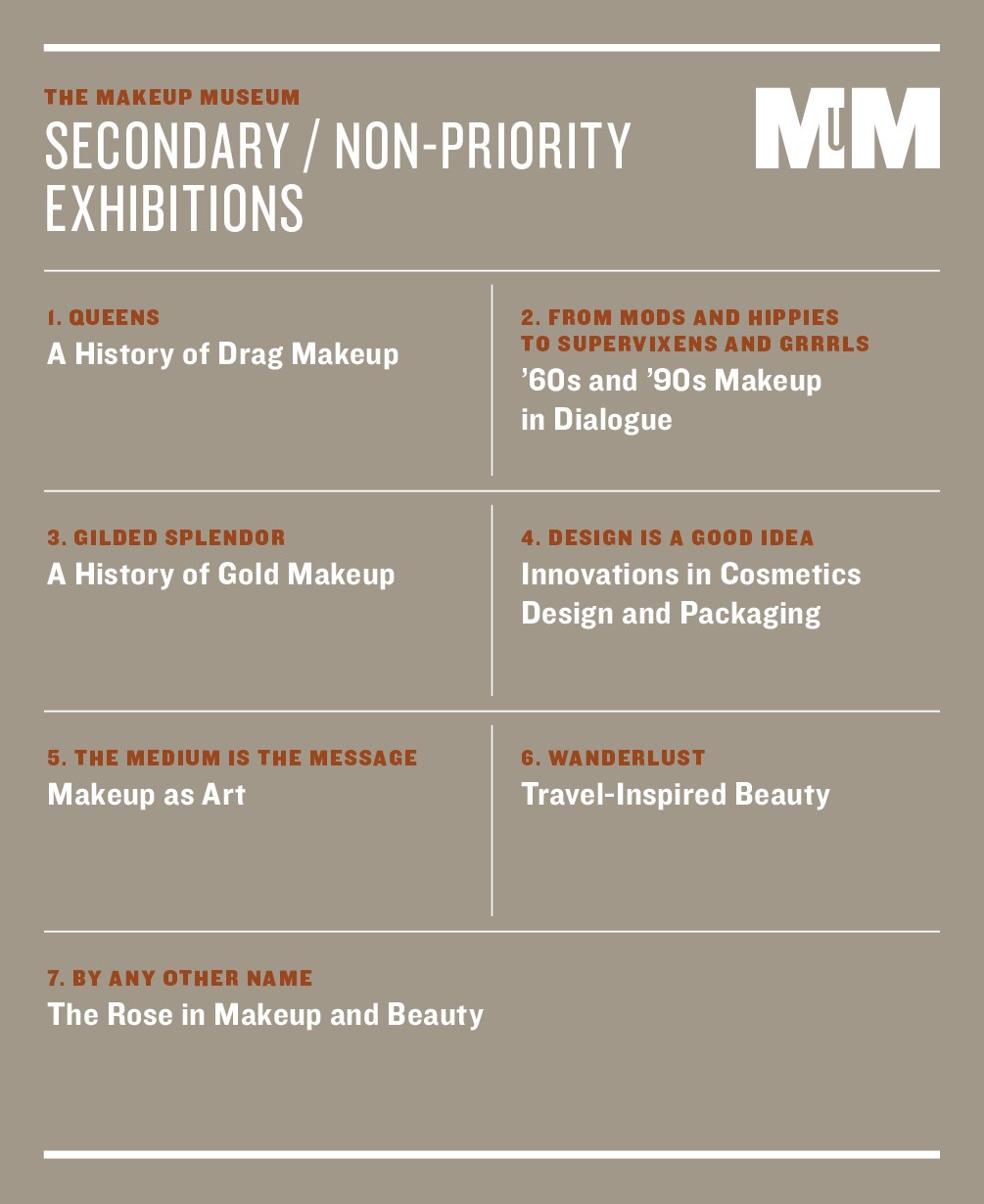
And now for blog posts!
MM Musings (2): FINALLY getting up the diversity and inclusion in museums post up this month after a year of working on it, and the other topic to tackle this year will be becoming a nonprofit organization.
Makeup as Muse (3): I managed to get around to covering Gina Beavers last year, but that was it. The artists on my list are Sylvie Fleury, Rachel Lachowitz, Asa Jungnelius and Tomomi Nishizawa.
MM Mailbag (2-3): Once again the MM mailbag overflowed in 2020 and most of the inquiries took a significant amount of time to research and answer. I'll see what might be feasible.
Brief histories (4-5): I still want to go ahead with histories of powder applicators, setting sprays and maybe colored mascara, color-changing cosmetics and how makeup language has evolved (for example, why we typically say "blush" now instead of "rouge" for cheek color.) The author of Cosmetics and Skin kindly suggested an article on copycats, i.e. how companies clearly ripped each other off and continue to do so today in terms of packaging, ad campaigns, etc. which is a great topic. I'm also interested in a history of Day of the Dead makeup.
Trends (1): Makeup brand merchandise and swag – another I didn't cover in 2020 as planned. I'm also very interested in the video game trend in makeup, but I'm hoping this amazing person writes about it instead!
Topics to revisit (1-2): faux freckles, non-traditional lipstick shades, and cultural appropriation in cosmetics advertising. I did not update any of these in 2020 so I hope to do at least one of the three this year. Also, perhaps a deeper dive into surrealism and makeup.
Vintage (6): series of Dorothy Gray ads featuring portraits of well-to-do "society" ladies, '90s prom makeup, and wear-to-work makeup from the 1970s-90s, defunct '90s and early aughts brands (Benetton, Calvin Klein, Tommy Hilfiger, Nina Ricci and Inoui ID to start with), and a slew of other brand histories, especially Black-owned brands like La Jac and Rose Morgan. I'm also itching to write something about Black salespeople and customers in direct sales companies, i.e. Avon, Mary King by Watkins, Fuller, Artistry by Amway, etc. The company I hope to tackle this month if the objects I purchased on Ebay ever arrive will be Holiday Magic…the story is absolutely bonkers.
Artist collabs (5): As in 2020 I'm still trying to catch up on some of last year's holiday releases, including Fee Greening for Mikimoto and Cecilia Carlstedt and Morag Myerscough for Bobbi Brown. There are tons of others from previous years that I'm still thinking about, such as El Seed for MAC, Connor Tingley for NARS, the Shiseido Gallery compacts and lip balms, and a series on the artists whose work appears on Pat McGrath's packaging.
Book reviews (2): In the interest of saving time and also because my reviews tend to be badly written (even for me), I decided to do regular reviews only for some books and speed reviews of others, combining several books in a single post. Most of the ones I'm planning on are in the Beauty Library section of the website.
Dream Teams series (1-2): I did actually start this series last year, albeit without the mockups I had wanted to do. Stay tuned for more fantasy artist/makeup collabs. I especially want to focus on BIPOC artists and flesh out the idea I had back in 2016 for a Rrose Sélavy-themed collection.
Color Connections (5+): I returned to Color Connections last year but only once. They just take so much time. However, I've been toying with the idea of putting them as a dedicated series on Instagram separate from the Museum's regular account. That way it might make me accountable in terms of working on them more regularly.
Finally, there will be lots of other random things popping up, and I have so many people I want to talk to so I hope to nab some interviews and guest posts. 🙂
And here we have my book ideas. They're the same as last year. The first one is an alternate title for the '90s exhibition. The second one would basically be the accompanying catalogue for the Makeup as Art exhibition. I still want to do a coffee table book of pretty makeup, but my concern is that it won't be diverse.
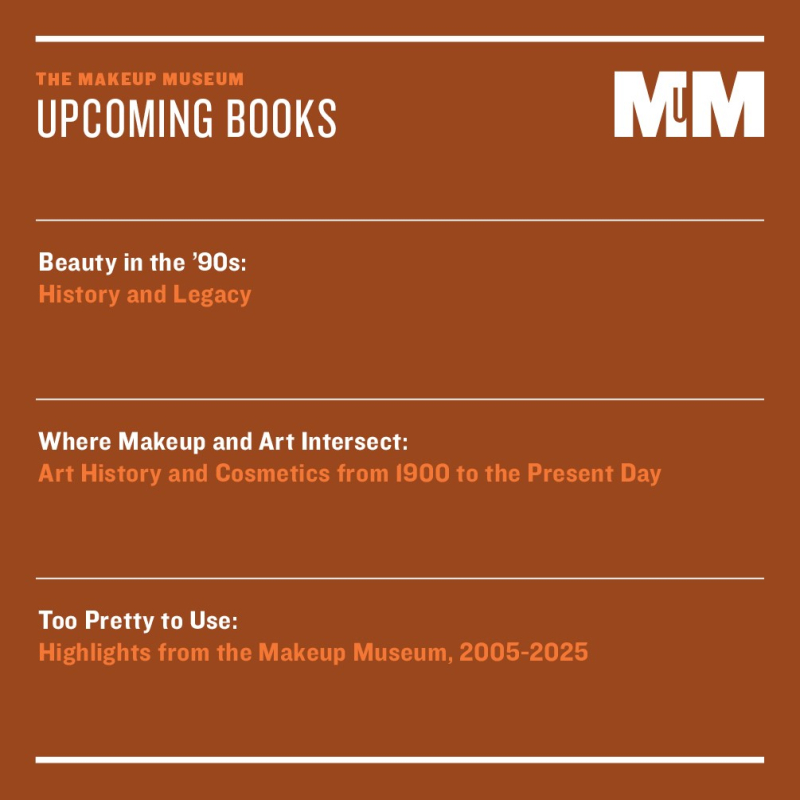
Any of these topics interest you? Which ones would you like to read about/see first?
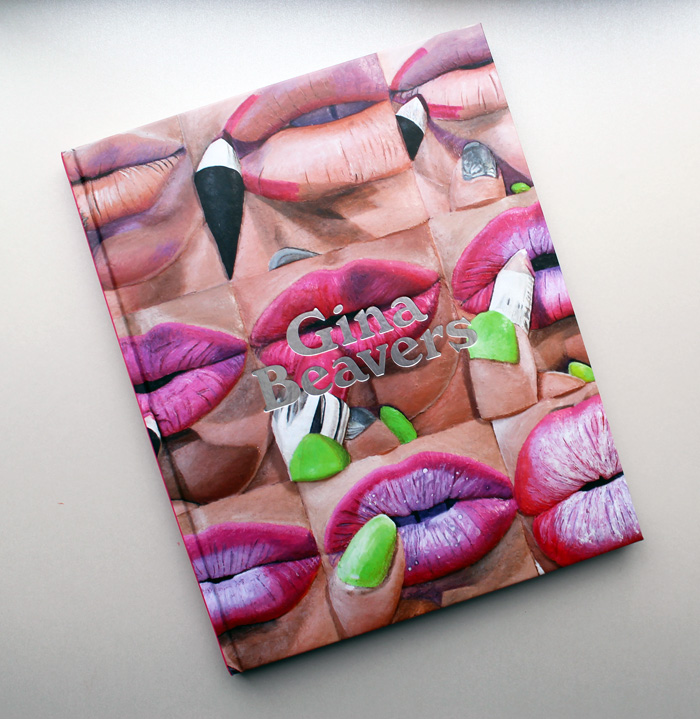
Despite my art history background and general love of art, I am less than eloquent when writing about it. Nevertheless I will continue soldiering forward with the Museum's Makeup as Muse series, the latest installment of which focuses on the work of Gina Beavers in honor of her recent show at Marianne Boesky Gallery. Beavers' practice encompasses a variety of themes, but it's her paintings of makeup tutorials that I'll be exploring. Since I'm both tired and lazy this will be more of a summary of her work rather than offering any fresh insight and I'll be quoting the artist extensively along with some writers who have covered her art, so most of this will not be my own words.
Born in Athens and raised in Europe, Beavers is fascinated by the excess and consumerism of both American culture and social media. "I don't know how to talk about this existence without talking about consumption, and so I think that's the element in consuming other people's images. That's where that's embedded. We have to start with consumption if we're going to talk about who we are. That's the bedrock—especially as an American," she says. The purchase of a smart phone in 2010 is when Beavers' work began focusing on social media. "[Pre-smart phone] I would see things in the world and paint them! Post-smartphone my attention and observation seemed to go into my phone, into looking at and participating in social media apps, and all of the things that would arise there…Historically, painters have drawn inspiration from their world, for me it's just that a lot of my world is virtual [now]."
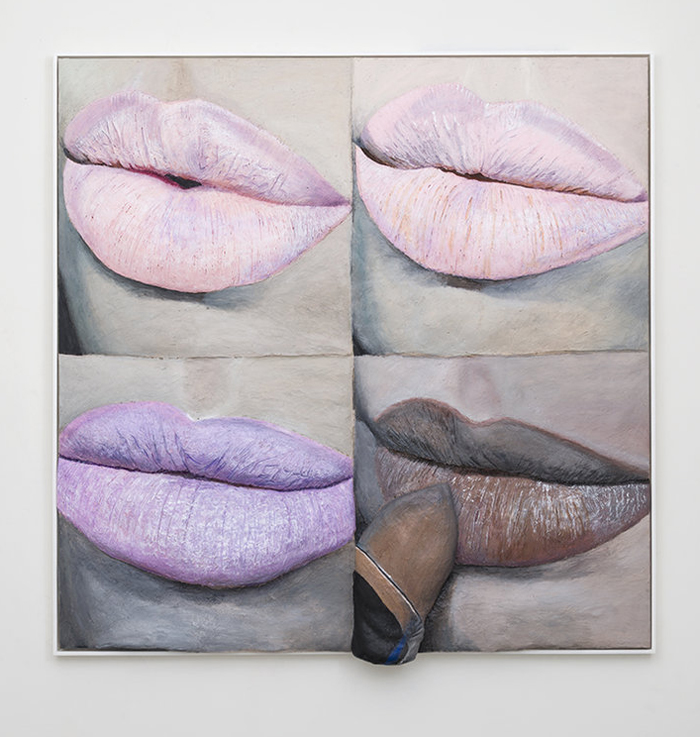
But why makeup, and specifically, makeup tutorials? There seem to be two main themes running through the artist's focus on these online instructions, the first being the relationship between painting and makeup. Beavers explains: "When I started with these paintings I was really thinking that this painting is looking at you while it is painting itself. It’s drawing and painting: it has pencils, it has brushes, and it’s trying to make itself appealing to the viewer. It’s about that parallel between a painting and what you expect from it as well as desire and attraction. It’s also interesting because the terms that makeup artists use on social media are painting terms. The way they talk about brushes or pigments sounds like painters talking shop." Makeup application as traditional painting is a theme that goes back centuries, but Beavers's work represents a fresh take on it. As Ellen Blumenstein wrote in an essay for Wall Street International: "Elements such as brushes, lipsticks or fingers, which are intended to reassure the viewers of the videos of the imitability of the make-up procedures, here allude to the active role of the painting – which does not just stare or make eyes at the viewer, but rather seems to paint itself with the accessories depicted – literally building a bridge extending out from the image…Beavers divests [the image] of its natural quality and uses painting as an analytical tool. The viewer is no longer looking at photographic tableaus composed of freeze-frames taken from make-up tutorials, but rather paintings about make-up tutorials, which present the aesthetic and formal parameters of this particular class of images, which exist exclusively on the net." The conflation of makeup and painting can also be perceived as a rumination on authorship and original sources. Beavers is remaking tutorials, but the tutorials themselves originated with individual bloggers and YouTubers. And given the viral, democratic nature of the Internet, it's nearly impossible to tell who did a particular tutorial first and whether tutorials covering the same material – say, lip art depicting Van Gogh's "Starry Night" – are direct copies of one artist's work or merely the phenomenon of many people having the same idea and sharing it online. Sometimes the online audience cannot distinguish between authentic content and advertising; Beavers's "Burger Eye" (2015), for example, is actually not recreated from a tutorial at all but an Instagram ad for Burger King (and the makeup artist who was hired to create it remains, as far as I know, uncredited).
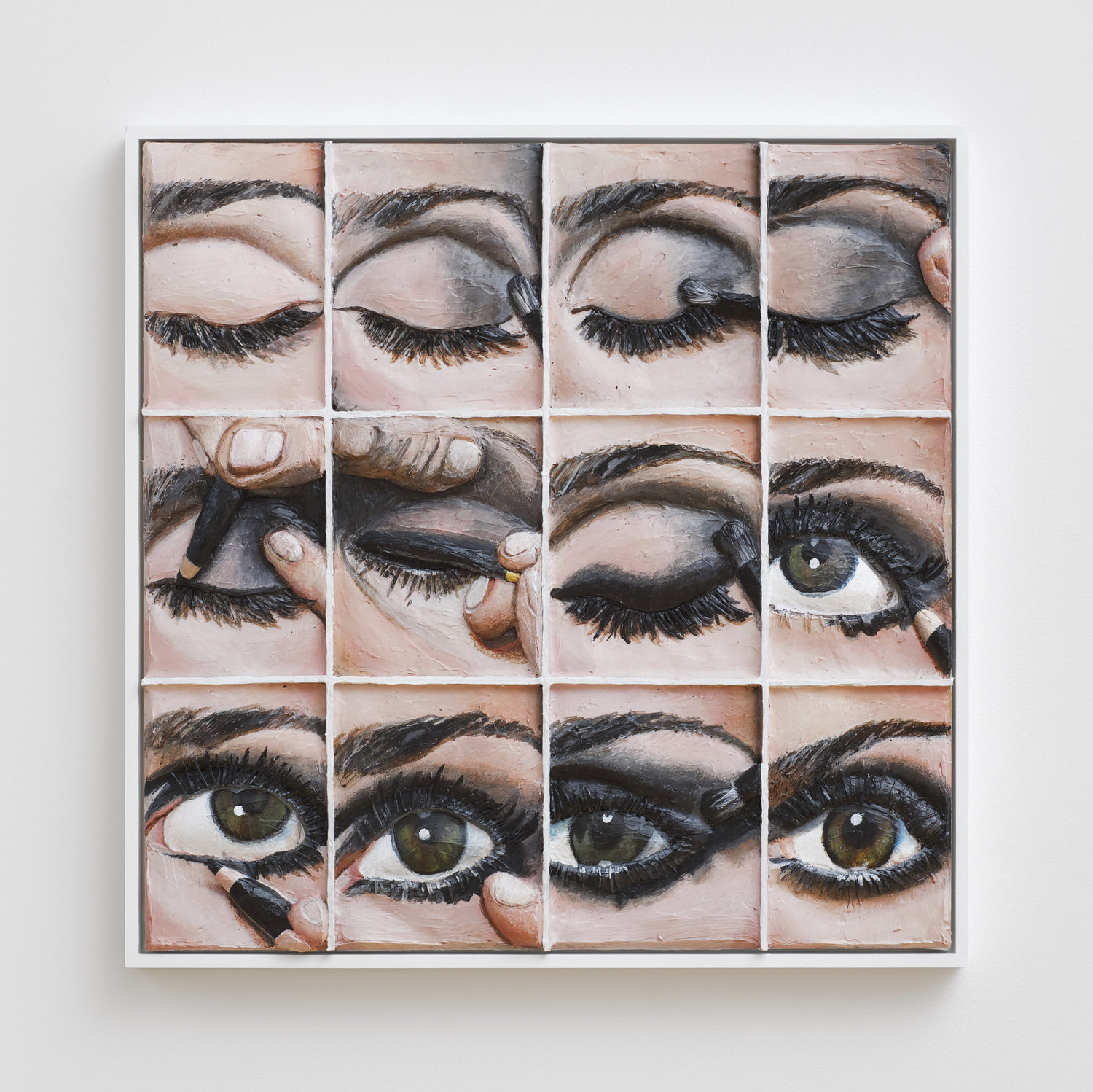
Another theme is fashioning one's self through makeup, and how that self is projected online in multiple ways. Beavers explains: "I am interested in the ways existing online is performative, and the tremendous lengths people go to in constructing their online selves. Meme-makers, face-painters, people who make their hair into sculptures, are really a frontier of a new creative world…It’s interesting, as make-up has gotten bigger and bigger, I’ve realized what an important role it plays in helping people construct a self, particularly in trans and drag communities. I don’t normally wear a lot of make-up myself, but I like the idea of the process of applying make-up standing in for the process of self-determination, the idea of ‘making yourself’."
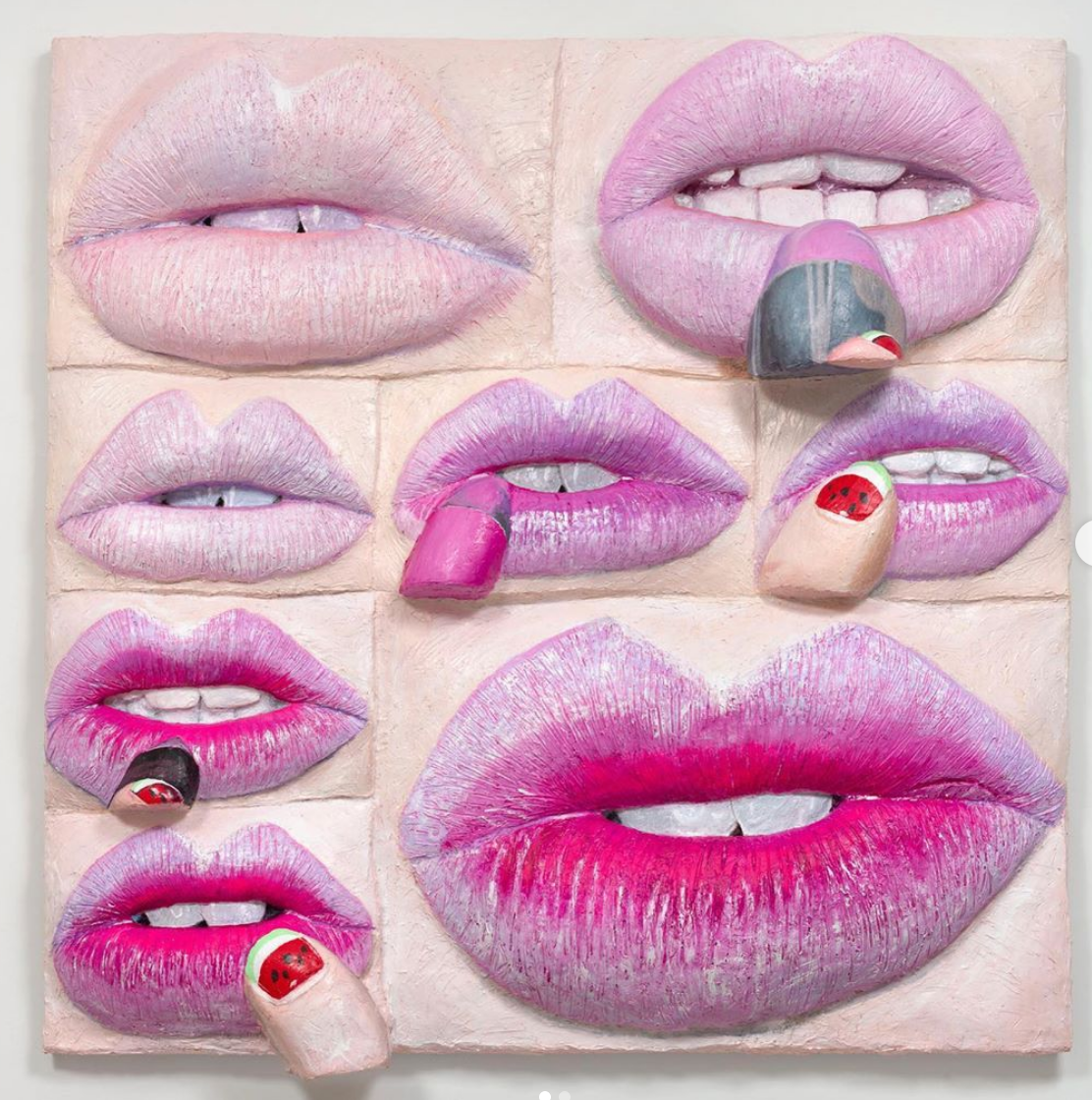
As for the artist's process, it's a laborious one. Beavers regularly combs Instagram, YouTube and other online sources and saves thousands of images on her phone. She then narrows down to a few based on both composition and the story they're trying to tell. "I'm arrested by images that have interesting formal qualities, color, composition but also a compelling narrative. I really like when an image is saying something that leaves me unsure of how it will translate to painting, like whether the meaning will change in the context of the history of painting," she says. "I always felt drawn to photos that had an interesting composition, whether for its color or depth or organization. But in order for me to want to paint it, it also had to have interesting content, like the image was communicating some reality beyond its composition that I related to in my life or that I thought spoke in some interesting way about culture." The act of painting for Beavers is physically demanding as well: she needs to start several series at the same time and go back and forth between paintings to allow the layers to dry. They have to lay flat to dry so she often ends up painting on the floor, and her recent switch to an even heavier acrylic caused a bout of carpal tunnel syndrome.
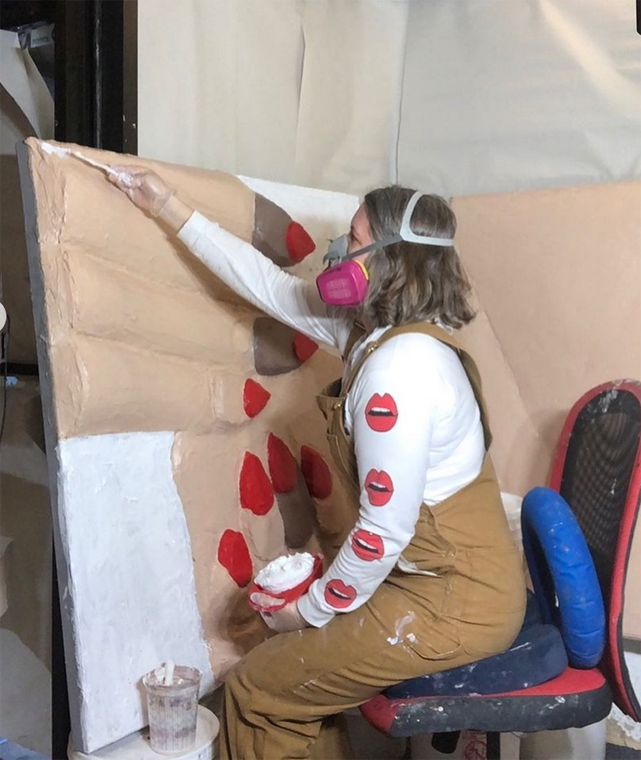
But it's precisely the thick quality of the paint that return some of the tactile nature of makeup application. This is not accidental; Beavers intentionally uses this technique as way to remind us of makeup's various textures and to ensure her paintings resemble paintings rather than a photorealistic recreation of the digital screen. "The depth of certain elements in the background of images has taught me a lot about seeing. I think I have learned that I enjoy setting up problems to solve, that it isn't enough for me to simply render a photo realistically, that I have to build up the acrylic deeply in order to interfere with the rendering of something too realistically," she explains. Sharon Mizota, writing for the LA Times, says it best: "Skin, lashes and lips are textured with rough, caked-on brushstrokes that mimic and exaggerate wrinkles and gloppy mascara. This treatment gives the subjects back some of the clunky physicality that the camera and the digital screen strip away. Beavers’ paintings, in some measure, undo the gloss of the photographic image."
Beavers also uses foam to further build up certain sections so that they bulge out towards the viewer, representing the desire to connect to others online. "Much of what people do online is to try to create connection, to reach out and meet people or talk to people. That is what the surfaces of my painting do in a really literal way, they are reaching off the linen into the viewer’s space," she says. This sculptural quality also points to the reality of the online world – it's not quite "real life" but it's not imaginary either, occupying a space in between. Beavers expands on her painting style representing the online space: "It’s interesting because flatness often comes up with screens, and I think historically the screen might have been read like that, reflecting a more passive relationship. That has changed with the advent of engagement and social media. What’s behind our screen is a whole living, breathing world, one that gives as much as it takes. I mean it is certainly as 'real' as anything else. I see the dimension as a way to reflect that world and the ways that world is reaching out to make a connection. Another aspect is that once these works are finished, they end up circulating back in the same online world and now have this heightened dimensionality – they cast their own shadow. They’re not a real person, or burger, or whatever, but they’re not a photo of it either, they’re something in between."
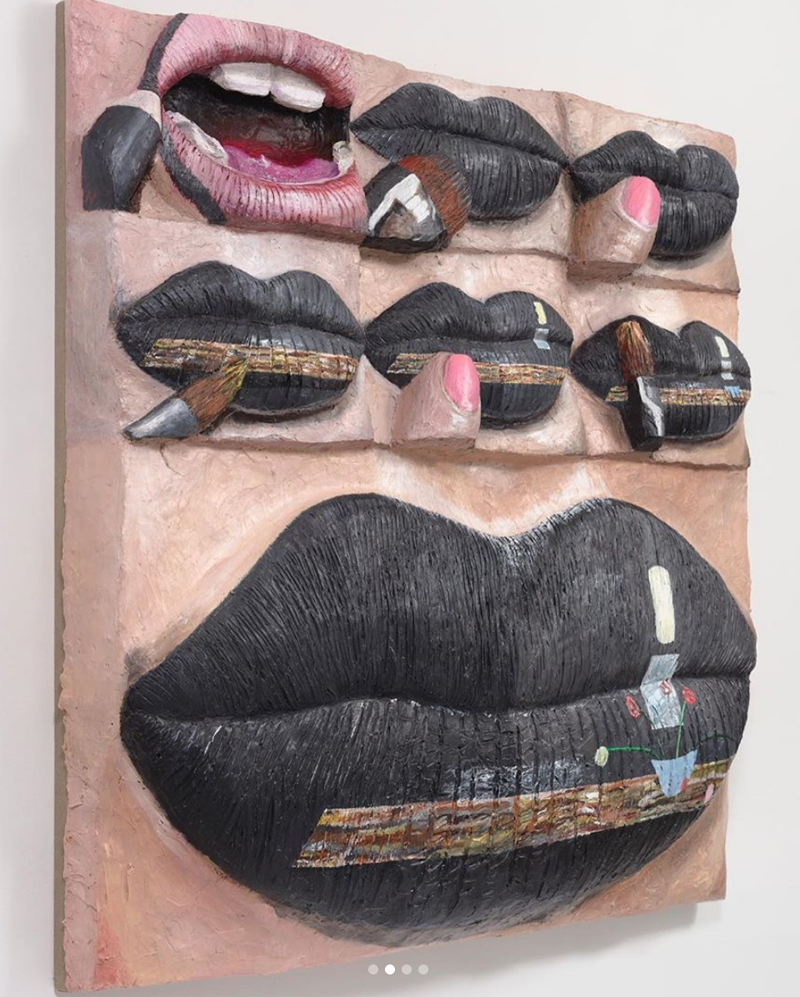
Let's dig a little more into what all this means in terms of makeup, the beauty industry and social media. Beavers' work can be viewed as a simultaneous critique and celebration of all three. Sharon Mizota again: "[The tutorial paintings] also pointedly mimic the act of putting on makeup, reminding us that it is something like sedimentation, built up layer by layer. There is no effortless glamour here, only sticky accretion. That quality itself feels like an indictment — of the beauty industry, of restrictive gender roles. But an element of playfulness and admiration lives in Beavers’ work. They speak of makeup as a site of creativity and self-transformation, and Instagram and other social media sites as democratizing forces in the spread of culture. To be sure, social media may be the spur for increasingly outré acts, which are often a form of bragging, but why shouldn’t a hamburger eye be as popular as a smoky eye? In translating these photographs into something more physical, Beavers asks us to consider these questions and exposes the duality of the makeup industry: The same business that strives to make us insecure also enables us to reinvent ourselves, not just in the image of the beautiful as it’s already defined, but in images of our own devising."
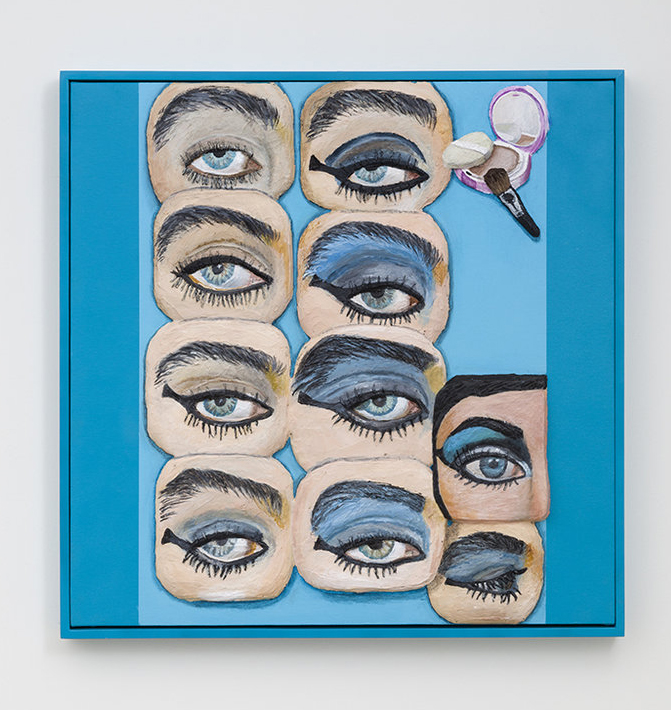
This ambiguity is particularly apparent in Beavers's 2015 exhibition, entitled Ambitchous, which incorporated beauty Instagrammers and YouTubers' makeup renditions of Disney villains alongside "good" characters. Blumenstein explains: "So it isn’t protagonists with positive connotations which are favoured by the artist, but unmistakably ambivalent characters who could undoubtedly lay claim to the neologism ambitchous, which is the name given to the exhibition. Like the original image material, this portmanteau of ‘ambitious’ and ‘bitchy’ is taken from social media and its creative vernacular, and is used, depending on the context, either in a derogatory fashion – for example for women who will do absolutely anything to get what they want – or positively re-interpreted as an expression of female self-affirmation. Beavers also applies this playful and strategic complication of seemingly unambiguous contexts of meaning to the statements contained in her paintings. It remains utterly impossible to determine whether they are critically exaggerating the conformist and consumerist beauty ideals of neo-capitalism, or ascribing emancipatory potential to the conscious and confident use of make-up."
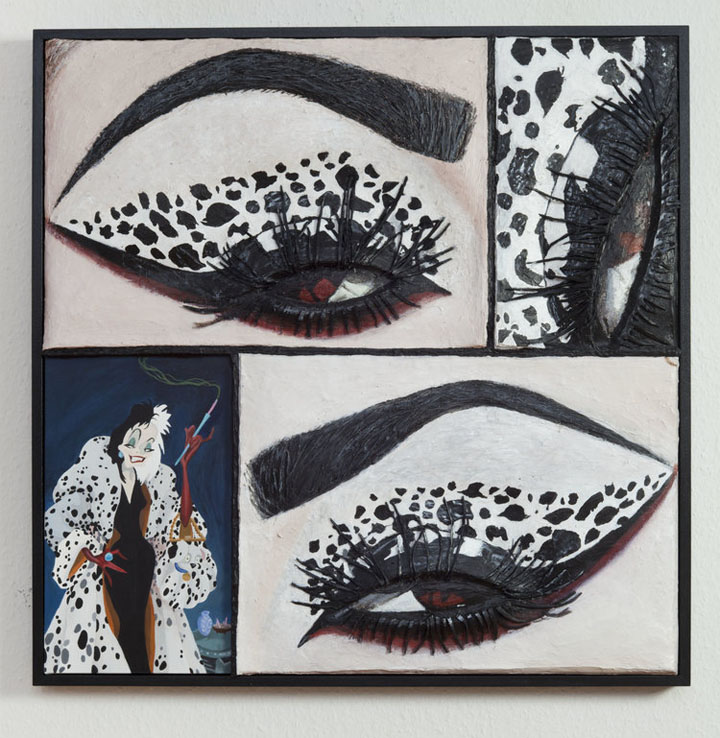
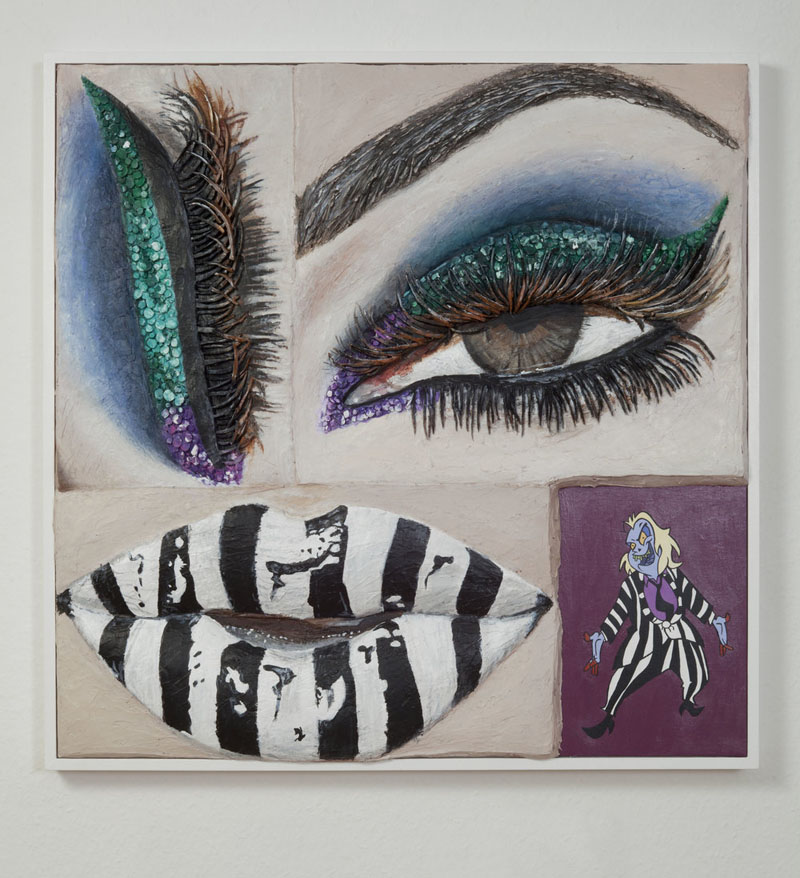
More recently, Beavers has been using her own face as a canvas and making her own photos of them her source material, furthering her exploration of the self. "Staring at yourself or your lips for hours is pretty jarring. But I like it, because it creates this whole other level of self,” she says.
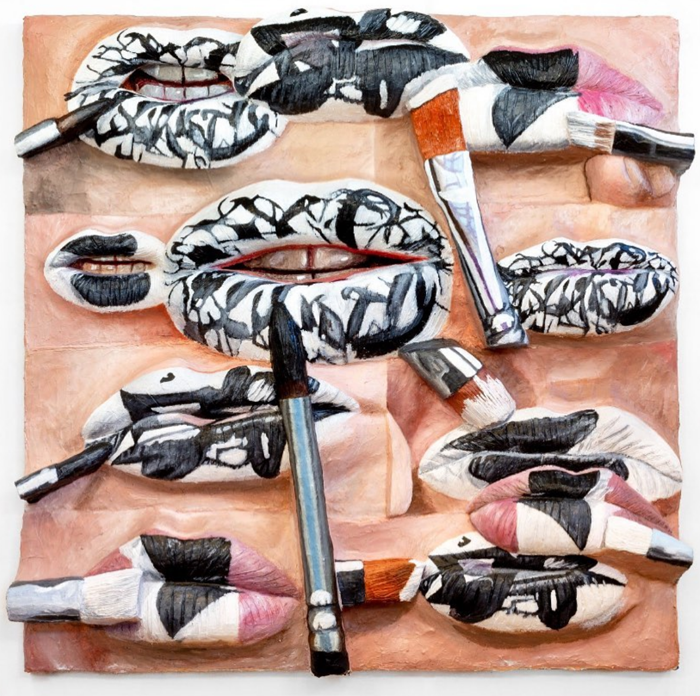
This shift also points to another dichotomy in Beavers's work: in recreating famous works of art on her face, she is both critiquing art history's traditional canon and appreciating it, referring to them as a sort of fan art. "I think a lot of the works that I have made that reference art history—like whether it's Van Gogh or whoever it is—have a duality where I really respect the artist and I'm influenced by them, and at the same time I'm making it my own and poking a little fun. And so, a lot of these pieces originated with the idea of fan art. You'll find all sorts of Starry Night images online that people have painted or sculpted or painted on their body. It comes out of that. And I just started to reach a point where I was searching things like 'Franz Kline body art,' and I wasn’t finding that, so I had to make my own. Then it started to get a little bit geekier. I have a piece in the show where I am painting a Lee Bontecou on my cheek, that's a kind of art world geeky thing—you have to really love art to get it."
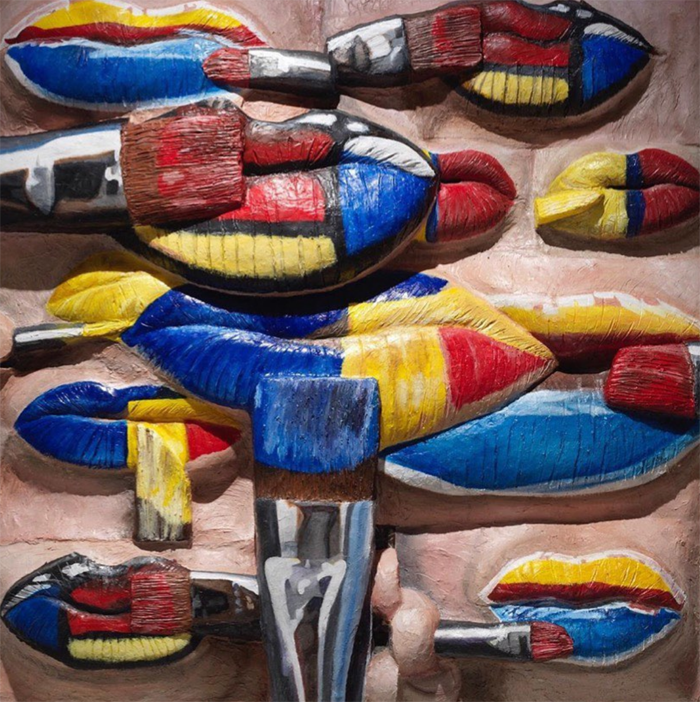
Ultimately, Beavers perceives the intersection of makeup and social media as a force for good. While the specter of misinformation is always lurking, YouTube tutorials and the like allow anyone with internet access to learn how to do a smoky eye or a flawlessly lined lip. "I think for a lot of people social media is kind of like the weather. We don't have a lot of control of it, it just is. It gives and it takes away. There's no doubt that it has connected people in ways that are great and productive, allowing people to find communities and organize activism, it can also be a huge distraction…I approach looking at images there pretty distantly, more as a neutral documentarian, and I come down on the side of seeing social media as an incredibly useful, democratic tool in a lot of ways," she concludes.
On the other side of social media, Beavers is interested on how content creators help disseminate the idea of makeup as representing something larger and more meaningful than traditional notions of beauty. "I was super fascinated with makeup and all of the kinds of costume makeup and things you can find online that go away from a traditional beauty makeup and go towards something really wild and cool…I also had certain paintings in [a 2016] show that were much more about costume makeup, that were going away from beauty. That’s the thing that gives me hope. When I go through makeup hashtags on Instagram, there will be ten or twenty beauty eye makeup images and then one that’s painted with horror makeup. There are women out there doing completely weird things, right next to alluring ones." In the pandemic age, as people's relationships with makeup are changing, "weird" makeup is actually becoming less strange. Beavers' emphasis on experimental makeup is more timely than ever. I also think she's documenting the gradual way makeup is breaking free of the gender binary. She says: "I mean with makeup, and the whole conversation around femininity and makeup—I think for a long time when I was making makeup images, there were people that just thought, 'Oh, that's not for me,' because it's about makeup, it's feminine. But it’s interesting, the culture is shifting. I just saw the other day that Alexandria Ocasio-Cortez did a whole Instagram live where she was putting on her makeup and talking about how empowering makeup is for trans communities…some people see make-up as restrictive or frivolous, but drag performers show how it can be liberating and life-saving." Another point to consider in terms of gender is the close-up aspect of Beavers's paintings. With individual features (eyes, lips, nails) separated from the rest of the face and body and removed from their original context, they're neither masculine nor feminine, thereby reiterating that makeup is for any (or no) gender.
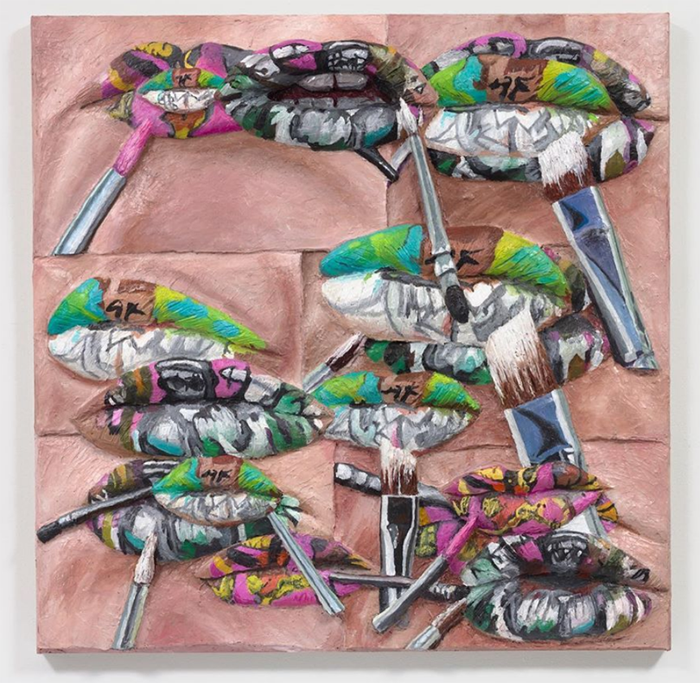
(images from Gina Beavers's website and Instagram)
All I can say is, I love these paintings. Stylistically, they're right up my alley – big, colorful and mimicking makeup's tactile nature so much that I have a similar reaction to them as I do when seeing makeup testers in a store: I just want to dip my hands in them and smear them everywhere! I also enjoy the multiple themes and levels in her work. Beavers isn't commenting just on makeup in the digital age, but also self-representation online, shifting attitudes towards makeup's meaning, the relationship between painting and makeup, and Western art history.
What do you think of Beavers's paintings? If you like it I would highly recommend the monograph, which is lovely and fairly affordable at $40.
I'm doing the #Museum30 challenge on Twitter, and one of the recent prompts was "origin". It got me thinking about the very first makeup museum. While I have no definitive answers, it seems the first cosmetics museum, at least in the U.S., dates back to the 1950s. And there were several others after that but before the Makeup Museum was established. So let's take a quick peek into the origin of the makeup museum and the other spaces that have gone before (along with a a couple that came after).
In October of 1956 it was reported that the House of Cosmetics, a "cosmetics museum and gallery of fame as a historical repository and a tribute to the cosmetics industry", would opening at the former Reed Company on Harrison Street in Newark, NY. It was financed and operated by Pitkin, a cosmetics manufacturer that distributed the Linda Lee line of cosmetics. Among other features, the museum would boast special sections for perfume, lipstick ("Lipstick Lane") and powder ("Powder Puff Parade) , along with gigantic sculptures of a perfume bottle, lipstick and powder box on the roof that would light up at night. The collection consisted of objects donated from the public along with memorabilia from the Pitkin company archives. A perfume fountain at the entrance spouted a brand-new fragrance called Three Coins, created especially for the museum. Visitors would receive samples of the perfume.
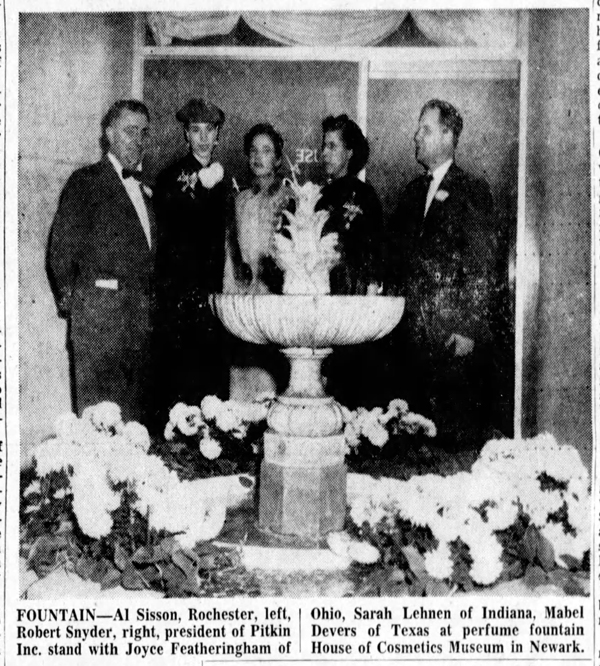
House of Cosmetics Museum, Newark NY, December 1956
The odd thing about the House of Cosmetics is that it allegedly opened in December of 1956, but there is literally no mention of it after that. I could not for the life of me find any information on it following its grand opening, so I can only assume it wasn't successful and quietly closed, perhaps because it was too commercial and focused mostly on Pitkin. The House of Cosmetics was not the vision of a passionate private collector, but that of the current president of Pitkin as a way to raise the company's profile nationwide and celebrate the brand's upcoming 50th anniversary in 1958. The space prominently featured current Pitkin products and it didn't seem as though there were outside curators or historians involved, plus, only Pitkin employees served as tour guides. I know many argue that museums should be run like businesses, and it's a conversation for another time, but I really do think that generally entrepreneurs should not be opening museums.
Fast forward to 1979* when the Pacific Cosmetics Museum, also known as the Museum of Cosmetics History, opened in Korea. While it was established by Pacific Chemicals founder Suh Seong Hwan as part of the company's factory in Seoul, the collection reflects the passion and respect Hwan had for Korean cosmetics history.
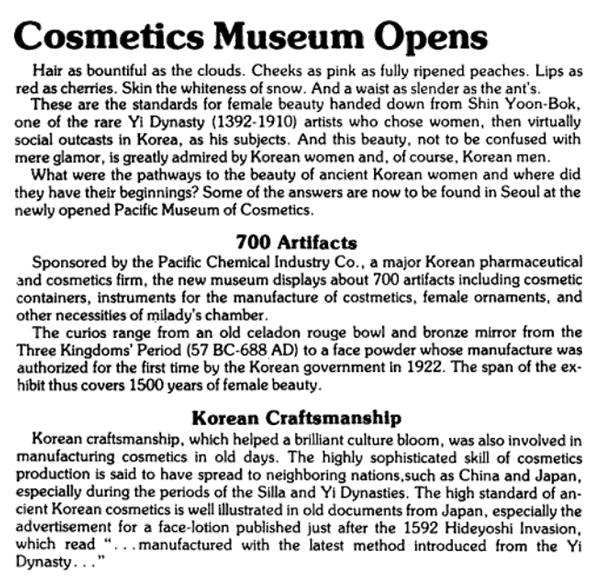
With the help of museum director/curator Chun Wan-gil (Cheon Wan-kil), Hwan continued researching and building the collection, all the while becoming more interested in the cultural aspects of makeup rather than seeing them merely as a way to make money. Not only did Hwan support the museum, he funded research and publications related to Korean cosmetics history. According to AmorePacific biographer Han Mi-Ja, "Chun Wan-gil seemed truly to enjoy working for the museum. He poured all his energy and passion into helping Jangwon [Hwan] with it. As for Jangwon, he was amazed and thrilled to watch how the historic relics seemed to come to life after the hands of Chun Wan-gil touched them. With his guide, Jangwon was able to build his knowledge and awareness of the historic relics, and grew more committed to the cultural activities…Jangwon thought, learned, and discovered a lot while collecting historic relics, building a museum, and presenting the results of his devotion to the world. He was filled with a joy and sense of achievement, which were not the same as he had ever felt from his business."
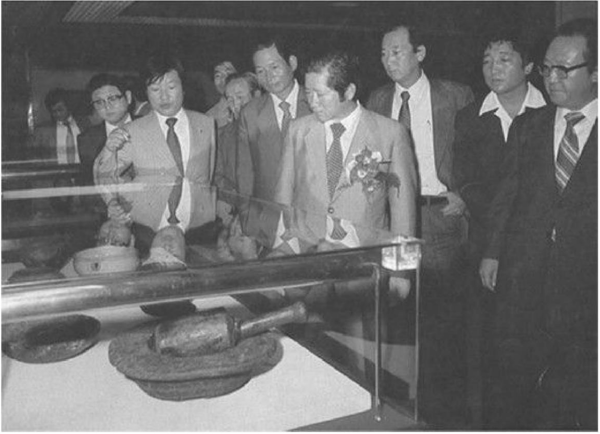
Suh Seong Hwan at the opening of the Pacific Cosmetics Museum in 1979.
In 2009 the museum changed its name to Amorepacific Museum of Art (APMA) and showcases modern and contemporary art rather than cosmetics, although the website states that "it is an institution dedicated to the antiques and artifacts of cosmetics culture in Korea, as well as making a meaningful contribution to local community and education." I really can't tell whether makeup is actually on display there. Ditto for the Pola Museum – while it was established by a cosmetics company president in 1976 and has some makeup on display for special exhibitions, I believe the museum focuses mostly on the founder's personal art collection. So I don't know if either of those really qualify as makeup museums now, but they were at least started that way.
Going back to the U.S., in 1984 the Max Factor Makeup Museum opened in Max Factor's former studio at 1666 N. Highland Avenue in Hollywood, CA. Overseen by Bob Salvatore, a 23-year employee of Max Factor, the museum offered a veritable treasure trove of Max Factor objects and memorabilia. From then it's not clear what exactly happened. Some articles state that the museum closed in 1992, some say 1996; I'm leaning towards 1996 as there are articles from 1995 advertising the museum at that location. In any case, a portion of the collection ended up at the Hollywood Entertainment Museum, which opened in October 1996 and was located at 7021 Hollywood Blvd. The collection remained there until 2004, when it landed at its original location, the old Max Factor studio. The famed Art Deco building had been turned into the Hollywood Museum in the summer of 2003. The Max Factor collection is still there so you can visit (well, maybe if the pandemic ever ends!)

(image from thehollywoodmuseum.com)
During this time, Shiseido opened their corporate museum in Japan as a way to celebrate the company's 120th anniversary in 1992. I've written about this one before so I won't rehash it, but you can check out my post. A decade later, in 2002, an Alabama paper reported on the Avon Fan Club House of one Mira Dawson. Ms. Dawson was a top seller and avid collector of Avon memorabilia, even dressing like one of the company's co-founders to greet visitors. She charged $2 for admission to her home, which functioned as the museum. Here's to home-based museums!!
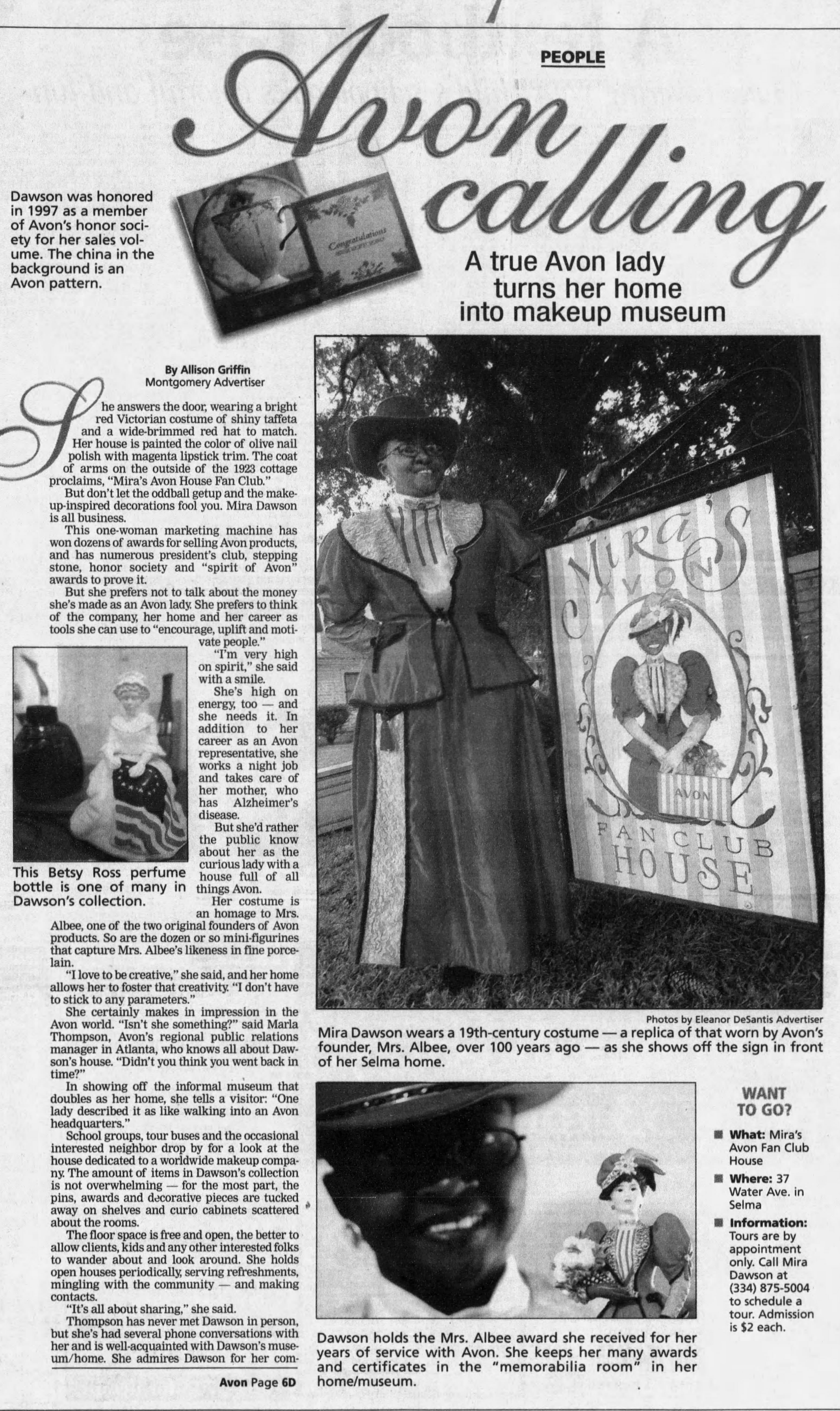
A year later, in November 2003 the Coreana Cosmetics Museum opened in Seoul. This was another one started by the company president; however, like the Pacific Cosmetics Museum, it seems to be far less profit-driven than the House of Cosmetics. The Coreana Cosmetics Museum showcases over 5,300 objects from all eras and seems to have curators and historians working there rather than relying on company salespeople.
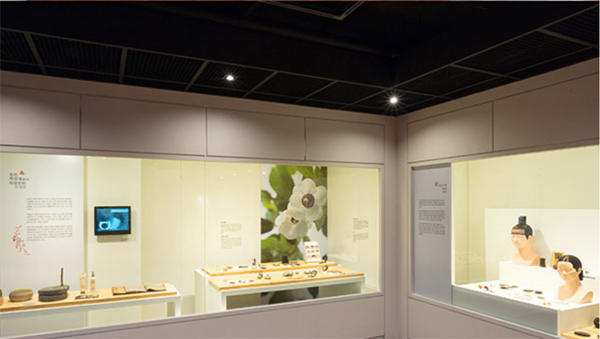
(image from spacec.co.kr)
Just a few years later, in 2006 the Beni Museum was established in Tokyo. I've posted about that previously too so I won't go into it again, but you should really check it out as it's fabulous. So that takes us to late 2007, when I registered the domain for the Makeup Museum. Interestingly, on Instagram I got to chatting with the previous owner of the domain! Oldschoolcosmetics had the idea of a makeup museum all the way back in the '70s and registered the domain around 1995, but realized how difficult it was and ended up walking away from makeup entirely. Here's what she had to say: "I first had the idea for a cosmetics museum in the 70s when I became really aware of makeup, brands and how quickly things disappeared from shelves. My dad had a museum background and my parents took me to museums on every vacation. I started to think seriously about it in the 90s and registered the domain then. There were no odd or new domains then, just .com, .org and .net. I don’t recall if I registered .com or .org or both, but definitely not .net. At the time there was a Max Factor exhibit in the LA area, and at least two active makeup schools there which specialized in special effects and Hollywood film work. I wasn’t as interested in that, but it became obvious that the industry was based in NY and LA, rent would be prohibitive, the industry giants could set up a museum faster than I could, would definitely do so after I started up, anything on display could be permanently ruined if there was a blackout or A/C malfunction, and the bulk of the work would be grant writing, networking and managerial. I abandoned the idea fairly quickly. Ignoring all other beauty like wigs, nails, skincare, fragrance, there was still too much for one building if you showed stage makeup, drag history, failed brands, etc. Back then there were less collabs, less brands, less releases a year, the world wide web was just starting and everything was still paper catalogs, in store displays, etc. Now a museum would have to cover cancel culture, influencers, indie brands, brand owners, many more foreign brands, etc. I used the domain for a private message board about makeup. I wanted to call it makeup mavens but someone had that name and a brand that used it. This was circa 1995? Eventually I got bored with the industry, the sheeple customers, products that disappointed, etc."
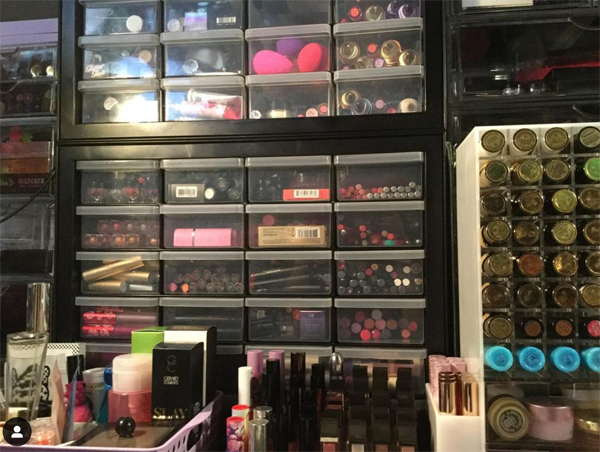
(image from @oldschoolcosmetics)
So it was kind of a downer to hear, but that sort of brutal honesty is needed at times, plus it shows I'm not a total failure – it's basically impossible to open a cosmetics museum without any investors or industry connections, or unless you're independently wealthy. In any case, this person is enthusiastic about makeup again and supports the Makeup Museum. She has been extremely kind in talking with me about the challenges of opening a physical space and digitizing the collection, particularly as they relate to funding sources. She has given me quite a few excellent suggestions so hopefully I'll be able to pursue them. Anyway, in August of 2008 I wrote my first blog post, so I usually consider that to be the Museum's official birthday.
A little bit after the Makeup Museum was established, makeup artist René Koch opened his private collection of lipstick in Berlin to the public in 2009, naturally called the Lipstick Museum. This is still on my must-see list! Known as "Mr. Lipstick", Koch was the head makeup artist for YSL for over 20 years and has amassed a spectacular collection of lipsticks and related memorabilia.
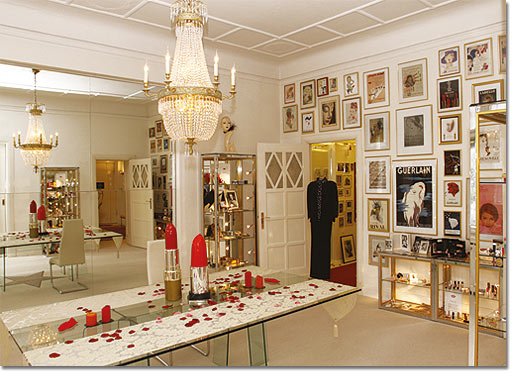
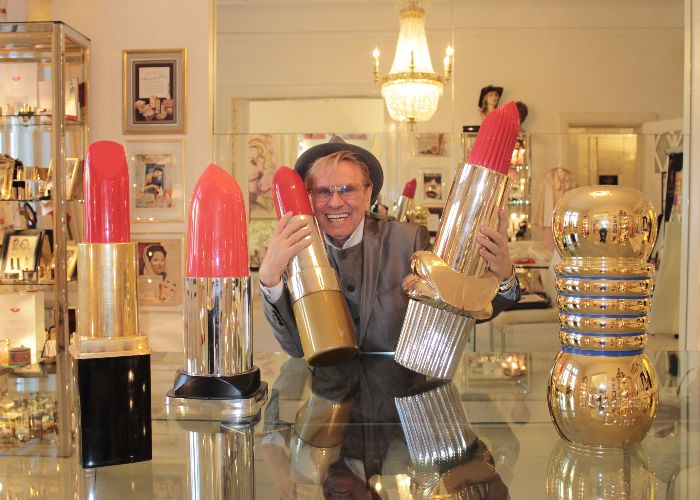
(images from lippenstiftmuseum.de)
Finally, we have the London Cosmetics Museum, founded by makeup artist Xabier Celaya in 2015. Like the Makeup Museum, it's an online-only pursuit for now. However, Xabier exhibits his collection at local universities, stores and cosmetology schools, and I'd be very surprised if he doesn't have a public physical space shortly.
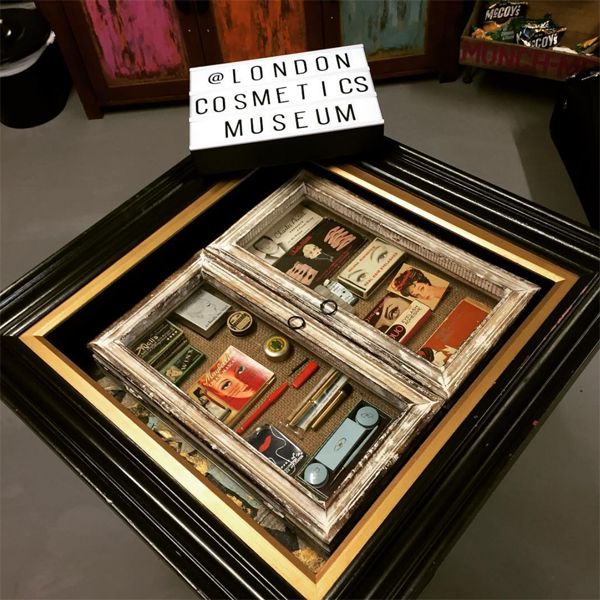
(image from @londoncosmeticsmuseum)
All of this goes to show there's been an interest for many years in exhibiting and preserving makeup history and beauty culture. I certainly was not the first one to have the idea of a cosmetics museum, nor will I be the last – I know of several makeup artists who are actively trying to open their own spaces. However, if they follow in the footsteps of a certain other entity and claim to be the first, well, you know it's a lie. 😉
Thoughts?
*There was a museum started by the president of Merle Norman Cosmetics in 1972, but I believe it was just a private collection of his cars and other non-makeup objects.








 (images from archive.vogue.com)
(images from archive.vogue.com)





















































